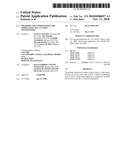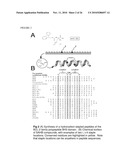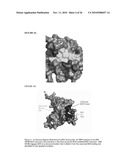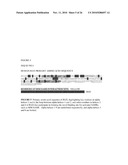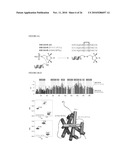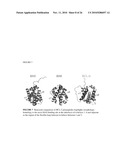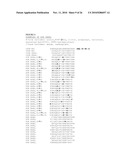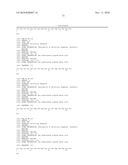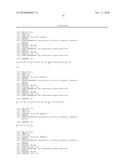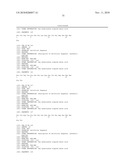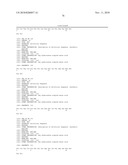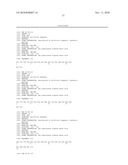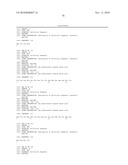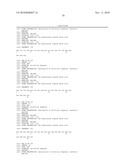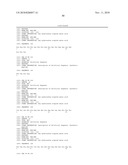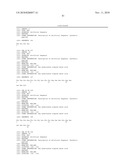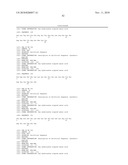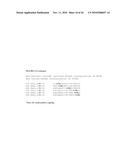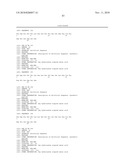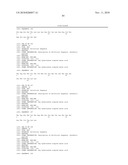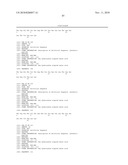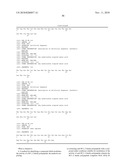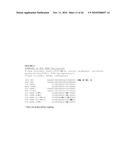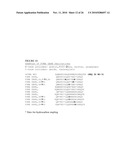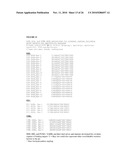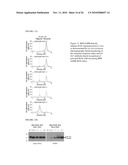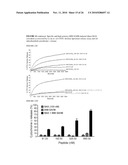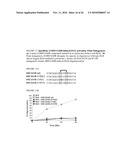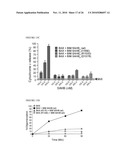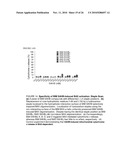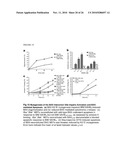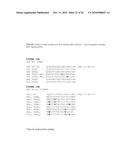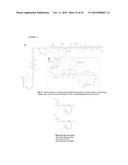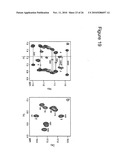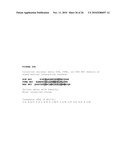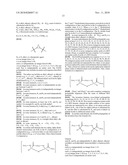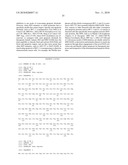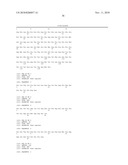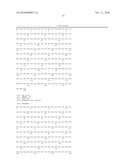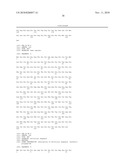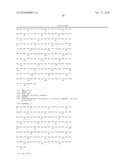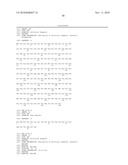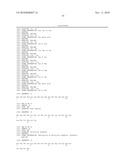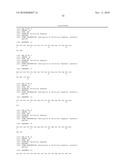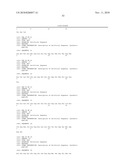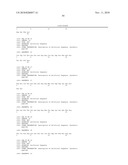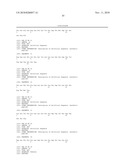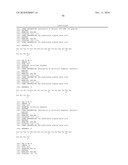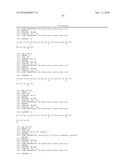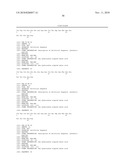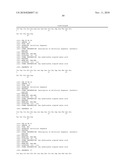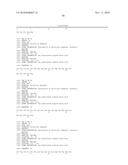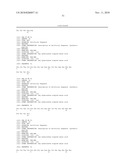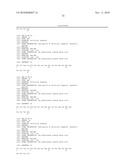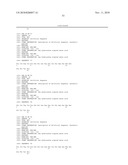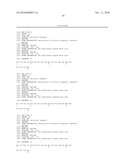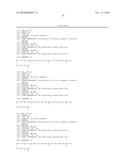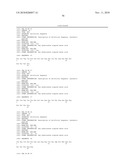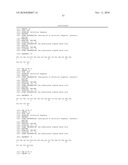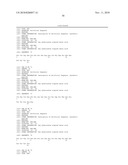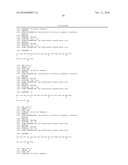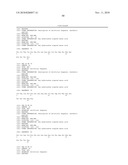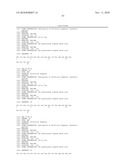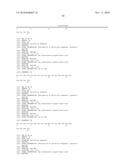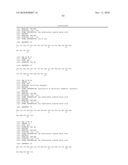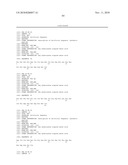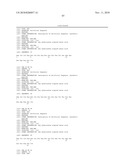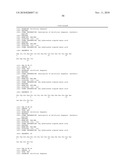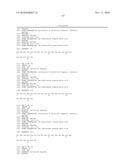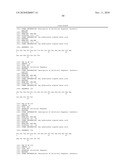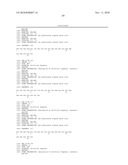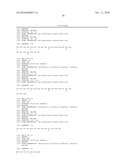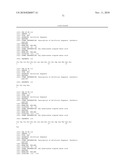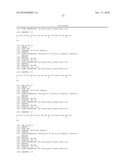Patent application title: METHODS AND COMPOSITIONS FOR MODULATING BCL-2 FAMILY POLYPEPTIDES
Inventors:
Loren D. Walensky (Chestnut Hill, MA, US)
Loren D. Walensky (Chestnut Hill, MA, US)
Nico Tjandra (Rockville, MD, US)
Evripidis Gavathiotis (Quincy, MA, US)
Motoshi Suzuki (Rockville, MD, US)
Gregory H. Bird (Pelham, NH, US)
Assignees:
DANA-FARBER CANCER INSTITUTE
NATIONAL INSTITUTES OF HEALTH
IPC8 Class: AA61P4300FI
USPC Class:
514 189
Class name: Designated organic active ingredient containing (doai) peptide (e.g., protein, etc.) containing doai apoptosis affecting
Publication date: 2010-11-11
Patent application number: 20100286057
based, at least in part, on the identification of
a novel active site on BCL-2 family polypeptide such as BAX, which when
bound by a compound, modifies the activity of the BCL-2 family
polypeptide.Claims:
1. A method for identifying a compound which modulates the activity of a
BCL-2 family polypeptide, the method comprising:a) contacting said BCL-2
family polypeptide with a compound under conditions suitable for
modulation of the activity of said BCL-2 family polypeptide wherein the
BCL-2 family polypeptide comprises BAX (SEQ ID NO: 1) and the compound
interacts with one or more amino acid residues selected from the group
consisting of Ala 24, Met 20, Leu 141, Met 137, Lys 21, Arg 134, Asp 142,
Leu 27, Ile31, Ile 133, Glu 17, Gln 28, Gln 32, Gln 52 and Arg 145 of SEQ
ID NO:1; andb) detecting modulation of the activity of said BCL-2 family
polypeptide by the compound,wherein the compound interacts with an active
site in said BCL-2 family polypeptide.
2-16. (canceled)
17. The method of claim 1, wherein said active site comprises alpha helix 1 and alpha helix 6 of BAX.
18. The method of claim 17, wherein the active site further includes amino acid residues from the α1-.alpha.2 loop and helix 4 of BAX.
19-21. (canceled)
22. The method of claim 1, wherein said compound interacts with amino acid residues corresponding to Met20, Lys21, Ala24, Gln28, Gln32, Glu131, Arg134, Met137, Leu141, Asp142 of SEQ ID NO:1.
23-42. (canceled)
43. The method of claim 1, wherein said method employs a cell transfected with a nucleic acid encoding a BCL-1 family polypeptide.
44-45. (canceled)
46. A method for identifying a candidate compound which activates a BAX polypeptide pro-apoptotic activity, the method comprising:a. providing a three dimensional structure of an active site of a BAX polypeptide;b. simulating a binding interaction between said active site and a compound; and determining whether said compound interacts with an amino acid residue selected from the group consisting of, Glu17, Met20, Lys21, Thr22, Ala24, Leu25, Leu27, Gln28, Gly29, Ile31, Gln 32, Asp33, Leu47, Asp48, Pro49, Val50, Pro51, Gln52, Asp53, Thr56, Arg89, Phe92, Phe93, Pro130, Glu131, Ile 133, Arg 134, Thr135, Met137, Gly138, Trp139, Leu141, Asp142, Phe143, Arg145, Glu146, Arg147 of SEQ ID NO:1 of said active site, wherein said compound which binds to said amino acid residue of the active site is said candidate compound.
47-95. (canceled)
96. A method of treating a disorder by modulating a BCL-2 family polypeptide with a compound that binds to an active site of said BCL-2 family polypeptide, wherein the disorder is a disorder of aberrant cellular proliferation or apoptotic blockade, and the compound comprises a polypeptide selected from the group consisting of:a polypeptide comprising an amino acid sequence which is 40% or more identical with SEQ ID NO:3, and comprises amino acid residues corresponding to Leu152 and Asp157 of SEQ ID NO:9, or a conservative substitution thereof;a polypeptide comprising an amino acid sequence comprising residues Ile148, Ala149, L152, Arg153, Arg154, Ile155, Gly156, Asp157, Glu158, Asn160, Ala161, Tyr163 of SEQ ID NO:3, or conservative substitutions thereof;a polypeptide comprising an amino acid sequence which is 40% identical to SEQ ID NO:3 and comprises amino acid residues corresponding to Leu 92, Gly 96 and Asp 97 of SEQ ID NO:9 or conservative substitutions thereof;a polypeptide comprising an amino acid sequence which is 40% identical to SEQ ID NO:4 and comprises amino acid residues corresponding to Leu 90, Gly 94 and Asp 95 of SEQ ID NO:6 or conservative substitutions thereof.a polypeptide comprising an amino acid sequence which is 40% identical to SEQ ID NO:5 and comprises amino acid residues corresponding to Leu 141, Ala 145 and Asp 146 of SEQ ID NO:7 or conservative substitutions thereof;a polypeptide comprising an amino acid sequence which is 40% identical to SEQ ID NO:12 and comprises amino acid residues corresponding to Leu63, Gly67, and Asp68 of SEQ ID NO:1 or conservative substitutions thereof.a polypeptide comprising an amino acid sequence of SEQ ID NO: 13;a polypeptide comprising an amino acid sequence of a BIM region from a protein selected from Bid, Bad, Bik/Nbk, Blk, Hrk, Bim/Bod, Bnip3, Nix, Noxa, Puma, Bmf and Egl-1;a polypeptide sequence from a protein selected from the group consisting of BCL-2, Bcl-Xl, Bcl-w, Mcl-1, BCL-B, A1/BFL-1, BOO/DIVA, Nr-13, CED-9, BAX, BAK and BOK; anda polypeptide sequence provided in one of FIG. 8, 9, 10, 11, 12, 16a, 16b, or 20.
97-134. (canceled)
135. The method of claim 96, wherein said compound binds to said active site with an affinity of <1 mM.
136-140. (canceled)
141. A compound that modulates the activity of a BCL-2 family polypeptide and binds an active site of said BCL-2 family polypeptide, wherein the compound comprises a polypeptide selected from the group consisting of:a polypeptide comprising an amino acid sequence which is 40% or more identical with SEQ ID NO:3, and comprises amino acid residues corresponding to Leu152 and Asp157 of SEQ ID NO:9, or a conservative substitution thereof;a polypeptide comprising an amino acid sequence comprising residues Ile148, Ala149, L152, Arg153, Arg154, Ile155, Gly156, Asp157, Glu158, Asn160, Ala161, Tyr163 of SEQ ID NO:3, or conservative substitutions thereof;a polypeptide comprising an amino acid sequence which is 40% identical to SEQ ID NO:3 and comprises amino acid residues corresponding to Leu 92, Gly 96 and Asp 97 of SEQ ID NO:9 or conservative substitutions thereof;a polypeptide comprising an amino acid sequence which is 40% identical to SEQ ID NO:4 and comprises amino acid residues corresponding to Leu 90, Gly 94 and Asp 95 of SEQ ID NO:6 or conservative substitutions thereof.a polypeptide comprising an amino acid sequence which is 40% identical to SEQ ID NO:5 and comprises amino acid residues corresponding to Leu 141, Ala 145 and Asp 146 of SEQ ID NO:7 or conservative substitutions thereof;a polypeptide comprising an amino acid sequence which is 40% identical to SEQ ID NO:12 and comprises amino acid residues corresponding to Leu63, Gly67, and Asp68 of SEQ ID NO:1 or conservative substitutions thereof.a polypeptide comprising an amino acid sequence of SEQ ID NO: 13;a polypeptide comprising an amino acid sequence of a BIM region from a protein selected from Bid, Bad, Bik/Nbk, Blk, Hrk, Bim/Bod, Bnip3, Nix, Noxa, Puma, Bmf and Egl-1;a polypeptide sequence from a protein selected from the group consisting of BCL-2, Bcl-Xl, Bcl-w, Mcl-1, BCL-B, A1/BFL-1, BOO/DIVA, Nr-13, CED-9, BAX, BAK and BOK; anda polypeptide sequence provided in one of FIG. 8, 9, 10, 11, 12, 16a, 16b, or 20
142-148. (canceled)
149. The compound of claim 141, wherein said active site comprises alpha helix 1 and alpha helix 6 of BAX.
150. The compound of claim 149, wherein the active site further includes amino acid residues from the α1-.alpha.2 loop and helix 4 of BAX.
151-153. (canceled)
154. The compound of claim 141, wherein said compound interacts with amino acid residues corresponding to Met20, Lys21, Ala24, Gln28, Gln32, Glu131, Arg134, Met137, Leu141, Asp142 of SEQ ID NO:1.
158-169. (canceled)
170. The compound of claim 141, wherein said compound binds to said active site with an affinity of <1 mM.
171-183. (canceled)
184. The compound of claim 141, comprising a BH3 SAHB polypeptide having a paramagnetic label.
185. A method of treating a disorder in a subject, comprising administering to said subject in need thereof, an effective amount of a compound of claim 141, and a BAX α-helix 9 SAHB polypeptide (SEQ ID NO:14), such that said subject is treated for said disorder.
186. The method of claim 185, wherein said BAX α-helix 9 SAHB polypeptide comprises an amino acid sequence of FIG. 16b, or contains conservative substitutions thereof.
187. A kit comprising a compound of claim 141 and instructions for use.
188. The compound of claim 141, comprising a polypeptide comprising the amino acid consensus sequence of SEQ ID NO:13.
189. The polypeptide of claim 188, wherein said polypeptide is hydrocarbon stapled.
190. (canceled)Description:
RELATED APPLICATIONS
[0001]This application claims the benefit of U.S. Provisional Application Nos. 60/995,545, filed on Sep. 26, 2007 and 61/124,221, filed on Apr. 14, 2008. The entire teachings of the above applications are incorporated herein by reference.
STATEMENT OF U.S. GOVERNMENT INTEREST
[0002]Funding for the present invention was provided in part by support from the Intramural Research Program of the National Heart Lung and Blood Institute, a component of the U.S. National Institutes of Health. Accordingly, the Government of the United States may have certain rights in and to the invention.
BACKGROUND
[0003]BCL-2 family protein interactions regulate apoptosis, an orchestrated set of events designed to rid the body of damaged or unwanted cells, and a process critical for normal development and organism homeostasis (Adams, J. M., and Cory, S. (1998), Science 281, 1322-1326; Danial, N. N., and Korsmeyer, S. J. (2004), Cell 116, 205-219). Whereas multidomain anti-apoptotic proteins such as BCL-2 guard against cell death, multidomain pro-apoptotic proteins such as BAX constitute a gateway to cell death through mitochondrial damage. Multidomain apoptotic proteins display sequence conservation in up to four BCL-2 homology (BH) domains, yet the "BH3-only" subset of pro-apoptotic proteins displays homology only to the third BH domain. The BH3-only proteins function as death sentinels situated throughout the cell, poised to transmit signals of cell injury to multidomain members. Depending on the nature of apoptotic stimuli and cellular context, the BH3-only protein's death signal will either be neutralized by anti-apoptotic proteins or delivered, directly or indirectly, to the mitochondrial executioners BAX and BAK. When activated, these pro-apoptotic multidomain members induce permeabilization of the outer mitochondrial membrane, enabling released mitochondrial factors to activate caspases, which irreversibly execute the death program (Green, D. R. (2005). Cell 121, 671-674).
[0004]Structural studies have demonstrated the insertion of BH3 ligands into the hydrophobic groove formed by the juxtaposition of BH1, BH2 and BH3 domains of anti-apoptotic multidomain members (Day, C. L., et al. (2005), J Biol Chem 280, 4738-4744; Denisov, A. Y., (2003), J Biol Chem 278, 21124-21128; Liu, X., et al. (2003), Immunity 19, 341-352). Recent work has uncovered the binding specificities of BH3-only members for their anti-apoptotic partners and the structural basis for these selectivities (Certo, M., Moore, et. Al. (2006), Cancer Cell 9, 351-365.; Chen, L., et al. (2005); Mol Cell 17, 393-403). BH3-only proteins antagonize anti-apoptotic proteins through these direct interactions, and thereby decreases anti-apoptotic inhibition of BAX/BAK and/or competitively displace bound BH3-only members that are capable of direct activation of BAX/BAK. BH3-only proteins that exclusively engage anti-apoptotic proteins to exert their pro-apoptotic activity (e.g. BAD) have thus been termed "sensitizers"(Letai, A., et al. (2002), Cancer Cell 2, 183-192) or "derepressors" (Kuwana, T., et al. (2005)1 Mol Cell 17, 525-535). Recent yeast two-hybrid, immunoprecipitation, and biochemical studies support a role for select BH3-only members, including BID and BIM, in direct activation of BAX. (Carton, P. F., et al. Mol Cell 16, 807-818 (2004); Harada, H., et al. PNAS USA 101, 15313-15317 (2004); Marani, M., et al. Mol Cell Biol 22, 3577-3589 (2002); Walensky, L. D., et al. Mol Cell 24, 199-210 (2006); Wang, K., et al. Genes Dev 10, 2859-2869. (1996). However, the inability to measure a direct binding affinity between the BH3 domain of these "activator" BH3-only proteins and native BAX protein, and the requirement of up to 50 micromolar dosing of activating BH3 peptides to trigger BAX activation in vitro (Kuwana, T., et al. (2005). Mol Cell 17, 525-535; Kuwana, T., et al. (2002). Cell 111, 331-342), have led to uncertainty about the existence of a BH3-mediated direct BAX/BAK activation pathway. In fact, the lack of binding and structural data to support such interactions has led to the hypothesis that the pro-apoptotic potency of presumed activator peptides, such as BIM BH3, may instead reflect their ability to effectively neutralize all anti-apoptotic proteins tested to date.
SUMMARY OF THE INVENTION
[0005]The present invention is directed to methods, kits and compositions for modulating the activity of BCL-2 family polypeptides (e.g., BAX) by targeting a new regulatory site on BCL-2 family proteins. The methods and compounds of the invention are useful for treating and/or preventing disorders characterized by the deregulation of one or more polypeptides of the BCL-2 family, including conditions of premature cell death (e.g. diabetes, neurodegenerative disease, heart attach, stroke), or pathologic cell survival (e.g. autoimmune disease, cancer). Further, the methods and compounds of the present invention are also useful in the treatment of non-BCL-2 related disorders associated with excessive cellular proliferation or excessive cellular death (e.g., apoptosis). The present invention is based, at least in part, on the identification of a novel active site on a BCL-2 family polypeptide such as BAX, which when bound by a compound, modifies the apoptotic activity of the BCL-2 family polypeptide.
[0006]In a first aspect, the invention is directed to a method for identifying a compound which modulates the activity of a BCL-2 family polypeptide. The method includes contacting a BCL-2 family polypeptide with a compound which binds to an active site in the polypeptide and detecting a modulated activity of the polypeptide, thereby identifying a BCL-2 family polypeptide modulator.
[0007]In a further aspect, the invention is directed to a method for identifying a compound which activates or inhibits the apoptotic activity of a BCL-2 family polypeptide, such as BAX. The method includes, for example, contacting the BAX polypeptide with a compound which modulates (e.g., activates) BAX when bound to one or more of amino acid residues including Glu17, Met20, Lys21, Thr22, Ala24, Leu25, Leu27, Gln28, Gly29, Ile31, Gln 32, Asp 33, Leu47, Asp48, Pro49, Val50, Pro51, Gln52, Asp53, Thr56, Arg89, Phe92, Phe93, Pro130, Glu131, Ile 133, Arg 134, Thr135, Met137, Gly138, Trp139, Leu141, Asp142, Phe143, Arg145, Glu146, Arg 147 of a BAX active site, and detecting activation or inhibition of the biological activity of BAX, thereby identifying a BAX activator or inhibitor.
[0008]In yet another aspect, the invention is directed to a method for identifying a candidate modulator of a BCL-2 family polypeptide. The method entail using a three dimensional structure (e.g., interaction template) of an active site of the BCL-2 family polypeptide, and employing the three dimensional structure to select a BCL-2 family polypeptide candidate modulator from a group of compounds. A compound is identified as a candidate modulator when it binds to the active site of the BCL-2 family polypeptide.
[0009]In a further aspect, the invention is directed to a method for identifying a candidate compound which activates or inhibits the apoptotic activity of a BCL-2 family polypeptide, such as BAX. For example, the method includes: providing a three dimensional structure of an active site of the BAX polypeptide, simulating a binding interaction between the active site and a compound; and determining whether the compound binds to one or more BAX residues including Glu17, Met20, Lys21, Thr22, Ala24, Leu25, Leu27, Gln28, Gly29, Ile31, Gln 32, Asp33, Leu47, Asp48, Pro49, Val50, Pro51, Gln52, Asp53, Thr56, Arg89, Phe92, Phe93, Pro130, Glu131, Ile 133, Arg 134, Thr135, Met137, Gly138, Trp139, Leu141, Asp142, Phe143, Arg145, Glu146, Arg 147 of the active site. A compound is identified as a candidate compound when it is capable of binding to one or more of the amino acid residues of the active site.
[0010]In yet another aspect, the present invention is directed to a method for treating or preventing a BCL-2 related disorder in an individual. The method involves administering to an individual in need thereof, a pharmacologically effective dose of a compound that binds to an active site of the BCL-2 family polypeptide to either activate or inhibit its apoptotic or other disease-related activity.
[0011]In yet a further embodiment, the invention is directed to a method of treating or preventing a disorder of deregulated apoptosis (e.g., hyperpoliferative disorder, diabetes) in an individual, by activating or inhibiting the apoptotic activity of a BAX polypeptide. The method entails administering to an individual in need thereof, a pharmacologically effective dose of a BH3 polypeptide, or chemical mimetic thereof, which binds to one or more amino acid residues including Glu17, Met20, Lys21, Thr22, Ala24, Leu25, Leu27, Gln28, Gly29, Ile31, Gln 32, Asp33, Leu47, Asp48, Pro49, Val50, Pro51, Gln52, Asp53, Thr56, Arg89, Phe92, Phe93, Pro130, Glu131, Ile 133, Arg 134, Thr135, Met137, Gly138, Trp139, Leu141, Asp142, Phe143, Arg145, Glu146, Arg 147 of the active site of BAX so as to activate or inhibit the apoptotic activity of the BAX polypeptide.
[0012]In another aspect, the invention is directed to a compound for treating or preventing a BCL-2 related disorder in an individual. The compound modulates the activity of a BCL-2 family polypeptide when bound to an active site of the BCL-2 family polypeptide.
[0013]In a further aspect, the invention is directed to a compound for treating or preventing a disorder of deregulated apoptosis (e.g., hyperpoliferative disorder, diabetes) in an individual. The compound is a BH3 polypeptide or chemical mimetic thereof that activates or inhibits the pro-apoptotic activity of a BAX polypeptide when bound to one or more amino acid residues including Glu17, Met20, Lys21, Thr22, Ala24, Leu25, Leu27, Gln28, Gly29, Ile31, Gln 32, Asp33, Leu47, Asp48, Pro49, Val50, Pro51, Gln52, Asp53, Thr56, Arg89, Phe92, Phe93, Pro130, Glu131, Ile 133, Arg 134, Thr135, Met137, Gly138, Trp139, Leu141, Asp142, Phe143, Arg145, Glu146, Arg147 of SEQ ID NO:1.
[0014]In yet another aspect, the invention is directed to a composition having a BIM BH3 polypeptide having the amino acid sequence represented in FIG. 8. In yet another aspect, the invention is directed to a composition having a BIM BH3 polypeptide having an amino acid sequence which is at least 40% identical to that of SEQ ID NO:3 and which includes interacting residues Ile148, Ala149, L152, Arg153, Arg154, Ile155, Gly156, Asp157, Glu158, Asn160, Ala161, Tyr163, or conserved amino acid substitutions thereof. In yet another aspect, the invention is directed to a composition having 40% identity to alternative BH3 polypeptides that bind the active site on BAX, such as the BH3 domains of BID, PUMA, and/or BAX.
[0015]In another aspect, the invention is directed to using the sequence and three dimensional structure of the BAX activation site to identify homologous regulatory sites in the other BCL-2 family members. For example, based upon three dimensional structural similarities or alignment of polypeptide sequences, regions homologous to the BAX activation site would be identified and then tested for the capacity of an interacting compound to modulate the apoptotic activity the BCL-2 polypeptides.
[0016]In another aspect, the invention is directed to a BH3 SAHB polypeptide that includes one or more crosslinkable moieties and methods of use thereof. For example, the crosslinkable BH3 SAHBs can be used in methods for identifying an active site on a target polypeptide. The method includes incubating the target polypeptide with a BH3 SAHB polypeptide comprising a covalent crosslinkable moiety, crosslinking the BH3 SAHB polypeptide to the target polypeptide, and identifying the intercalation site of the BH3 SAHB polypeptide to the target polypeptide.
[0017]In still another aspect, the invention is directed to kits containing any of the above compounds and instructions for use.
BRIEF DESCRIPTION OF THE DRAWINGS
[0018]FIG. 1 illustrates several of the BCL-2 family polypeptides involved in the regulation of apoptosis and their conserved BCL-2 homology (BH) domains.
[0019]FIG. 2 illustrates the amino acid sequence and alignment of the BH3 domains of numerous BCL-2 family polypeptides.
[0020]FIG. 3a is a ribbon diagram representing the BAX structure showing the helices α1-α9. The C.sup.α atoms of BAX residues affected by BIM SAHB binding are shown as grey spheres. The view on the right panel is a 180° rotation from that on the left panel, showing that the residues affected by BIM SAHB are mostly on the one side of the protein structure. All ribbon diagrams of the protein structure were produced using MOLMOL. FIG. 3b documents the chemical shift changes of backbone amides in 15N-labeled BAX upon BIM SAHB titration. Chemical shift changes are plotted as a function of the residue number of BAX. Residues with significant backbone amide chemical shift change (>0.01 ppm) are colored orange.
[0021]FIG. 4 (a) Surface diagram illustrating the BAX binding site. Solvent exposed residues at the binding site are indicated. Yellow shading designates the sidechains of the hydrophobic residues M20, A24, L27, I31, I133, M137, and L141. Red and blue shading designate the sidechains of positively (K21, R134) and the negatively charged residue (E131) respectively. Green shading designates sidechains of the hydrophilic residues (Q28, Q32). (b) NMR analysis of the BIM SAHB-BAX interaction demonstrates a new binding site for BH3-mediated BAX activation. BIM SAHB engages BAX at a structural location that is distinct from the canonical BH3 binding site identified for anti-apoptotic proteins.
[0022]FIG. 5 illustrates one embodiment of the full-length BAX amino acid sequence illustrating residues that comprise the BIM SAHB interaction site (highlighted in yellow) and additional residues (highlighted in red) that are affected by conformational changes and/or other interactions upon BIM SAHB binding.
[0023]FIG. 6 Orientation of BIM SAHB at the novel BAX binding site. (a) BIM SAHB was mutated to position a cysteine residue at either the N- or C-terminus of the peptide and paramagnetically-labeled derivatives generated by reacting the installed thiol group with MTSL to incorporate a nitroxide spin label. (b) A ratio plot of BAX crosspeak intensity ratios (BIM SAHB.sub.W147C-MTSL[Iox/Ired]/BIM SAHBA164C-MTSL[Iox/Ired]) versus residue number highlights BAX residues maximally impacted by the respective MTSL labels. (c) Correlation spectra demonstrate that BAX α1 residues (e.g. Ser16) are primarily affected in PRE experiments that compare oxidized (red) and reduced (black) forms of BIM SAHB.sub.(A164C-MTSL) (top panel) whereas BAX α6 residues (e.g. D142) are impacted in the corresponding BIM SAHB.sub.(W147C-MTSL) studies (bottom panel). (d) The calculated structure generated using the PRE-derived intermolecular distances from both MTSL incorporation sites converged to orient BIM SAHB approximately 90 degrees relative to α-helices 1 and 6, with the N- to C-terminus directionality disposed right to left. (e) Calculated structure of the complex between the novel interaction site on BAX and BIM BH3.
[0024]FIG. 7 illustrates the α1 and α6 domains of BAX, BAK and BCL-w.
[0025]FIG. 8 illustrates numerous BIM SAHB polypeptides.
[0026]FIG. 9 illustrates numerous BID SAHB polypeptides.
[0027]FIG. 10 illustrates numerous PUMA SAHB polypeptides.
[0028]FIG. 11 illustrates numerous BIM, BID and PUMA SAHB derivatives that can be used in crosslinking assays. U=Bpa but can represent any other known crosslinkable moieties.
[0029]FIG. 12 BIM SAHB directly initiates BAX oligomerization in vitro and triggers the functional release activity of BAX. (a) Treatment of monomeric BAX with BIM SAHB at the indicated ratios induced dose-responsive BAX oligomerization as reflected by size exclusion chromatography-based monitoring of the monomer-oligomer states after 15 minutes incubation at room temperature. (b) BIM SAHB-BAX mixtures at the corresponding ratios were incubated with 6A7 antibody followed by immunoprecipitation to assess ligand-induced exposure of the BAX N-terminal epitope (residues 12-24), a reflection of the conformational change in BAX observed upon activation. The quantity of immunoprecipitated BAX increased in accordance with the BIM SAHB-BAX ratio. Specific and high potency functional activation of BAX by BIM SAHB is further demonstrated by (c) an in vitro FITC-dextran liposomal release assay and (d) mitochondrial cytochrome c release.
[0030]FIG. 13 Specificity of BIM SAHB-induced BAX activation: point mutagenesis. (a) A panel of BIM SAHB compounds mutated at its interaction surface with BAX. Point mutagenesis of BIM SAHB abrogates its capacity to (b) oligomerize wild-type BAX and (c) trigger BAX-mediated cytochrome c release. (d) BAX K21E and R134E mutagenesis impairs BIM SAHB-induced BAX oligomerization.
[0031]FIG. 14 Specificity of BIM SAHB-induced BAX activation: Staple Scan. A panel of BIM SAHB compounds with differential i, i+4 staple positions is used to demonstrate that only a staple that localizes to the hydrophobic interaction surface of BIM SAHB disrupts BAX oligomerization and BAX-mediated cytochrome c release. Selectivity is also underscored by the inability of BAD SAHBA, despite having the identical staple position as BIM SAHBA, to activate BAX.
[0032]FIG. 15 illustrates that mutagenesis of the BAX interaction site impairs BAX oligomerization (a), BAX-mediated cytochrome c release (b), and both BIM SAHB- and staurosporine-induced apoptosis of BAX-reconstituted Bax.sup.-/-Bak-/- mouse embryo fibroblasts.
[0033]FIG. 16 illustrates examples of (a) BAX BH3 SAHBs and (b) BAX helix 9 SAHBs.
[0034]FIG. 17 depicts the chemical design of polyfunctional SAHB compounds for covalent capture of physiologic targets.
[0035]FIG. 18 illustrates SAHBs derivatized with a photolabile (a) carbene generating functionality (a) photolabile nitrene generating functionality.
[0036]FIG. 19 NMR chemical shift changes of BAX side chains upon binding to BIM SAHB. The spectra of BAX are colored red and blue in the absence and presence of equimolar BIM SAHB, respectively. (a) A subset of the 1H-15N HSQC spectra showing cross peaks for the NH2 side chains of Glutamines. Significant differences can be observed for Gln28, Gln32, and Gln52. (b) A region of C.sub.γ2 methyl group of Isoleucines of the 1H-13C CT-HSQC spectra. Noticeable changes are found for Ile31-C.sup.γ2-H3 and Ile133-C.sup.γ2-H3.
[0037]FIG. 20(a) illustrates the amino acid sequence and highlights highly conserved amino acids among the BH3 regions of BCL-2 family polypeptides, such as BIM, BID, PUMA, BAX, and BCL-2, including identification of a (b) consensus sequence in BIM BH3, PUMA BH3, and BAX BH3 domains for binding the novel BAX interaction site.
DETAILED DESCRIPTION
I. Definitions
[0038]As used herein, the term, "BCL-2 family polypeptide" refers to an evolutionary conserved family of proteins having as few as one to as many as four conserved BCL-2 homology domains (BH1, BH2, BH3 and/or BH4). The BH domains are alpha-helical segments and are present in both the anti-apoptotic and pro-apoptotic polypeptides of the BCL-2 family. BCL-2 family polypeptides include BCL-2, BCL-Xl, BCL-w, MCL-1, BCL-B, A1/BFL-1, BOO/DIVA, Nr-13, CED-9, BAX, BAK, BOK/MTD, BID BAD, BIK/NBK, BLK HRK BIM/BOD, BNIP3, NIX, NOXA, PUMA, BMF AND EGL-1, and viral homologues.
[0039]The term "active site" refers to a region of a BCL-2 family polypeptide, as a result of its shape, amino acid content, and charge potential, that favorably interacts or associates with another agent (including, without limitation, a protein, polypeptide, peptide, molecule, compound, antibiotic or drug) via various covalent and/or non-covalent binding forces. The "active site" includes a hydrophobic patch and a perimeter of charged and hydrophilic residues capable of binding a stabilized alpha helix of BCL-2 domain, such as human hydrocarbon-stapled BIM BH3 (SEQ ID NO:3), and which is formed by the juxtaposition of alpha helices 1 and 6 of BAX. The active site may further include amino acid residues from the α1-α2 loop and helix 4 of BAX. In one embodiment, the active site includes two or more amino acids corresponding to Glu17, Met20, Lys21, Thr22, Ala24, Leu25, Leu27, Gln28, Gly29, Ile31, Gln 32, Asp33, Leu47, Asp48, Pro49, Val50, Pro51, Gln52, Asp53, Thr56, Arg89, Phe92, Phe93, Pro130, Glu131, Ile 133, Arg 134, Thr135, Met137, Gly138, Trp139, Leu141, Asp142, Phe143, Arg145, Glu146, Arg147 of SEQ ID NO:1.
[0040]The term "BCL-2 family polypeptide variant" refers to polypeptides that vary from a reference BCL-2 family polypeptide by the addition, deletion or substitution of at least one amino acid. It is well understood in the art that some amino acids may be changed to others with broadly similar properties without changing the nature of the activity of the polypeptide (conservative substitutions) as described hereinafter. Accordingly, BCL-2 family polypeptide variants as used herein encompass polypeptides that have pro- or anti-apoptotic activity. The term "variant" refers to a protein having at least 30% amino acid sequence identity with a reference BCL-2 homology domain within a protein or any other functional domain thereof. More specifically, the term "variant" includes, but is not limited to, a BCL-2 family polypeptide comprising an active site characterized by a three dimensional structure comprising the relative structural coordinates of at least two BAX amino acid residues corresponding to Glu17, Met20, Lys21, Thr22, Ala24, Leu25, Leu27, Gln28, Gly29, Ile31, Gln 32, Asp33, Leu47, Asp48, Pro49, Val50, Pro51, Gln52, Asp53, Thr56, Arg89, Phe92, Phe93, Pro130, Glu131, Ile 133, Arg 134, Thr135, Met137, Gly138, Trp139, Leu141, Asp142, Phe143, Arg145, Glu146, Arg147 of SEQ ID NO:1, in each case, +/-a root mean square deviation from the conserved backbone atoms of those residues of not more than 1.1 angstroms, more preferably not more than 1.0 angstroms, and most preferably not more than 0.5 angstroms.
[0041]A "BCL-2 family polypeptide variant" further includes those polypeptides, or their biologically active fragments, that comprise an amino acid sequence which is at least 30%, 40%, 50%, 60%, 70%, 80%, 90%, 95%, 96%, 97%, 98%, 99% or more similar to an amino acid sequence of a BCL-2 homology domain (e.g., BH3 domain). In a preferred embodiment, the BCL-2 homology domain comprises one or more conserved amino acid residue, such as amino acid residues corresponding to Leu 92, Gly 96 and Asp 97 of BIM (SEQ ID NO:2) or conservative substitutions thereof.
[0042]The term "hydrophobic patch" refers to the portion of the active site that binds a hydrophobic moiety. In one embodiment, the hydrophobic patch contains 1, 2, 3 or more hydrophobic amino acid residues. In one particular embodiment, the hydrophobic pocket contains amino acid residues corresponding to Ala 24, Met 20, Leu 25, Leu 27, Ile 31, Ile 133, Met 137, Gly 138, Trp 139, Leu 141 of SEQ ID NO:1.
[0043]The term "charged/hydrophilic perimeter" refers to the portion of the active site that binds a charged or hydrophilic moiety. In one embodiment, the charged/hydrophilic patch contains 1, 2, 3 or more charged or hydrophilic amino acid residues that surround the hydrophobic patch. In one particular embodiment, the charged/hydrophilic perimeter contains amino acid residues corresponding to Lys 21, Gln 28, Gln 32, Asp 33, Gln 52, Glu 17, Arg, 134, Thr 135, Asp 142, Arg 145, Arg 147 of SEQ ID NO:1.
[0044]The term "hydrophobic amino acid" means any natural or non-natural amino acid or mimetic thereof having an uncharged, non-polar side chain that is relatively insoluble in water. Examples of naturally occurring hydrophobic amino acids are alanine, leucine, isoleucine, valine, proline, phenylalanine, tryptophan and methionine.
[0045]The term "hydrophilic amino acid" means any natural or non-natural amino acid or mimetic thereof having an uncharged, polar side chain that is relatively soluble in water. Examples of naturally occurring hydrophilic amino acids are serine, threonine, tyrosine, asparagine, glutamine, and cysteine.
[0046]The term "negatively charged amino acid" includes any naturally occurring or unnatural amino acid or mimetic thereof having a negatively charged side chain under normal physiological conditions. Examples of negatively charged naturally occurring amino acids are aspartic acid and glutamic acid.
[0047]The term "positively charged amino acid" includes any naturally occurring or unnatural amino acid or mimetic thereof having a positively charged side chain under normal physiological conditions. Examples of positively charged naturally occurring amino acids are arginine, lysine and histidine.
[0048]The term "anti-apoptotic polypeptide" refers to BCL-2 family polypeptides characterized by having one or more amino acid homology domains, BH1, BH2, BH3, and/or BH4, and that promote cell survival by attenuating or inhibiting apoptosis. The "anti-apoptotic polypeptides" further include those proteins, or their biologically active fragments, that are at least 30%, 40%, 50%, 60%, 70%, 80%, 90%, 95%, 96%, 97%, 98%, 99% or more similar in amino acid sequence to an anti-apoptotic BCL-2 homology domain within a BCL-2 family polypeptide. In a preferred embodiment, the BCL-2 homology domain comprises one or more conserved amino acid residue, such as amino acid residues corresponding to Leu 97, Gly 101 and Asp 102 of Bcl-2 (SEQ ID NO:8): Anti-apoptotic polypeptides include BCL-2, BCL-Xl, BCL-w, MCL-1, BCL-B, A1/BFL-1, BOO/DIVA, Nr-13 or CED-9, and viral homologues.
[0049]The term "pro-apoptotic polypeptide" refers to BCL-2 family polypeptides characterized by having one or more amino acid homology domains, including BH1, BH2, and/or BH3, and that promote cell death by activating apoptosis. The "pro-apoptotic polypeptides" further include those proteins, or their biologically active fragments, that are at least 30%, 40%, 50%, 60%, 70%, 80%, 90%, 95%, 96%, 97%, 98%, 99% or more similar in amino acid sequence to a pro-apoptotic BCL-2 homology domain within a BCL-2 family polypeptide. Pro-apoptotic polypeptides can be identified as having one or more conserved amino acid residue, such as amino acid residues corresponding to Leu 92, Gly 96 and Asp 97 of BIM (SEQ ID NO: 2) or Leu 63, Ala 67 and Asp 68 of BIM (SEQ ID NO:1). Pro-apoptotic polypeptides include BAX, BAK, BOK/MTD, BID BAD, BIK/NBK, BLK HRK BIM/BOD, BNIP3, NIX, NOXA, PUMA, BMF AND EGL-1.
[0050]As used herein, the term "apoptosis" refers to a regulated network of biochemical events which lead to a selective form of cell death that is characterized by readily observable morphological and biochemical changes, such as the fragmentation of the deoxyribo-nucleic acid (DNA), condensation of the chromatin, which may or may not be associated with endonuclease activity, chromosome migration, margination in cell nuclei, the formation of apoptotic bodies, mitochondrial swelling, widening of the mitochondrial cristae, opening of the mitochondrial permeability transition pores and/or dissipation of the mitochondrial proton gradient.
[0051]The term "compound" is used herein to denote a chemical agent, polypeptide or combination thereof, or a mixture of chemical compounds and/or polypeptides and/or nucleic acids (e.g. DNA and/or RNA derivative), salts and solvates thereof, and the like. Preferably, a compound of the invention binds to the active site of a BCL-2 family polypeptide. A "modulator" is a compound which modulates the activity of a BCL-2 family polypeptide.
[0052]The term "candidate compound" is used herein to denote a chemical compound, polypeptide or combination thereof, or a mixture of chemical compounds and/or polypeptides and/or nucleic acids, salts and solvates thereof, and the like, which is tested by a method of the invention and is found to bind to active site of a BCL-2 family polypeptide, and thus is believed to modulate the activity of the BCL-2 family polypeptide.
[0053]The term "modulate" as used herein with reference to a compound refers to the activation or inhibition of anti-apoptotic or pro-apoptotic activity of a BCL-2 family polypeptide or other protein-protein interaction involving a BCL-2 family member that regulates a biochemical pathway (e.g. unfolded protein response, glucose-stimulated insulin secretion). Methods for assaying both anti-apoptotic, pro-apoptotic, and other biochemical activities (e.g. unfolded protein response, glucose-stimulated insulin secretion) are well known in the art and described herein.
[0054]As used herein, the term "interacts" or "binds" refers to a condition of proximity between a compound, or portions thereof, and the active site of a BCL-2 family polypeptide or portions thereof. The interaction is between one or more moieties on the compound and one or more moieties on amino acids of the active site. The association may be non-covalent--wherein the juxtaposition is energetically favored by hydrogen bonding or van der Waals or electrostatic interactions--or it may be covalent. For example, hydrophobic amino acid residues including Ile 148, Ala 149, Leu 152, Ile 155, Gly 156, Ala 161 of BIM SAHB bind to or interact with a hydrophobic groove comprised of hydrophobic amino acids including Met 20, Ala 24, Leu 25, Gly 138, Trp 139, Leu 141 and Met 137 of BAX. Similarly, charged amino acid residues such as Arg 153, Arg 154, Asp 157, and Glu 158 of BIM SAHB bind to or interact with charged amino acid residues including Glu 131, Asp 142, Arg 134, and Lys 21 of BAX. Hydrophilic BIM SAHB residues such as N160 bind to or interact with hydrophilic BAX residues including Gln 32.
[0055]The term, "activates" refers to an increase in the anti-apoptotic or pro-apoptotic activity of a BCL-2 family polypeptide or other defined biochemical activity based upon protein-protein interaction. A compound that activates a pro-apoptotic activity will bind to an active site of a BCL-2 family polypeptide and cause a 2×, 3×, 4×, 5×, 6×, 7×, 8×, 9×, 10×, 15×, 20× or more increase in the pro-apoptotic activity of the BCL-2 family polypeptide when compared with a control lacking the compound. In another embodiment, a compound that activates an anti-apoptotic activity will bind to an active site of a BCL-2 family polypeptide and cause a 2×, 3×, 4×, 5×, 6×, 7×, 8×, 9×, 10×, 15×, 20× or more increase in the anti-apoptotic (survival) activity of the BCL-2 family polypeptide when compared with a control lacking the compound. Assays for assessing the activation of an anti-apoptotic or pro-apoptotic activity are known in the art and described herein.
[0056]The term, "inhibits" refers to a decrease or blocking of the anti-apoptotic or pro-apoptotic activity of a BCL-2 family polypeptide, or other defined biochemical activity based upon protein-protein interaction. For example, a compound that inhibits a pro-apoptotic activity will bind to an active site of a BCL-2 family polypeptide and prevent activation or reduce the activity of the BCL-2 family polypeptide. Thus, the compound will inhibit or decrease the effects of a pro-apoptotic activity. Thus, pro-apoptotic activity, e.g., cell death, will be less than 75%, 70%, 60%, 50%, 40%, 30%, 20%, 10%, 5% or less in a population of cells in which an inhibitor is present than compared to a control cell population where the compound is not present.
[0057]A compound that inhibits an anti-apoptotic activity will bind to an active site of a BCL-2 family polypeptide and prevent or inhibit anti-apoptotic activity. Thus, anti-apoptotic activity, e.g., cell survival, will be less than 75%, 70%, 60%, 50%, 40%, 30%, 20%, 10%, 5% or less in a population of cells in which the inhibitor is present than compared to a control cell population where the compound is not present.
[0058]As used herein, the term "BH3 SAHB" refers to the BCL-2 homology domain 3 of a BCL-2 family polypeptide that has been hydrocarbon stapled so as to form a stabilized alpha helix. The amino acid sequence of numerous BH3 domains as described herein, (e.g., FIG. 2). Methods of making BH3 SAHB's are known in the art and described in U.S. Patent Publication No. US2005/0250680, filed Nov. 5, 2004, which is herein incorporated by reference in its entirety.
[0059]As used herein, the term "BIM BH3 polypeptide" refers to a polypeptide having a BCL-2 homology domain 3 of BIM. In one embodiment, the BIM BH3 polypeptide has an amino acid sequence which is 30%, 40%, 50%, 60%, 70%, 80%, 90%, 95%, 96%, 97%, 98%, 99% or more identical to SEQ ID NO: 3 and/or represented in FIG. 8 and may include one or more of amino acid residues corresponding to Leu 92, Gly 96 and Asp 97 of SEQ ID NO:2 or Leu152, Gly156, and Asp 157 of SEQ ID NO:9 or conservative substitutions thereof. In a preferred embodiment, the BIM BH3 polypeptide has the amino acid sequence of SEQ ID NO:3.
[0060]As used herein, the term "BID BH3 polypeptide" refers to a polypeptide having a BCL-2 homology domain 3 of BID. In one embodiment, the BID BH3 polypeptide has an amino acid sequence which is 30%, 40%, 50%, 60%, 70%, 80%, 90%, 95%, 96%, 97%, 98%, 99% or more identical to SEQ ID NO: 4 and/or represented in FIG. 9 and may include one or more of amino acid residues corresponding to Leu 90, Gly 94 and Asp 95 of SEQ ID NO:6 or conservative substitutions thereof. In a preferred embodiment, the BID BH3 polypeptide has the amino acid sequence of SEQ ID NO:4.
[0061]As used herein, the term "PUMA BH3 polypeptide" refers to a polypeptide having a BCL-2 homology domain 3 of PUMA. In one embodiment the PUMA BH3 polypeptide has an amino acid sequence which is 30%, 40%, 50%, 60%, 70%, 80%, 90%, 95%, 96%, 97%, 98%, 99% or more identical to SEQ ID NO: 5 and/or represented in FIG. 10 and may include one or more of amino acid residues corresponding to Leu 141, Ala 145 and Asp 146 of SEQ ID NO:7 or conservative substitutions thereof. In a preferred embodiment, the PUMA BH3 polypeptide has the amino acid sequence of SEQ ID NO:5.
[0062]As used herein, the term "BAX BH3 polypeptide" refers to a polypeptide having a BCL-2 homology domain 3 of BAX. In one embodiment, the BAX BH3 polypeptide has an amino acid sequence which is 30%, 40%, 50%, 60%, 70%, 80%, 90%, 95%, 96%, 97%, 98%, 99% or more identical to SEQ ID NO: 12 or as represented in FIG. 16a and may include one or more of amino acid residues corresponding to Leu 63, Ala 67 and Asp 68 of SEQ ID NO:1 or conservative substitutions thereof. In a preferred embodiment, a BAX BH3 polypeptide has the amino acid sequence of SEQ ID NO:12.
[0063]As used herein, the term "BH3 consensus sequence" refers to a polypeptide having the amino acid consensus sequence, or conservative substitutions thereof, of SEQ ID NO:13 and as represented in FIG. 20b. Generally, a BH3 polypeptide will have the amino acid consensus sequence of SEQ ID NO:13 and be at least 30%, 40%, 50%, 60%, 70%, 80%, 90%, 95%, 96%, 97%, 98%, 99% or more identical to a BIM, PUMA, BAX BH3 amino acid sequence. In a preferred embodiment, a BH3 polypeptide comprises the amino acid sequence of SEQ ID No:13. In a further preferred embodiment, the BH3 polypeptide is hydrocarbon stapled so as to form an alpha helix configuration.
[0064]As used herein, the term "BAX α-helix 9 polypeptide" refers to a polypeptide having a helix 9 of BAX. In one embodiment, the BAX α-helix 9 polypeptide has an amino acid sequence which is 30%, 40%, 50%, 60%, 70%, 80%, 90%, 95%, 96%, 97%, 98%, 99% or more identical to an amino acid sequence as represented in FIG. 16b.
[0065]The terms "pharmacologically effective amount," "therapeutically effective amount", "pharmacologically effective dose" or simply "effective amount" refers to that amount of an agent effective to produce the intended pharmacological, therapeutic or preventive result. The pharmacologically effective amount results in the amelioration of one or more symptoms of a disorder, or prevents the advancement of a disorder, or causes the regression of the disorder. For example, with respect to the treatment of a disorder or excessive cellular survival or proliferation, a therapeutically effective amount preferably refers to the amount of a therapeutic agent that decreases the rate of tumor growth, decreases tumor mass, decreases the number of metastases, increases time to tumor progression, or increases survival time by at least 5%, preferably at least 10%, at least 15%, at least 20%, at least 25%, at least 30%, at least 35%, at least 40%, at least 45%, at least 50%, at least 55%, at least 60%, at least 65%, at least 70%, at least 75%, at least 80%, at least 85%, at least 90%, at least 95%, or at least 100%.
[0066]For example, with respect to the treatment of a disorder associated with increased cellular death, e.g., ischemia, a therapeutically effective amount preferably refers to the amount of a therapeutic agent that prevents or limits tissue and/or cellular damage that would otherwise occur if treatment was not administered. The therapeutic agent decreases tissue and/or cellular damage by at least 5%, preferably at least 10%, at least 15%, at least 20%, at least 25%, at least 30%, at least 35%, at least 40%, at least 45%, at least 50%, at least 55%, at least 60%, at least 65%, at least 70%, at least 75%, at least 80%, at least 85%, at least 90%, at least 95%, or at least 100% compared to damage that occurs without the administration of a therapeutic agent of the invention.
[0067]The terms "treat," and "treating," as used herein with reference to a disorder (e.g., hyperpoliferative disorder, excessive cellular survival or proliferation), refers to a decrease in the occurrence of pathological cells (e.g., hyperproliferative or neoplastic cells) in an animal. The prevention may be complete, e.g., the total absence of pathological cells in a subject. The prevention may also be partial, such that the occurrence of pathological cells in a subject is less than that which would have occurred without the present invention. In some embodiments, such terms refer to one, two, three or more results following the administration of one or more therapies: (1) a stabilization, reduction or elimination of the cancer cell population, (2) an increase in the length of remission, (3) a decrease in the recurrence rate of cancer, (4) an increase in the time to recurrence of cancer, and (6) an increase in the survival of the patient.
[0068]The terms "treat," and "treating," as used herein with reference to a disorder associated with increased cellular death, e.g., ischemia, refer to a decrease in the occurrence of tissue and/or cellular damage in an animal. The prevention may be complete, e.g., the total absence of tissue damage in a subject. The prevention may also be partial, such that the occurrence of tissue damage in a subject is less than that which would have occurred without the therapeutic agent.
[0069]As used herein, a "BCL-2 associated disorder", refers to a disorder associated with a deregulated BCL-2 family member. BCL-2 associated disorders are associated with excessive cellular survival and/or proliferation, e.g., cancer, or excessive cellular death, e.g., Alzheimer's disease. BCL-2 associated disorders include those described herein.
[0070]As used herein, a "hyperproliferative disorder" means cancer, neoplastic growth, hyperplastic or proliferative growth or a pathological state of abnormal cellular development or survival and includes solid tumors, non-solid tumors, and any abnormal cellular proliferation or accumulation, such as that seen in leukemia.
[0071]The terms "anticancer agent" and "anticancer drug," as used herein, refer to any therapeutic agents (e.g., chemotherapeutic compounds and/or molecular therapeutic compounds), antisense therapies, nucleic acid therapies (e.g. RNAi), radiation therapies, used in the treatment of hyperproliferative diseases such as cancer. In one embodiment, the invention is directed to methods of treating a BCL-2 associated disorder comprising administering an effective dose of an anticancer agent and a compound which binds to the active site, as described herein, of a BCL-2 family peptide.
[0072]As used herein, the term "structural coordinates" refers to Cartesian coordinates corresponding to an atom's spatial relationship to other atoms in a molecule or molecular complex. Structural coordinates may be obtained using x-ray crystallography techniques or NMR techniques, or may be derived using molecular replacement analysis or homology modeling. Various software programs allow for the graphical representation of a set of structural coordinates to obtain a three dimensional representation of a molecule or molecular complex. Structural coordinates for the BCL-2 family members are known in the art and publicly available.
[0073]The term "interaction template" refers to a three dimensional model built using Cartesian coordinates corresponding to an atom's spatial relationship to other atoms in a molecule or molecular complex. Structural coordinates may be obtained using x-ray crystallography techniques or NMR techniques, or may be derived using molecular replacement analysis or homology modeling. Various software programs allow for the graphical representation of a set of structural coordinates to obtain a three dimensional representation of a molecule or molecular complex. The structural coordinates of BCL-2 family polypeptides are known in the art and can be found for example at Protein Data Bank ("PDB") (Research Collaboratory for Structural Bioinformatics; http://www.rcsb.org). For example, known BCL-2 family structural co-ordinates include BAX (PDB ID No. 1f16), BAK (PDB ID No. 2ims), BCL-2 (PDB ID No. 1g5m), BIM (PDB ID No. 2pqk) and BCL-XL (PDB ID No. 11x1), in addition to those associated with this invention: BIM BH3-BAX (PDB ID No. 2k7w), as well as others known in the art.
[0074]Preferably, the interaction template is of a BAX polypeptide having the amino acids sequence set forth in SEQ ID NO:1, wherein the active site of the BAX polypeptide is accessible to solvent and available for interaction with modulators, e.g., activators. This three-dimensional form of BAX is used to facilitate the identification of compounds which bind in the active site. As used herein, the "interaction template" includes templates created by comparing the sequence/structual alignment of BAX to other BCL-2 family polypeptides. Identification of conserved and non-conserved residues allows a skilled artisan to identify a corresponding active site in other BCL-2 family polypeptides and design/screen modulators of the polypeptide.
[0075]As used herein in relation to the position of an amino acid, e.g., Ala 149 of SEQ ID NO:1, the term "corresponding to" refers to an amino acid in a first polypeptide sequence, e.g., BAX, that aligns with a given amino acid in a reference polypeptide sequence, e.g., BAK, when the first polypeptide and reference polypeptide sequences are aligned by homology or other algorithms (e.g., structural comparison). For example, Leu 92 of SEQ ID NO:2 corresponds to Leu 90 of SEQ ID NO:6 and Leu 141 of SEQ ID NO:7. Similarly Gly 96 of SEQ ID NO:2 corresponds to Gly 94 of SEQ ID NO:6 and Ala 145 of SEQ ID NO:7. Alignment is performed by one of skill in the art using software designed for this purpose, for example, BLASTP version 2.2.2 with the default parameters for that version. Corresponding amino acids can also be identified upon structural comparisons of a first polypeptide sequence and a second polypeptide sequence. Such structural comparisons are known in the art and described herein. For example, Petros et al. Biochimica et Biophysica Acta 1644; 83-94 (2004) and Suzuki et al., Cell. 103; 645-654 (2000) illustrated structural alignments between BCL-2 homology domains of BCL-2 family members.
[0076]The term "amino acid" refers to a molecule containing both an amino group and a carboxyl group. Suitable amino acids include, without limitation, both the D- and L-isomers of the 20 common naturally occurring amino acids found in peptides (e.g., A, R, N, C, D, Q, E, G, H, I, L, K, M, F, P, S, T, W, Y, V (as known by the one letter abbreviations)) as well as the naturally occurring and unnaturally occurring amino acids prepared by organic synthesis or other metabolic routes.
[0077]A "non-essential" amino acid residue is a residue that can be altered from the wild-type sequence of a polypeptide (e.g., BIM BH3) without abolishing or substantially altering its BAX binding ability. An "essential" amino acid residue is a residue that, when altered from the wild-type sequence of the polypeptide, results in abolishing or substantially abolishing the polypeptide's binding activity to a BAX active site. The essential and non-essential amino acid residues of the BH3 domains can readily be determined by methods well known in the art and described herein. The term "essential" amino acid residue as used herein, includes conservative substitutions of the essential amino acid. Generally, the "essential" amino acid residues are found at the interacting face (residues interacting with BAX) of the BH3 polypeptide.
[0078]A "conservative amino acid substitution" is one in which the amino acid residue is replaced with an amino acid residue having a similar side chain. For example, families of amino acid residues having similar side chains have been defined in the art. These families include amino acids with basic side chains (e.g., lysine, arginine, histidine), acidic side chains (e.g., aspartic acid, glutamic acid), uncharged polar side chains (e.g., glycine, asparagine, glutamine, serine, threonine, tyrosine, cysteine), nonpolar side chains (e.g., alanine, valine, leucine, isoleucine, proline, phenylalanine, methionine, tryptophan), beta-branched side chains (e.g., threonine, valine, isoleucine) and aromatic side chains (e.g., tyrosine, phenylalanine, tryptophan, histidine). Other conserved amino acid substitutions can also occur across amino acid side chain families, such as when substituting an asparagine for aspartic acid in order to modify the charge of a peptide. Thus, a predicted nonessential amino acid residue in a BH3 domain polypeptide, for example, is preferably replaced with another amino acid residue from the same side chain family or homologues across families (e.g. asparagines for aspartic acid, glutamine for glutamic acid). In addition, individual substitutions, deletions or additions that alter, add or delete a single amino acid or a small percentage of amino acids in an encoded sequence are also considered "conservative substitutions.
[0079]The terms "identical" or "percent identity," in the context of two or more nucleic acids or polypeptide sequences, refer to two or more sequences or subsequences that are the same or have a specified percentage of nucleotides or amino acids that are the same, when compared and aligned for maximum correspondence, as measured using one of the following sequence comparison algorithms, or by visual inspection.
[0080]"Similarity" or "percent similarity" in the context of two or more polypeptide sequences, refer to two or more sequences or subsequences that are the same or have a specified percentage of amino acid residues, or conservative substitutions thereof, that are the same when compared and aligned for maximum correspondence, as measured using one of the following sequence comparison algorithms, or by visual inspection. By way of example, a first protein region can be considered similar to a region of an anti-apoptotic BCL-2 family member protein when the amino acid sequence of the first region is at least 40%, 50%, 60%, 70%, 75%, 80%, 90%, or even 95% identical, or conservatively substituted, to a region of the second anti-apoptotic BCL-2 family member protein when compared to any sequence of an equal number of amino acids as the number contained in the first region, or when compared to an alignment of anti-apoptotic BCL-2 family member proteins that has been aligned by a computer similarity program known in the art, as discussed below. Preferably, the polypeptide region of the first protein and the second protein includes one or more conserved amino acid residues, e.g., such as those illustrated in FIG. 2.
II. Description
[0081]The present invention is directed to methods, kits and compositions for modulating the activity of BCL-2 family polypeptides (e.g., BAX) by targeting a new regulatory site on BCL-2 family proteins. The methods and compounds of the invention are useful for treating and/or preventing disorders (e.g., hyperpoliferative disorders) characterized by the deregulation of one or more polypeptides of the BCL-2 family. Further, the methods and compounds of the present invention are also useful in the treatment of non-BCL-2 related disorder associated with excessive cellular proliferation or survival, or excessive cellular death (e.g., apoptosis). The present invention is based, at least in part, on the identification of an active site on a BAX polypeptide, which when bound by a compound, modifies the apoptotic activity of the BAX polypeptide. At least in part, the identity and location of this active site was revealed by the specific binding activity of hydrocarbon-stapled activator BH3 peptides to the active site. Whereas blockade of this active site represses BAX-induced cell death, ligand engagement triggers BAX-mediated apoptosis.
[0082]In a first aspect, the invention is directed to a method for identifying a compound that modulates the activity of a BCL-2 family polypeptide. The method includes contacting a BCL-2 family polypeptide with a compound that binds to the active site in the polypeptide and detecting a modulated activity of the polypeptide, thereby identifying a BCL-2 family polypeptide modulator.
[0083]Any BCL-2 family polypeptide having an active site corresponding to the BAX active site, as described herein, is useful in practicing the invention. Non-BAX BCL-2 family polypeptide active sites corresponding to the BAX active site can be identified by amino acid sequence alignments between BAX and the test molecule, by structural comparison, or by a combination thereof. Such methods are known by those having ordinary skill in the art and are described herein. The BCL-2 family polypeptide can be either a pro-apoptotic or anti-apoptotic BCL-2 family member. Suitable pro-apoptotic polypeptides include, but are not limited to BAX, BOK and BAK. Suitable anti-apoptotic polypeptides include, but are not limited to BCL-2, Bcl-Xl, Bcl-w, Mcl-1, BCL-B, A1/BFL-1, BOO/DIVA, Nr-13 or CED-9, and viral homologues. The method may be performed in a cell or in a cell-free system. When performed in a cell, the BCL-2 family polypeptide may be encoded by an endogenous nucleic acid or by a nucleic acid which is exogenously added to the cell (e.g., transfected).
[0084]The active site of the BCL-2 family polypeptide is an interface which is capable of binding a BIM BH3, BID BH3, PUMA BH3, BAX BH3, or other stabilized alpha helix of BCL-2 domains (i.e. SAHB) and is formed by the juxtaposition of alpha helices 1 and 6 of BAX. The active site includes a hydrophobic patch and a perimeter of charged amino acids. In a preferred embodiment, the active site includes amino acids corresponding to Glu17, Met20, Lys21, Thr22, Ala24, Leu25, Leu27, Gln28, Gly29, Ile31, Gln 32, Asp33, Leu47, Asp48, Pro49, Val50, Pro51, Gln52, Asp53, Thr56, Arg89, Phe92, Phe93, Pro130, Glu131, Ile 133, Arg 134, Thr135, Met137, Gly138, Trp139, Leu141, Asp142, Phe143, Arg145, Glu146, Arg147 of SEQ ID NO:1.
[0085]The compound that modulates the BCL-2 family polypeptide can be an organic compound or a polypeptide, or combination thereof, which binds the active site of the polypeptide. Preferably, the compound binds to one, two, three, four, five, six or more amino acid residues of the active site corresponding to Glu17, Met20, Lys21, Thr22, Ala24, Leu25, Leu27, Gln28, Gly29, Ile31, Gln 32, Asp33, Leu47, Asp48, Pro49, Val50, Pro51, Gln52, Asp53, Thr56, Arg89, Phe92, Phe93, Pro130, Glu131, Ile 133, Arg 134, Thr135, Met137, Gly138, Trp139, Leu141, Asp142, Phe143, Arg145, Glu146, Arg147 of SEQ ID NO:1, or other neighboring residues. Other neighboring residues that change confirmation upon binding to the active site include amino acid residues corresponding to 6, 7, 9, 14, 18, 21, 23, 26, 34-35, 36, 40-42, 44-46, 57, 63, 71, 83-86, 108, 118, 121, 126, 132, 136, and 144 of SEQ ID NO:1. In one embodiment, the compound is a BH3 region polypeptide. Suitable BH3 region polypeptides can be derived from any BCL-2 polypeptide that contain a BH3 region (e.g., FIGS. 1 and 2). For example, suitable BH3 region polypeptides can be derived from Bim, Bid, Bad, Bik/Nbk, Blk, Hrk, Bim/Bod, Bnip3, Nix, Noxa, Puma, Bmf or Egl-1, or any other BCL-2 polypeptide that contains a BH3 domain. In one embodiment, the compound is a BH3 region polypeptide having an amino acid sequence which is 95% identical with SEQ ID NO:3 and has an amino acid residue corresponding to Arg 153 of SEQ ID NO:9, or a conservative substitution thereof. In yet a further embodiment, the compound has amino acid residues corresponding to Ile148, Ala149, L152, Arg153, Arg154, Ile155, Gly156, Asp157, Glu158, Asn160, Ala161, Tyr163 of SEQ ID NO:9. In a preferred embodiment, the suitable BH3 region polypeptide is derived from the pro-apoptotic protein BIM (SEQ ID NO: 2, SEQ ID NO:9) or BID (SEQ ID NO: 6) or PUMA (SEQ ID NO: 7, SEQ ID NO: 10) or BAX (SEQ ID NO:1). In an even more preferred embodiment, the compound is a BIM BH3 SAHB polypeptide (FIG. 8, and SEQ ID NO:3), a BID BH3 SAHB polypeptide (FIG. 9, and SEQ ID NO:4), a PUMA BH3 SAHB polypeptide (FIG. 10 and SEQ ID NO:5), or a BAX BH3 SAHB (FIG. 16 and SEQ ID NO:12). The BIM BH3 SAHB polypeptide is hydrocarbon stapled so as to have a stabilized alpha-helical structure. Methods of making BH3 SAHBs are known in the art and described in U.S. Patent Publication No. US2005/0250680, filed Nov. 5, 2004, which is herein incorporated by reference in its entirety.
[0086]This aspect of the invention involves detecting a change (e.g., modulation) in the activity of the BCL-2 family polypeptide. BCL-2 family polypeptides generally have either pro-apoptotic or anti-apoptotic activity, yet can also participate in protein interactions of other biochemical pathways of physiologic significance (Danial, N. N., et al. Nature 424(6951), 952-956 (2003)., Zinkel, S. S., et al. Cell 122(4), 579-591 (2005)). In one embodiment, the modulation is directed to a pro-apoptotic activity. The pro-apoptotic modulation can be either activation (e.g., increase in apoptosis, cell death) or inhibition (e.g., decrease in apoptosis, cell survival). In another embodiment, the modulation is directed to anti-apoptotic activity. The anti-apoptotic modulation can be either activation (e.g., increase in cell survival, decrease in apoptosis) or inhibition (e.g., increase in apoptosis, cell death). The modulated activity can be detected by various methods known in the art and described herein, including, but not limited to, dimerization, oligomerization or change in conformational state, translocation from one cellular compartment to another, mitochondrial cytochrome c release, cell death, mitochondrial morphology, mitochondrial calcium uptake, mitochondrial transmembrane quantitation, and quantitation of caspase 3 activity or annexin V binding.
[0087]In a further aspect, the invention is directed to a method for identifying a compound which activates or inhibits the apoptotic activity of a BAX polypeptide. The method includes contacting the BAX polypeptide with a compound which activates or inhibits BAX when bound to one or more amino acid residues Glu17, Met20, Lys21, Thr22, Ala24, Leu25, Leu27, Gln28, Gly29, Ile31, Gln 32, Asp33, Leu47, Asp48, Pro49, Val50, Pro51, Gln52, Asp53, Thr56, Arg89, Phe92, Phe93, Pro130, Glu131, Ile 133, Arg 134, Thr135, Met137, Gly138, Trp139, Leu141, Asp142, Phe143, Arg145, Glu146, Arg 147 of a BAX active site, and detecting activation or inhibition of the pro-apoptotic activity of BAX, thereby identifying a BAX modulator.
[0088]In yet another aspect, the invention is directed to a method for identifying a candidate modulator of a BCL-2 family polypeptide. The method entail using a three dimensional structure (e.g., interaction template) of an active site of the BCL-2 family polypeptide, and employing the three dimensional structure to select a BCL-2 family polypeptide candidate modulator from a group of compounds. A compound is identified as a candidate modulator when it binds to the active site described herein of the BCL-2 family polypeptide.
[0089]Any BCL-2 family polypeptide having an active site corresponding to the BAX active site, as described herein, is useful in practicing this aspect of the invention. Non-BAX BCL-2 family polypeptide active sites corresponding to the BAX active site can be identified by amino acid sequence alignments between BAX and the test molecule, by structural comparison or by a combination thereof. Such methods are known by those having ordinary skill in the art and are described herein. The BCL-2 family polypeptide can be either a pro-apoptotic or anti-apoptotic BCL-2 family member. Suitable pro-apoptotic polypeptides include, but are not limited to BAX, BOK and BAK. Suitable anti-apoptotic polypeptides include, but are not limited to BCL-2, Bcl-Xl, Bcl-w, Mcl-1, BCL-B, A1/BFL-1, BOO/DIVA, Nr-13 or CED-9, and viral homologues.
[0090]In one embodiment, the three dimensional structure is of a full length BCL-2 family polypeptide. In another embodiment, the three dimensional structure is of a fragment of the BCL-2 family polypeptide having the active site. The active site of the BCL-2 family polypeptide includes a central hydrophobic surface surrounded by a perimeter of charged and hydrophilic residues and is capable of binding the BIM BH3, BID BH3, PUMA BH3, BAX BH3, or other stabilized alpha helix of BCL-2 domain and is formed by the juxtaposition of alpha helices 1 and 6 of BAX. The active site has both a hydrophobic patch and a perimeter of charged and hydrophilic amino acids. In a preferred embodiment, the active site includes, but is not limited to, amino acids corresponding to Met20, Lys21, Ala24, Leu 27, Gln28, Gln32, Glu131, Arg134, Thr135 Met137, Gly138, Leu141, Asp142 of SEQ ID NO:1. In another embodiment, the active site includes amino acid residues corresponding to Glu17, Met20, Lys21, Thr22, Ala24, Leu25, Leu27, Gln28, Gly29, Ile31, Gln 32, Asp33, Leu47, Asp48, Pro49, Val50, Pro51, Gln52, Asp53, Thr56, Arg89, Phe92, Phe93, Pro130, Glu131, Ile 133, Arg 134, Thr135, Met137, Gly138, Trp139, Leu141, Asp142, Phe143, Arg145, Glu146, Arg147 of SEQ ID NO:1
[0091]The candidate modulator can be any organic compound or a polypeptide, or combination thereof, which binds the active site of the polypeptide. Preferably, the candidate modulator binds to one or more amino acid residues of the active site corresponding to Met20, Lys21, Ala24, Leu 27, Gln28, Gln32, Glu131, Arg134, Thr135 Met137, Gly138, Leu141, Asp142 of SEQ ID NO:1. In another embodiment, the candidate modulator binds to one or more amino acid residues corresponding to Glu17, Met20, Lys21, Thr22, Ala24, Leu25, Leu27, Gln28, Gly29, Ile31, Gln 32, Asp33, Leu47, Asp48, Pro49, Val50, Pro51, Gln52, Asp53, Thr56, Arg89, Phe92, Phe93, Pro130, Glu131, Ile 133, Arg 134, Thr135, Met137, Gly138, Trp139, Leu141, Asp142, Phe143, Arg145, Glu146, Arg147 of SEQ ID NO:1. In one embodiment, the candidate modulator is a BH3 region polypeptide. Suitable BH3 region polypeptides can be derived from any BCL-2 polypeptide that expresses a BH3 region (e.g., FIG. 1 or 2). For example, suitable BH3 region polypeptides can be derived from Bid, Bad, Bik/Nbk, Blk, Hrk, Bim/Bod, Bnip3, Nix, Noxa, Puma, Bmf or Egl-1, or any other BCL-2 family polypeptide that contains a BH3 domain. In some embodiments the polypeptide comprises at least 5, 6, 7, 8, 9, 10, 11, 12, 13, 14, 15, 16, 17, 18, 19, 20, 25, 50, or more contiguous amino acids of a BH3 domain selected from a group consisting of those illustrated in FIGS. 1, 2, 8, 9, 10, 16a, or 20. In one embodiment, the compound is a BH3 region polypeptide having an amino acid sequence which is 95% identical with SEQ ID NO:3 or BH3 regions exemplified in FIGS. 1, 2, 8, 9, 10, 16a, or 20 and has an amino acid residue corresponding to Leu152 and Asp157 of SEQ ID NO:9, or conservative substitution thereof. In yet a further embodiment, the candidate modulator has amino acid residues corresponding to Ile148, L152, Arg153, Arg154, Ile155, Gly156, Asp157, Glu158, Asn160, Ala161, Tyr163 of SEQ ID NO:9. In a preferred embodiment, the suitable BH3 region polypeptide is derived from the pro-apoptotic protein BIM (SEQ ID NO: 2, SEQ ID NO: 9) or BID (SEQ ID NO: 6), PUMA (SEQ ID NO: 7, SEQ ID NO: 10). In an even more preferred embodiment, the compound is a BIM BH3 SAHB polypeptide (SEQ ID NO:3), a BID BH3 SAHB polypeptide (SEQ ID NO:4) or a PUMA BH3 SAHB polypeptide (SEQ ID NO:5) or a BAX BH3 SAHB (SEQ ID NO:12). The BH3 SAHB polypeptide is hydrocarbon stapled so as to have a stabilized alpha-helical structure. Methods of making BH3 SAHBs are known in the art and described in U.S. Patent Publication No. US2005/0250680, filed Nov. 5, 2004, which is herein incorporated by reference in its entirety.
[0092]In a further embodiment of this aspect, the candidate compound can be tested in a biological assay to determine whether the candidate compound does in fact modulate the BCL-2 family member. Suitable biological assays are known in the art and described herein, including, but not limited to, detection of dimerization, oligomerization or change in conformational state, or translocation from one cellular compartment to another, mitochondrial cytochrome c release, cell death, mitochondrial morphology, mitochondrial calcium uptake, mitochondrial transmembrane quantitation, and quantitation of caspase 3 activity or annexin V binding.
[0093]In a further aspect, the invention is directed to a method for identifying a candidate compound that modulates (e.g., activates) the apoptotic activity of a BAX polypeptide. The method includes: providing a three dimensional structure of an active site of the BAX polypeptide, simulating a binding interaction between the active site and a compound; and determining whether the compound binds to one or more amino acid residues comprising, but not limited to, Glu17, Met20, Lys21, Thr22, Ala24, Leu25, Leu27, Gln28, Gly29, Ile31, Gln 32, Asp33, Leu47, Asp48, Pro49, Val50, Pro51, Gln52, Asp53, Thr56, Arg89, Phe92, Phe93, Pro130, Glu131, Ile 133, Arg 134, Thr135, Met137, Gly138, Trp139, Leu141, Asp142, Phe143, Arg145, Glu146, Arg147 of SEQ ID NO:1 of the active site. A compound is identified as a candidate compound when it capable of binding to one or more of the amino acid residues of the active site.
[0094]In yet another aspect, the present invention is directed to a method for treating or preventing a BCL-2 related disorder in an individual. The method involves administering to an individual in need thereof, a pharmacologically effective dose of a compound identified by any of the above aspects.
[0095]In yet another aspect, the present invention is directed to a method for treating or preventing a BCL-2 related disorder in an individual. The method involves administering to an individual in need thereof, a pharmacologically effective dose of a compound that binds to an active site of the BCL-2 family polypeptide.
[0096]A BCL-2 related disorder is any disorder attributed to a deregulation in one or more BCL-2 family polypeptides. BCL-2 related disorders include cellular proliferation or apoptotic blockage disorders such as cancer and autoimmune disease. Examples of BCL-2 related cancers include, but are not limited to, solid tumors, leukemias, and lymphomas. In one embodiment, the disorder is a chemoresistant cancer. In a more preferred embodiment, the chemoresistant cancer is resistant to ABT-737 or ABT-263 (available from Abbott; Abbott Park, Ill.).
[0097]The active site of the BCL-2 family polypeptide is a surface that contains a core of hydrophobic residues surrounded by several charged and hydrophilic amino acids and is capable of binding a BIM BH3 stabilized alpha helix of BCL-2 domain (i.e. BIM SAHB) and is formed by the juxtaposition of alpha helices 1 and 6 of BAX (FIG. 4). The active site has both a hydrophobic patch and a perimeter of charged and hydrophilic amino acid residues. In a preferred embodiment, the active site has one or more amino acids corresponding to Met20, Lys21, Ala24, Leu 27, Gln28, Gln32, Glu131, Arg134, Thr135 Met137, Gly138, Leu141, Asp142 of SEQ ID NO:1. In another embodiment, the active site includes amino acid residues corresponding to Glu17, Met20, Lys21, Thr22, Ala24, Leu25, Leu27, Gln28, Gly29, Ile31, Gln 32, Asp33, Leu47, Asp48, Pro49, Val50, Pro51, Gln52, Asp53, Thr56, Arg89, Phe92, Phe93, Pro130, Glu131, Ile 133, Arg 134, Thr135, Met137, Gly138, Trp139, Leu141, Asp142, Phe143, Arg145, Glu146, Arg147 of SEQ ID NO:1
[0098]The active site can be on any BCL-2 family polypeptide having an active site corresponding to the BAX active site, described herein. Non-BAX BCL-2 family polypeptide active sites corresponding to the BAX active site can be identified by amino acid sequence alignments between BAX and the test molecule, by structural comparison or by a combination thereof. Such methods are known by those having ordinary skill in the art and are described herein. The BCL-2 family polypeptide can be either a pro-apoptotic or anti-apoptotic member of the BCL-2 family. Suitable pro-apoptotic polypeptides include, but are not limited to, BAX, BOK and BAK. Suitable anti-apoptotic polypeptides include, but are not limited to, BCL-2, Bcl-Xl, Bcl-w, Mcl-1, BCL-B, A1/BFL-1, BOO/DIVA, Nr-13 or CED-9, and viral homologues.
[0099]The compound that modulates the BCL-2 family polypeptide can be any organic compound, polypeptide or combination thereof, or a mixture of chemical compounds and/or polypeptides and/or nucleic acids (e.g. DNA and/or RNA derivative), salts and solvates thereof, and the like which binds the active site of the protein. Preferably, the compound binds to one or more amino acid residues of the active site. In a more preferred embodiment, the active site includes amino acid residues corresponding to of Glu17, Met20, Lys21, Thr22, Ala24, Leu25, Leu27, Gln28, Gly29, Ile31, Gln 32, Asp33, Leu47, Asp48, Pro49, Val50, Pro51, Gln52, Asp53, Thr56, Arg89, Phe92, Phe93, Pro130, Glu131, Ile 133, Arg 134, Thr135, Met137, Gly138, Trp139, Leu141, Asp142, Phe143, Arg145, Glu146, Arg147 of SEQ ID NO:1. In one embodiment, the compound is a BH3 region polypeptide (e.g., FIG. 1, 2). Suitable BH3 region polypeptides can be derived from a BCL-2 polypeptide that contain a BH3 region. For example, suitable BH3 region polypeptides can be derived from Bim, Bid, Bad, Bik/Nbk, Blk, Hrk, Bim/Bod, Bnip3, Nix, Noxa, Puma, Bmf or Egl-1, or any other BCL-2 family polypeptide that contains a BH3 domain. In some embodiments the BH3 domain polypeptide comprises at least 5, 6, 7, 8, 9, 10, 11, 12, 13, 14, 15, 16, 17, 18, 19, 20, 25, 50, or more contiguous amino acids of a BH3 domain selected from, but not limited to, the group consisting of those illustrated in FIGS. 1, 2, 8, 9, 10, 16a, or 20). In one embodiment, the compound is a BH3 region polypeptide having an amino acid sequence which is 95% identical with SEQ ID NO:3 or as illustrated in FIGS. 1, 2, 8, 9, 10, 16a, or 20, and has an amino acid residue corresponding to Leu152 and Asp157 of SEQ ID NO:9, or a conservative substitution thereof. In yet a further embodiment, the compound has amino acid residues corresponding to Ile148, Ala149, L152, Arg153, Arg154, Ile155, Gly156, Asp157, Glu158, Asn160, Ala161, Tyr163 of SEQ ID NO:9. In a preferred embodiment, the suitable BH3 region polypeptide is derived from the pro-apoptotic protein BIM (SEQ ID NO: 2, SEQ ID NO: 9) or BID (SEQ ID NO: 6) or PUMA (SEQ ID NO:7, SEQ ID NO:10). In an even more preferred embodiment, the compound is a BIM BH3 SAHB polypeptide (SEQ ID NO:3), a BID BH3 SAHB polypeptide (SEQ ID NO:4), a PUMA BH3 SAHB polypeptide (SEQ ID NO:5) or a BAX BH3 SAHB (SEQ ID NO:12). The BIM BH3 SAHB polypeptide is hydrocarbon stapled so as to have a stabilized alpha-helical structure. Methods of making BH3 SAHB's are known in the art and described in U.S. Patent Publication No. US2005/0250680, filed Nov. 5, 2004, which is herein incorporated by reference in its entirety.
[0100]Binding of the compound to the active site of the BCL-2 polypeptide results in the modulation of a BCL-2 activity (e.g., pro- or anti-apoptotic activity). In one embodiment, the modulation is either activation (e.g., increase in apoptosis, cell death) or inhibition (e.g., decrease in apoptosis, cell survival) of pro-apoptotic activity. In another embodiment, the modulation is either activation (e.g., increase in cell survival, decrease in apoptosis) or inhibition (e.g., increase in apoptosis, cell death) of anti-apoptotic activity.
[0101]In yet a further embodiment, the invention is directed to a method of treating or preventing a hyperpoliferative disorder (e.g., cancer, chemoresistant cancer) in an individual, by activating the pro-apoptotic activity of a BAX polypeptide. The method entails administering to an individual in need thereof a pharmacologically effective dose of a BH3 polypeptide which binds to one or more amino acid residues corresponding to Glu17, Met20, Lys21, Thr22, Ala24, Leu25, Leu27, Gln28, Gly29, Ile31, Gln 32, Asp33, Leu47, Asp48, Pro49, Val50, Pro51, Gln52, Asp53, Thr56, Arg89, Phe92, Phe93, Pro130, Glu131, Ile 133, Arg 134, Thr135, Met137, Gly138, Trp139, Leu141, Asp142, Phe143, Arg145, Glu146, Arg147 of SEQ ID NO:1 of the active site of BAX so as to activate the pro-apoptotic activity of the BAX polypeptide.
[0102]In another aspect, the invention is directed to a compound for treating or preventing a BCL-2 related disorder in an individual. The compound modulates the activity of a BCL-2 family polypeptide when bound to an active site of the BCL-2 family polypeptide.
[0103]In a further aspect, the invention is directed to a compound for treating or preventing a hyperpoliferative disorder (e.g., cancer, chemoresistant cancer) in an individual. The compound is a BH3 polypeptide that activates the pro-apoptotic activity of a BAX polypeptide when bound to amino acid residues corresponding to Met20, Lys21, Ala24, Leu 27, Gln28, Gln32, Glu131, Arg134, Thr135 Met137, Gly138, Leu141, Asp142 of SEQ ID NO:1. In another embodiment, the compound is a BH3 polypeptide that activates the pro-apoptotic activity of a BAX polypeptide when bound to amino acid residues corresponding to Glu17, Met20, Lys21, Thr22, Ala24, Leu25, Leu27, Gln28, Gly29, Ile31, Gln 32, Asp33, Leu47, Asp48, Pro49, Val50, Pro51, Gln52, Asp53, Thr56, Arg89, Phe92, Phe93, Pro130, Glu131, Ile 133, Arg 134, Thr135, Met137, Gly138, Trp139, Leu141, Asp142, Phe143, Arg145, Glu146, Arg147 of SEQ ID NO:1.
[0104]In another aspect, the invention is directed to a BH3 SAHB polypeptide that includes one or more paramagnetic labels (FIG. 6) and methods of use thereof. The invention provides for an expedient method to generate MTSL-derivatized SAHBs for paramagnetic relaxation enhancement (PRE) NMR experiments to identify the orientation and structural interaction details of SAHB binding to the active site of BAX or such an active site on other BCL-2 family polypeptide. The MTSL label is reacted with a cysteine residue that is substituted into the SAHB peptide, thereby incorporating the nitroxide spin label for PRE NMR experiments, conducted as known in the art. For example, the method includes incubating an MTSL-derivatized BH3 SAHB polypeptide with BAX, followed by PRE-based NMR analysis to determine the orientation of BIM SAHB at the BAX site (FIG. 6).
[0105]In another aspect, the invention is directed to a BH3 SAHB polypeptide that includes one or more crosslinkable moieties (FIGS. 11, 17, and 18) and methods of use thereof. The invention provides for a novel, alternative, and expedient method for identifying homologous active sites in non-BAX BCL-2 family and non-BCL-2 family members via direct covalent intercalation of photoactivatable and crosslinkable derivatives of BH3 peptides or their mimetics (e.g., FIGS. 11, 17, and 18) to the target site, followed by intercalation site identification by, for example, proteolysis, fragment purification, and mass spectrometry based analysis. For example, the method includes incubating a target polypeptide with a BH3 SAHB polypeptide comprising a covalent crosslinkable moiety, crosslinking the BH3 SAHB polypeptide to the target polypeptide, and identifying the intercalation site of the BH3 SAHB polypeptide to the target polypeptide.
[0106]In one embodiment, the crosslinkable moiety is a benzophenone. Suitable BH3 SAHB polypeptides include BIM, BID, PUMA, and BAX. The amino acid sequence and benzophenone location for numerous BH3 SAHB polypeptides is represented in FIG. 11.
[0107]In still another aspect, the invention is directed to kits containing any of the above compounds and instructions for use.
III. BCL-2 Family of Peptides
[0108]The BCL-2 family of proteins includes both pro- and anti-apoptotic polypeptides that provide the checks and balances that govern susceptibility to cell death (FIG. 1). Deregulation of this pathway has been documented in the pathogenesis of a wide spectrum of human diseases, including many cancers.
[0109]Members of the evolutionarily conserved BCL-2 family are important regulators of apoptotic cell death and survival. The proteins BCL-2, Bcl-xL, Bcl-w, Bfl1/A1, Bcl-B and Mcl-1 are death antagonists while Bax, Bak, Bad, Bcl-xs, Bid, Bim and Bik are death agonists (Kroemer et al., Nature Med. 6:614 20 (1997)).
[0110]The BCL-2 family is defined by the presence of up to four conserved "BCL-2 homology" (BH) domains designated BH1, BH2, BH3, and BH4, all of which include alpha-helical segments (Chittenden et al. 1995 EMBO 14:5589; Wang et al. 1996 Genes Dev. 10:2859) (FIG. 1). Anti-apoptotic proteins, such as BCL-2 and BCL-XL, display sequence conservation in all BH domains. Pro-apoptotic proteins are divided into "multidomain" members (e.g. BAK, BAX, BOK), which possess homology in the BH1, BH2, and BH3 domains, and the "BH3-domain only" members (e.g. BID, BAD, BIM, BIK, NOXA, PUMA), that contain sequence homology exclusively in the BH3 amphipathic alpha-helical segment. BCL-2 family members have the capacity to form homo- and heterodimers, suggesting that competitive binding and the ratio between pro- and anti-apoptotic protein levels dictates susceptibility to death stimuli. Anti-apoptotic proteins function to protect cells from pro-apoptotic excess, i.e., excessive programmed cell death. In certain cell types, death signals received at the plasma membrane trigger apoptosis via a mitochondrial pathway. The mitochondria can serve as a gatekeeper of cell death by sequestering cytochrome c, a critical component of a cytosolic complex which activates caspase 9, leading to fatal downstream proteolytic events. Multidomain proteins such as BCL-2/BCL-XL and BAK/BAX play dueling roles of guardian and executioner at the mitochondrial membrane, with their activities further regulated by upstream BH3-only members of the BCL-2 family. For example, BID is a member of the "BH3-domain only" subset of pro-apoptotic proteins, and transmits death signals received at the plasma membrane to effector pro-apoptotic proteins at the mitochondrial membrane. Select BH3-only members, such as BID and BIM, have been termed "activators" (Letai, A., et al. Cancer Cell 2, 183-192 (2002)), and have the unique capability of interacting with both pro- and anti-apoptotic proteins (Walensky Mol Cell 2006). Upon caspase 8 activation, BID is cleaved and the truncated adduct, tBID, triggers cytochrome c release and mitochondrial apoptosis through engagement of BCL-2 family proteins.
[0111]Deletion and mutagenesis studies determined that the amphipathic alpha-helical BH3 segment of pro-apoptotic family members functions as a death domain and thus represents a critical structural motif for interacting with multidomain apoptotic proteins. Structural studies have demonstrated that the BH3 helix interacts with anti-apoptotic proteins by inserting into a hydrophobic groove formed by the interface of BH1, 2 and 3 domains. tBID and BIM can be bound and sequestered by anti-apoptotic proteins (e.g., BCL-2 and BCL-XL) and can trigger activation of the pro-apoptotic proteins BAX and BAK, leading to cytochrome c release and a mitochondrial apoptosis program.
[0112]BCL-2-related ovarian killer (BOK) is the third member of the pro-apoptotic multidomain subgroup and is also bound by activator SAHB ligands, such as BID and BIM SAHBs. BOK was cloned from an ovarian cDNA library and found to be highly expressed in ovary, uterus, and testis. BOK mRNA species have since been identified in a broader distribution of tissues, including heart, spleen, liver, colon, lung, intestine, thyroid gland, adrenal, pancreas, and bone marrow, and select cancer cell lines.
[0113]The first X-ray and NMR structure of a BCL-2 family protein (BCL-XL) was reported in 1996. BCL-XL consists of eight alpha-helices, two of which form a central hydrophobic core similar to the membrane insertion domains of pore-forming Diphtheria toxin and colicins. This structural analogy led to experimental confirmation that BCL-2 family members can mediate pore-formation in liposomal and mitochondrial systems, an activity that is dependent upon core helices 5 and 6.
[0114]On the pro-apoptotic side, NMR structures of BH3-only BID and multidomain pro-apoptotic BAX disclosed similarities between the proponents and opponents of cell death (FIG. 3, 7). BID and BAX likewise possess two central core helices that are surrounded by 6 or 7 amphipathic helices, respectively. The amino terminal portions of BID and BAX contain unstructured loops, as do select anti-apoptotic proteins such as BCL-2 and BCL-XL.
[0115]The structures of many of the BCL-2 family polypeptides, including, BCL-XL, BCL-2, BID, BAX, BCL-w, MCL-1, BAX are known in the art and readily accessible. For example, BCL-2 family polypeptides can be obtained from the Protein Data Bank ("PDB") (Research Collaboratory for Structural Bioinformatics; http://www.rcsb.org). For example, known BCL-2 family structural co-ordinates include BAX (PDB ID No. 1f16), BAK (PDB ID No. 2ims), BCL-2 (PDB ID No. 1g5m), BCL-XL (PDB ID No. 11x1), in addition to that associated with this invention: BIM BH3-BAX (PDB ID No. 2k7w), as well as others known in the art.
IV. BCL-2 Family Active Sites
[0116]The present invention is based, at least in part, on the discovery that hydrocarbon-stapled and thus structurally-reinforced "activator" BH3 polypeptides, such as BIM SAHB (FIG. 8), bind a novel active site on BAX polypeptides that results in activation of the pro-apoptotic activity of BAX. The present studies have provided structural information that has enabled identification of the region of the BAX polypeptide involved in the molecular interaction with BIM SAHB and thus activation of this polypeptide, thereby providing methods for identifying other specific modulators of BAX and any other BCL-2 family polypeptides (or other class of polypeptides) containing a corresponding active site.
[0117]NMR structural analysis of BIM BH3 SAHB co-complexed with BAX revealed an active site of BAX which is formed by the juxtaposition of BAX alpha helices 1 and 6 (FIGS. 3 and 4). The NMR data of the complexed BAX polypeptide with BIM SAHB (FIG. 6) shows the active site is comprised of both a hydrophobic patch and a perimeter of charged and hydrophilic residues which contribute to the binding of BIM BH3 and activation of BAX. The hydrophobic patch is comprised of, but not limited to, amino acid residues Ala 24, Met 20, Leu 25, Leu 27, Ile 31, Ile 133, Met 137, Gly 138, Trp 139, Leu 141, while the charged and hydrophilic regions are comprised of, but not limited to, Lys 21, Gln 28, Gln 32, Asp 33, Gln 52, Glu 17, Arg, 134, Thr 135, Asp 142, Arg 145, Arg 147 of SEQ ID NO:1. These hydrophobic amino acids in turn bind hydrophobic amino acid residues Ile 148, Ala 149, Leu 152, Ile 155, Gly 156, and Phe 159 of BIM SAHB and the charged and hydrophilic amino acid residues bind charged and hydrophilic amino acid residues Arg 153, Arg 154, Asp 157, Glu 158, Asn 160, and Tyr 163 of BIM SAHB.
[0118]The polypeptides of the present invention may have stabilized (e.g., cross-linked) alpha helical domains. Preferable the polypeptides are hydrocarbon-stapled. Hydrocarbon stapling is described in U.S. Publication No. 2005/0250680, which is herein incorporated by reference in its entirety.
[0119]As used herein, the term "hydrocarbon stapling", refers to a process for stably cross-linking a polypeptide having at least two modified amino acids that helps to conformationally bestow the native secondary structure of that polypeptide. Hydrocarbon stapling allows a polypeptide, predisposed to have an alpha-helical secondary structure, to maintain its native alpha-helical conformation. This secondary structure increases resistance of the polypeptide to proteolytic cleavage and heat, and also may increase hydrophobicity. Accordingly, the hydrocarbon stapled (cross-linked) polypeptides described herein (e.g., BH3 SAHB) have improved biological activity relative to a corresponding non-hydrocarbon stapled (uncrosslinked) polypeptide. For example the cross-linked polypeptide can include an alpha-helical domain of a BIM BH3 polypeptide, which can interact with a BAX active site.
[0120]The hydrocarbon stapled polypeptides include one or more tethers (linkages) between two non-natural amino acids, which tether significantly enhances the alpha helical secondary structure of the polypeptide. Generally, the tether extends across the length of one or two helical turns (i.e., about 3.4 or about 7 amino acids). Accordingly, amino acids positioned at i and i+3; i and i+4; or i and i+7 are ideal candidates for chemical modification and cross-linking. Thus, for example, where a peptide has the sequence . . . X1, X2, X3, X4, X5, X6, X7, X8, X9 . . . , cross-links between X1 and X4, or between X1 and X5, or between X1 and X8 are useful as are cross-links between Xa2 and X5, or between X2 and X6, or between X2 and X9, etc. The use of multiple cross-links (e.g., 2, 3, 4 or more) is also contemplated. The use of multiple cross-links is very effective at stabilizing and optimizing the peptide, especially with increasing peptide length. Thus, the invention encompasses the incorporation of more than one crosslink within the polypeptide sequence to either further stabilize the sequence or facilitate the structural stabilization, proteolytic resistance, acid stability, thermal stability, and biological activity enhancement of longer polypeptide stretches. The process of hydrocarbon stapling is fully described in U.S. Patent Publication No. US2005/0250680, filed Nov. 5, 2004, which is herein incorporated by reference in its entirety.
[0121]In one embodiment, a SAHB polypeptide has the formula (I),
##STR00001##
wherein;each R1 and R2 are independently H or a C1 to C10 alkyl, alkenyl, alkynyl, arylalkyl, cycloalkylalkyl, heteroarylalkyl, or heterocyclylalkyl;R3 is alkyl, alkenyl, alkynyl; [R4--K--R4]n; each of which is substituted with 0-6 R5;R4 is alkyl, alkenyl, or alkynyl;R5 is halo, alkyl, OR6, N(R6)2, SR6, SOR6, SO2R6, CO2R6, R6, a fluorescent moiety, or a radioisotope;
K is O, S, SO, SO2, CO, CO2, CONR6, or
##STR00002##
[0122]R6 is H, alkyl, or a therapeutic agent;n is an integer from 1-4;x is an integer from 2-10;each y is independently an integer from 0-100;z is an integer from 1-10 (e.g., 1, 2, 3, 4, 5, 6, 7, 8, 9, 10); andeach Xaa is independently an amino acid. The SAHB polypeptides may includes an amino acid sequence described herein.
[0123]The tether can include an alkyl, alkenyl, or alkynyl moiety (e.g., C5, C8 or C11 alkyl or a C5, C8 or C11 alkenyl, or C5, C8 or C11 alkynyl). The tethered amino acid can be alpha disubstituted (e.g., C1-C3 or methyl).
[0124]In some instances, x is 2, 3, or 6.
[0125]In some instances, each y is independently an integer between 3 and 15.
[0126]In some instances each y is independently an integer between 1 and 15.
[0127]In some instances, R1 and R2 are each independently H or C1-C6 alkyl.
[0128]In some instances, R1 and R2 are each independently C1-C3 alkyl.
[0129]In some instances, at least one of R1 and R2 are methyl. For example R1 and R2 are both methyl.
[0130]In some instances R3 is alkyl (e.g., C8 alkyl) and x is 3.
[0131]In some instances, R3 is C11 alkyl and x is 6.
[0132]In some instances, R3 is alkenyl (e.g., C8 alkenyl) and x is 3.
[0133]In some instances x is 6 and R3 is C11 alkenyl.
[0134]In some instances, R3 is a straight chain alkyl, alkenyl, or alkynyl.
[0135]In some instances R3 is --CH2--CH2--CH2--CH═CH--CH2--CH2--CH2--- .
[0136]In certain embodiments the two alpha, alpha disubstituted stereocenters are both in the R configuration or S configuration (e.g., i, i+4 cross-link), or one stereocenter is R and the other is S (e.g., i, i+7 cross-link). Thus, where formula I is depicted as
##STR00003##
the C' and C'' disubstituted stereocenters can both be in the R configuration or they can both be in the S configuration, for example when X is 3. When x is 6, the C' disubstituted stereocenter is in the R configuration and the C'' disubstituted stereocenter is in the S configuration. The R3 double bond may be in the E or Z stereochemical configuration.
[0137]In some instances R3 is [R4--K--R4]n; and R4 is a straight chain alkyl, alkenyl, or alkynyl.
[0138]In some embodiments the SAHB polypeptide comprises at least 3, 4, 5, 6, 7, 8, 9, 10, 11, 12, 13, 14, 15, 16, 17, 18, 19, 20, 21, 22, 23, 24, 25, 26, 27, 28, 29, 30, 31, 32, 33, 34, 35, 36, 37, 38, 39, 40, 45, 50, or more contiguous amino acids of a BH3 domain. Each [Xaa]y is a peptide that can independently comprise at least 5, 6, 7, 8, 9, 10, 11, 12, 13, 14, 15, 16, 17, 18, 19, 20, 25 or more contiguous amino acids of a BH3 domain. [Xaa]x is a peptide that can comprise 3 or 6 contiguous amino acids of acids of a BH3 domain.
[0139]The SAHB polypeptide can comprise 3, 4, 5, 6, 7, 8, 9, 10, 11, 12, 13, 14, 15, 16, 17, 18, 19, 20, 25, 30, 35, 40, 45, 50 contiguous amino acids of acids of a BH3 domain, wherein two amino acids that are separated by two, three, or six amino acids are replaced by amino acid substitutes that are linked via R3. Thus, at least two amino acids can be replaced by tethered amino acids or tethered amino acid substitutes. Thus, where formula (I) is depicted as
##STR00004##
[0140][Xaa]y' and [Xaa]y'' can each comprise contiguous polypeptide sequences from the same or different BH3 domains.
[0141]The invention features cross-linked polypeptides comprising 10 (11, 12, 13, 14, 15, 16, 17, 18, 19, 20, 21, 22, 23, 24, 25, 30, 35, 40, 45, 50 or more) contiguous amino acids of a BH3 domain, wherein the alpha carbons of two amino acids that are separated by two, three, or six amino acids are linked via R3, one of the two alpha carbons is substituted by R1 and the other is substituted by R2 and each is linked via peptide bonds to additional amino acids.
[0142]In another embodiment, the SAHB polypeptides of the invention have the formula (II),
##STR00005##
whereineach R1 and R2 are independently H, alkyl, alkenyl, alkynyl, arylalkyl, cycloalkylalkyl; heteroarylalkyl; or heterocyclylalkyl;each n is independently an integer from 1-15;x is 2, 3, or 6each y is independently an integer from 0-100;z is an integer from 1-10 (e.g., 1, 2, 3, 4, 5, 6, 7, 8, 9, 10);each Xaa is independently an amino acid.
[0143]The modified polypeptide forms an alpha-helix and can have an amino acid sequence which is 30% or more identical to an amino acid sequence disclosed herein.
[0144]In still another embodiment, the SAHB polypeptides of the invention have the formula (III),
##STR00006##
wherein;each R1 and R2 are independently H, alkyl, alkenyl, alkynyl, arylalkyl, cycloalkylalkyl, heteroarylalkyl, or heterocyclylalkyl;R3 is alkyl, alkenyl, alkynyl; [R4--K--R4]n or a naturally occurring amino acid side chain; each of which is substituted with 0-6 R5;R4 is alkyl, alkenyl, or alkynyl;R5 is halo, alkyl, OR6, N(R6)2, SR6, SORE, SO2R6, CO2R6, R6, a fluorescent moiety, or a radioisotope;
K is O, S, SO, SO2, CO, CO2, CONR6, or
##STR00007##
[0145]R6 is H, alkyl, or a therapeutic agent;R7 is alkyl, alkenyl, alkynyl; [R4--K--R4]n or an naturally occurring amino acid side chain; each of which is substituted with 0-6 R5;n is an integer from 1-4;x is an integer from 2-10;each y is independently an integer from 0-100;z is an integer from 1-10 (e.g., 1, 2, 3, 4, 5, 6, 7, 8, 9, 10); andeach Xaa is independently an amino acid;
[0146]The polypeptide forms and alpha-helix and includes an amino acid sequence which is about 30% or more identical to an amino acid sequence described herein.
[0147]While hydrocarbon tethers have been described, other tethers are also envisioned. For example, the tether can include one or more of an ether, thioether, ester, amine, or amide moiety. In some cases, a naturally occurring amino acid side chain can be incorporated into the tether. For example, a tether can be coupled with a functional group such as the hydroxyl in serine, the thiol in cysteine, the primary amine in lysine, the acid in aspartate or glutamate, or the amide in asparagine or glutamine. Accordingly, it is possible to create a tether using naturally occurring amino acids rather than using a tether that is made by coupling two non-naturally occurring amino acids. It is also possible to use a single non-naturally occurring amino acid together with a naturally occurring amino acid.
[0148]It is further envisioned that the length of the tether can be varied. For instance, a shorter length of tether can be used where it is desirable to provide a relatively high degree of constraint on the secondary alpha-helical structure, whereas, in some instances, it is desirable to provide less constraint on the secondary alpha-helical structure, and thus a longer tether may be desired.
[0149]Additionally, while examples of tethers spanning from amino acids i to i+3, i to i+4; and i to i+7 have been described in order to provide a tether that is primarily on a single face of the alpha helix, the tethers can be synthesized to span any combinations of numbers of amino acids and also used in combination to install multiple tethers.
[0150]As can be appreciated by the skilled artisan, methods of synthesizing the compounds of the described herein will be evident to those of ordinary skill in the art. Additionally, the various synthetic steps may be performed in an alternate sequence or order to give the desired compounds. Synthetic chemistry transformations and protecting group methodologies (protection and deprotection) useful in synthesizing the compounds described herein are known in the art and include, for example, those such as described in R. Larock, Comprehensive Organic Transformations, VCH Publishers (1989); T. W. Greene and P. G. M. Wuts, Protective Groups in Organic Synthesis, 2d. Ed., John Wiley and Sons (1991); L. Fieser and M. Fieser, Fieser and Fieser's Reagents for Organic Synthesis, John Wiley and Sons (1994); and L. Paquette, ed., Encyclopedia of Reagents for Organic Synthesis, John Wiley and Sons (1995), and subsequent editions thereof.
V. Drug Design
[0151]Identification of this active site aids the development and identification of compounds which are capable of modulating BAX and other BCL-2 family polypeptides having a corresponding active site. For example, using this information, a three-dimensional computer generated interaction template of BAX can be generated by one of ordinary skill in the art and used to design activators and inhibitors specific for the BAX active site. In another embodiment, one of ordinary skill in the art can apply the BAX active site to identify corresponding active sites in other BCL-2 family members. This information may then be used to identify/develop compounds capable of modulating the other BCL-2 family polypeptides.
[0152]Determination of the three dimensional structure of the BCL-2 polypeptide and specifically the active site is critical to the rational identification and/or design of agents that may act as modulators of BCL-2 family polypeptide activity. This is advantageous over conventional drug assay techniques, in which the only way to identify such an agent is to screen thousands of test compounds until an agent having the desired inhibitory effect on a target compound is identified. Necessarily, such conventional screening methods are expensive, time consuming, and do not elucidate the method of action of the identified agent on the target compound. Using such a three dimensional structure, researchers identify putative binding sites and then identify or design agents to interact with these binding sites. These agents are then screened for a modulating effect upon the target molecule. In this manner, not only are the number of agents to be screened for the desired activity greatly reduced, but the mechanism of action on the target compound is better understood.
[0153]It is contemplated that identification of the BAX active site can be used to computationally screen small molecule databases for compounds that can bind in whole, or in part, to one or more of the regions of the BCL-2 family polypeptide's active site. In one embodiment of this method, the quality or fit of the compound identified to the regions of the active site can be judged either by shape complementarity or by estimated interaction energy (Meng et al., J. Comp. Chem. 13:505-524, 1992).
[0154]In a further embodiment, potential modulators that can be analyzed according to the methods of the invention can be obtained using any of the numerous approaches in combinatorial library methods known in the art. In one embodiment, potential modulators are first identified for pro-apoptotic or anti-apoptotic activity using the in vitro assays described herein or known in the art. Once potential modulators are identified, and their structures determined, further optimization can be carried out by computational analyses using the structure information of the BAX active site described herein. In another embodiment, a potential modulator is first identified in a screen using an interaction template developed from the structure coordinates of the BCL-2 family active site and further subjected to optimization by additional computational analyses. Alternatively, further optimization can be carried out by determining the NMR structural coordinates of co-complexes of the potential modulator and the BCL-2 family active site using the methods described herein.
[0155]Various combinatorial libraries that can be used in the methods of the invention include, but are not limited to: biological libraries; spatially addressable parallel solid phase or solution phase libraries; synthetic library methods requiring deconvolution; the `one-bead one-compound` library method; and synthetic library methods using affinity chromatography selection. The biological library approach is limited to peptide libraries, while the other four approaches are applicable to peptide, non-peptide oligomer or small molecule libraries of compounds (Lam (1997) Anticancer Drug Des. 12:145).
[0156]In a preferred embodiment, the library of compounds is a digital library. The binding interaction is performed with a database searching program which is capable of scanning a database of small molecules of known three-dimensional structure for candidates which fit into the active site. Suitable software programs include CATALYST (Molecular Simulations Inc., San Diego, Calif.), UNITY (Tripos Inc., St Louis, Mo.), FLEXX (Rarey et al., J. Mol. Biol. 261: 470-489 (1996)), CHEM-3-DBS (Oxford Molecular Group, Oxford, UK), DOCK (Kuntz et al., J. Mol. Biol. 161: 269-288 (1982)), and MACCS-3-D (MDL Information Systems Inc., San Leandro, Calif.) and LUDI (Boehm, J. Comp. Aid. Mol. Des. 6:61-78 (1992)), CAVEAT (Bartlett et al. in "Molecular Recognition in Chemical and Biological Problems", special publication of The Royal Chem. Soc., 78:182-196 (1989)) and MCSS (Miranker et al. Proteins 11:29-34 (1991)).
[0157]Further, examples of methods for the synthesis of molecular libraries can be found in the art, for example in: DeWitt et al. (1993) Proc. Natl. Acad. Sci. U.S.A. 90:6909; Erb et al. (1994) Proc. Natl. Acad. Sci. USA 91:11422; Zuckermann et al. (1994). J. Med. Chem. 37:2678; Cho et al. (1993) Science 261:1303; Carrell et al. (1994) Angew. Chem. Int. Ed. Engl. 33:2059; Carell et al. (1994) Angew. Chem. Int. Ed. Engl. 33:2061; and in Gallop et al. (1994) J. Med. Chem. 37:1233.
[0158]Libraries of compounds may be presented in solution (e.g., Houghten (1992) Biotechniques 13:412-421), or on beads (Lam (1991) Nature 354:82-84), chips (Fodor (1993) Nature 364:555-556), bacteria (Ladner U.S. Pat. No. 5,223,409), spores (Ladner U.S. Pat. No. '409), plasmids (Cull et al. (1992) Proc Natl Acad Sci USA 89:1865-1869) or on phage (Scott and Smith (1990) Science 249:386-390); (Devlin (1990) Science 249:404-406); (Cwirla et al. (1990) Proc. Natl. Acad. Sci. 87:6378-6382); (Felici (1991) J. Mol. Biol. 222:301-310); (Ladner supra.).
[0159]The potential modulator effect of a compound can be further analyzed prior to its actual synthesis and testing by use of computer modeling techniques using the structural coordinates of the BAX active site. If the computer modeling indicates an interaction, the molecule can then be synthesized using standard methods known to those skilled in the chemical arts, and then tested for its ability to modulate the activity of a BCL-2 family polypeptide using the assays set forth herein.
[0160]A modulator or other binding compound of a BCL-2 family polypeptide may be computationally evaluated and designed by means of a series of steps in which chemical entities or fragments are screened and selected for their ability to associate with the individual active site. In other embodiments of the method of the invention, potential modulator compounds can be examined for their ability to associate with a BCL-2 family polypeptide's active site and more particularly with a BAX active site. This process can involve visual inspection of, for example, the active site on a computer screen based on the structural coordinates of the BAX active site. Selected compounds or chemical moieties can then be positioned in a variety of orientations, or docked, within an individual region of the active site as defined herein. Docking can be accomplished using software such as Quanta and SYBYL, followed by energy minimization and molecular dynamics with standard molecular mechanics forcefields, such as CHARMM and AMBER.
[0161]In some embodiments, the invention involves the inputting of structural coordinates of BCL-2 family polypeptides into an electronic storage medium to generate a three-dimensional computer model of the polypeptide. In one embodiment, the complete structural coordinates of a BCL-2 family polypeptide are input. In an alternative embodiment, a fragment, or less than the complete structural coordinates, but including the active site are inputted. The structural coordinates may be known in the art or based on homology modeling. For example, known BCL-2 family structural coordinates include BAX (PDB ID No. 1fl 6), BAK (PDB ID No. 2ims), BCL-2 (PDB ID No. 1g5m), and BCL-XL (PDB ID No. 11x1), in addition to those associated with this invention: BIM BH3-BAX (PDB ID No. 2k7w), as well as others known in the art. Structural coordinates for many known BCL-2 family polypeptides can be obtained from the Protein Data Bank ("PDB") (Research Collaboratory for Structural Bioinformatics; http://www.rcsb.org).
[0162]The present invention further provides that the structural coordinates of the present invention may be used with standard homology modeling techniques in order to determine the unknown three-dimensional structure of a molecule or molecular complex. Homology modeling involves constructing a model of an unknown structure using structural coordinates of one or more related protein molecules, molecular complexes or parts thereof (i.e., active sites). Homology modeling may be conducted by fitting common or homologous portions of the protein whose three dimensional structure is to be solved to the three dimensional structure of homologous structural elements in the known molecule, specifically using the relevant (i.e., homologous) structural coordinates. Homology may be determined using amino acid sequence identity, homologous secondary structure elements, and/or homologous tertiary folds. Homology modeling can include rebuilding part or all of a three dimensional structure with replacement of amino acid residues (or other components) by those of the related structure to be solved.
[0163]Similar methods are known to those skilled in the art (Greer, 1985, Science 228, 1055; Bundell et al 1988, Eur. J. Biochem. 172, 513; Knighton et al., 1992, Science 258:130-135, http://biochem.vt.edu/courses/modeling/homology.htm). Computer programs that can be used in homology modeling include Quanta and the homology module in the Insight II modeling package (Accelrys, Inc., San Diego, Calif.) or MODELLER (Rockefeller University, www.iucr.ac:uk/sinris-top/logical/prg-modeller.html, Sali's Modeller also from Accelrys, Inc., San Diego, Calif.).
[0164]Once an interaction template is prepared compounds which bind the BCL-2 family polypeptide's active site can be identified. Specialized computer programs that can also be used in the process of selecting compounds or chemical entities include:
1. SYBYL Available from Tripos Inc., 1699 South Hanley Rd., St. Louis, Mo., 63144, USA2. UNITY Available from Tripos Inc., 1699 South Hanley Rd., St. Louis, Mo., 63144, USA3. FlexX Available from Tripos Inc., 1699 South Hanley Rd., St. Louis, Mo., 63144, USA4. GRID (Goodford, P. J., "A Computational Procedure for Determining Energetically Favorable Binding Sites on Biologically Important Macromolecules", J. Med. Chem., 28, pp. 849-857 (1985)). GRID is available from Oxford University, Oxford, UK.5. MCSS (Miranker, A. and M. Karplus, "Functionality Maps of Binding Sites: A Multiple Copy Simultaneous Search Method." Proteins: Structure. Function and Genetics, 11, pp. 29-34 (1991)). MCSS is available from Molecular Simulations, Burlington, Mass.6. AUTODOCK (Goodsell, D. S, and A. J. Olsen, "Automated Docking of Substrates to Proteins by Simulated Annealing", Proteins: Structure. Function, and Genetics, 8, pp. 195-202 (1990)). AUTODOCK is available from Scripps Research Institute, La Jolla, Calif.7. DOCK (Kuntz, I. D. et al., "A Geometric Approach to Macromolecule-Ligand Interactions", J. Mol. Biol., 161, pp. 269-288 (1982)). DOCK is available from University of California, San Francisco, Calif.
[0165]Once suitable compounds or chemical moieties have been selected, they can be assembled into a single compound or inhibitor. Assembly may be proceed by visual inspection of the relationship of the compounds or moieties to each other on the three-dimensional image displayed on a computer screen in relation to the structure coordinates of the BAX/BIM-BH3 NMR binding studies. This could then be followed by manual model building using software such as Quanta or SYBYL.
[0166]Other useful programs to aid one of skill in the art in connecting the individual compounds or chemical entities include:
[0167]1. CAVEAT (Bartlett, P. A. et al, "CAVEAT: A Program to Facilitate the Structure-Derived Design of Biologically Active Molecules". In "Molecular Recognition in Chemical and Biological Problems", Special Pub., Royal Chem. Soc., 78, pp. 182-196 (1989)). CAVEAT is available from the University of California, Berkeley, Calif.
[0168]2. 3D Database systems such as MACCS-3D (MDL Information Systems, San Leandro, Calif.). This area is reviewed in Martin, Y. C., "3D Database Searching in Drug Design", J. Med. Chem., 35, pp. 2145-2154 (1992)).
[0169]3. HOOK (available from Molecular Simulations, Burlington, Mass.).
[0170]In other embodiments, BCL-2 family polypeptide modulators can be designed as a whole or "de novo" using either an empty active site or optionally including some portion(s) of a known modulator(s). Programs which can aid in these methods include:
[0171]1. LUDI (Bohm, H.-J., "The Computer Program LUDI: A New Method for the De Novo Design of Enzyme Inhibitors", J. Comp. Aid. Molec. Design, 6, pp. 61-78 (1992)). LUDI is available from Biosym Technologies, San Diego, Calif.
[0172]2. LEGEND (Nishibata, Y. and A. Itai, Tetrahedron, 47, p. 8985 (1991)). LEGEND is available from Molecular Simulations, Burlington, Mass.
[0173]3. LeapFrog (available from Tripos Associates, St. Louis, Mo.).
[0174]Other molecular modeling techniques may also be employed in accordance with this invention. See, e.g., Cohen, N. C. et al., "Molecular Modeling Software and Methods for Medicinal Chemistry", J. Med. Chem., 33, pp. 883-894 (1990). See also, Navia, M. A. and M. A. Murcko, "The Use of Structural Information in Drug Design", Current Opinions in Structural Biology, 2, pp. 202-210 (1992).
[0175]Once a compound has been designed or selected by the above methods, the efficiency with which that compound modulates a BCL-2 family polypeptide can be tested and optimized by computational evaluation. An effective BCL-2 family polypeptide modulator must preferably demonstrate a relatively small difference in energy between its bound and free states (i.e., a small deformation energy of binding).
[0176]A compound designed or selected as a modulator of BCL-2 family polypeptide can be further computationally optimized so that in its bound state it would preferably lack repulsive electrostatic interaction with the target protein. Such non-complementary (e.g., electrostatic) interactions include repulsive charge-charge, dipole-dipole and charge-dipole interactions. Specifically, the sum of all electrostatic interactions between the modulator and the enzyme when the modulator is bound to BCL-2 family polypeptide preferably make a neutral or favorable contribution to the enthalpy of binding.
[0177]Specific computer software is available in the art to evaluate compound deformation energy and electrostatic interaction. Examples of programs designed for such uses include: Gaussian 92, revision C, M. J. Frisch, Gaussian, Inc., Pittsburgh, Pa.; AMBER, version 4.0, P. A. Kollman, University of California at San Francisco; QUANTA/CHARMM, Molecular Simulations, Inc., Burlington, Mass.; and Insight II/Discover (Biosysm Technologies Inc., San Diego, Calif.). These programs may be implemented, for instance, using a Silicon Graphics workstation, IRIS 4D/35 or IBM RISC/6000 workstation model 550. Other hardware systems and software packages will be known to those skilled in the art.
[0178]Furthermore, fragment-based drug discovery can be used to identify compounds which interact with the active site of BAX. These methods are known and computational tools for their use are commercially available, for example "SAR by NMR" (Shukers, S. B., et al., Science, 1996, 274, 1531-1534), "Fragments of Active Structures" (www.stromix.com; Nienaber, V. L., et al., Nat. Biotechnol., 2000, 18, 1105-1108), and "Dynamic Combinatorial X-ray Crystallography" (e.g., permitting self-selection by the protein molecule of self-assembling fragments; Congreve, M. S., et al., Angew. Chem., Int. Ed., 2003, 42, 4479-4482).
[0179]Once a BCL-2 family polypeptide modulator has been optimally selected or designed, as described herein, substitutions can then be made in some of its atoms or side groups in order to improve or modify its binding properties, again using the information provided by the interaction and specificity templates to identify regions amiable to modification. Generally, initial substitutions are conservative, i.e., the replacement group will have approximately the same size, shape, hydrophobicity and charge as the original group. It should, of course, be understood that components known in the art to alter conformation should be avoided. Such substituted chemical compounds may then be analyzed for efficiency of fit to BCL-2 family polypeptides by the same computer methods described in detail, above.
[0180]In certain embodiments the modulators have a Kd for BCL-2 family polypeptides of less than 0.2 mM, less than 0.1 mM, less than 750 μM, less than 500 μM, less than 250 μM, less than 100 μM, less than 50 μM, less than 500 nM, less than 250 nM, less than 50 nM, less than 30 nm, less than 20 nM, less than 10 nM, less than 5 nM, less than 3 nM, less than 1 nM, or less than 0.5 nM.
[0181]Designed modulators can be further evaluated using in vitro or in vivo assays known in the art and described herein.
IV. In Vitro Assays for Assessing BCL-2 Family Peptide Modulation and Compound Binding
[0182]Determining the ability of a compound, found to bind the active site of a BCL-2 family polypeptide based on computer modeling, library screening, and/or fragment-based drug discovery, can be evaluate further for BCL-2 family polypeptide interaction by testing direct binding. Determining the ability of a test compound to bind to a BCL-2 family polypeptide can be accomplished, for example, by coupling the BCL-2 family polypeptide or compound with a radioisotope or enzymatic label such that binding of the BCL-2 family polypeptide to the potential modulator can be determined by detecting the labeled BCL-2 family polypeptide in a complex. For example, a compound can be labeled with 125I, 35S, 14C, or 3H, either directly or indirectly, and the radioisotope detected by direct counting of radioemmission or by scintillation counting. Alternatively, the compound can be enzymatically labeled with, for example, horseradish peroxidase, alkaline phosphatase, or luciferase, and the enzymatic label detected by determination of conversion of an appropriate substrate to product. As a further example, the compound can be labelled with fluorescein and binding interactions between ligand and BCL-2 family polypeptide quantitated using a fluorescence polarization assay. Binding can also be measured by HSQC NMR, as described herein.
[0183]In other embodiments, determining the ability of the modulator to bind to BCL-2 family polypeptides can be determined by detecting induction of a downstream event (e.g., change in conformation, oligomerization state, or subcellular localization of the polypeptide, apoptosis, release of mitochondrial cytochrome c, etc.) or detecting another BCL-2 family-regulated cellular response.
[0184]In another embodiment, the assay is a cell-free assay in which a BCL-2 family protein or biologically active portion thereof containing an active site is contacted with a test compound and the ability of the test compound to modulate the activity of the BCL-2 family protein or biologically active portion thereof is determined. Determining the ability of the test compound to modulate the activity of a BCL-2 family protein can be accomplished, for example, by determining the ability of the BCL-2 family protein to bind to another BCL-2 family target molecule (e.g., BAX binding to a hydrocarbon-stapled BIM BH3 polypeptide) in the presence of the test compound.
[0185]Determining the ability of the BCL-2 family protein to bind to a target molecule can also be accomplished using a technology such as real-time Biomolecular Interaction Analysis (BIA). Sjolander, S. and Urbaniczky, C. (1991) Anal. Chem. 63:2338-2345 and Szabo et al. (1995) Curr. Opin. Struct. Biol. 5:699-705. As used herein, "BIA" is a technology for studying biospecific interactions in real time, without labeling any of the interactants (e.g., BLAcore). Changes in the optical phenomenon of surface plasmon resonance (SPR) can be used as an indication of real-time reactions between biological molecules.
[0186]In an alternative embodiment, determining the ability of the test compound to modulate the activity of a BCL-2 family protein can be accomplished by determining the ability of the BCL-2 family protein to modulate the activity of a downstream BCL-2 family target molecule. For example, the activity of the effector molecule on an appropriate target can be determined, or the binding of the effector to an appropriate target can be determined as previously described.
[0187]In yet another embodiment, the cell-free assay involves contacting a BCL-2 family protein (e.g., BAX) or biologically active portion thereof containing the active site, with a known compound which binds the BCL-2 family protein (e.g. a hydrocarbon-stapled BIM BH3 polypeptide) to form an assay, and determining the ability of the test compound to interact with the BCL-2 family protein, wherein determining the ability of the test compound to interact with the BCL-2 family protein comprises determining the ability of the test compound to preferentially bind to or modulate the activity of a BCL-2 family protein and displace the known compound.
[0188]In more than one embodiment of the above assay methods of the present invention, it may be desirable to immobilize either the BCL-2 family polypeptide or its target molecule to facilitate separation of complexed from uncomplexed forms of one or both of the proteins, as well as to accommodate automation of the assay. Binding of a test compound to a BCL-2 family protein, or interaction of a BCL-2 family protein with a target molecule in the presence and absence of a candidate compound, can be accomplished in any vessel suitable for containing the reactants. Examples of such vessels include microtiter plates, test tubes, and microcentrifuge tubes. In one embodiment, a fusion protein can be provided which adds a domain that allows one or both of the proteins to be bound to a matrix. For example, glutathione-S-transferase/BCL-2 family fusion proteins or glutathione-S-transferase/target fusion proteins can be adsorbed onto glutathione sepharose beads (Sigma Chemical, St. Louis, Mo.) or glutathione derivatized microtiter plates, which are then combined with the test compound or the test compound and either the non-adsorbed target protein or BCL-2 family protein, and the mixture incubated under conditions conducive to complex formation (e.g., at physiological conditions for salt and pH). Following incubation, the beads or microtiter plate wells are washed to remove any unbound components, the matrix immobilized in the case of beads, complex determined either directly or indirectly, for example, as described above. Alternatively, the complexes can be dissociated from the matrix, and the level of BCL-2 family binding or activity determined using standard techniques.
[0189]Other techniques for immobilizing proteins on matrices can also be used in the assays of the invention. For example, either a BCL-2 family protein or a BCL-2 family target molecule can be immobilized utilizing conjugation of biotin and streptavidin. Biotinylated BCL-2 family protein or target molecules can be prepared from biotin-NHS (N-hydroxy-succinimide) using techniques well known in the art (e.g., biotinylation kit, Pierce Chemicals, Rockford, Ill.), and immobilized in the wells of streptavidin-coated 96 well plates (Pierce Chemical). Alternatively, antibodies reactive with BCL-2 family protein or target molecules but which do not interfere with binding of the BCL-2 family protein to its target molecule can be derivatized to the wells of the plate, and unbound target or BCL-2 family protein trapped in the wells by antibody conjugation. Methods for detecting such complexes, in addition to those described above for the GST-immobilized complexes, include immunodetection of complexes using antibodies reactive with the BCL-2 family protein or target molecule, as well as enzyme-linked assays which rely on detecting an enzymatic activity associated with the BCL-2 family protein or target molecule.
[0190]The compounds that bind the active site of BCL-2 family polypeptides may be demonstrated to inhibit tumor cell number in vitro or in vivo using a variety of assays known in the art, or described herein. Such assays can use cells of a cancer cell line or cells from a patient in the presence and absence of the compound of interest. Preferably the cell has a deregulated BCL-2 family polypeptide pathway. The ability of a compound or a regimen of the invention to reduce the number of cancer cells or inhibit their proliferation can be assessed by methods known in the art and described herein.
[0191]The invention provides methods (also referred to herein as "screening assays") for identifying compounds which bind to an active site and modulate the activity of one or more BCL-2 family proteins.
[0192]The binding affinity of polypeptides described herein can be determined using, for example, a titration binding assay. A BCL-2 family polypeptide or polypeptide comprising a BH domain (e.g., BAX, etc.) can be exposed to varying concentrations of a candidate compound (i.e., polypeptide, small molecule) (e.g., 1 nM, 10 nM, 100 nM, 1 uM, 10 uM, 100 uM, 1 mM, and 10 mM) in the presence of a substrate such as a fluorescently labeled BH3 containing polypeptide or a fragment thereof (e.g., BID, BAD, BAK, BAX, etc.). The effect of each concentration of candidate compound is then analyzed to determine the effect of the candidate compound on BCL-2 family polypeptide binding activity at varying concentrations, which can be used to calculate the Ki of the candidate compound. The candidate compound can modulate BCL-2 type activity in a competitive or non-competitive manner. Direct binding assays can also be performed between BCL-2 family proteins and fluorescently labeled candidate compounds to determine the Kd for the binding interaction. Candidate compounds could also be screened for biological activity in vitro, for example, by measuring their dose-responsive efficacy in triggering BCL-2 family protein conformational change as measured by conformation-specific antibodies (e.g. BAX 6A7 antibody, FIG. 12b) or HSQC NMR analysis, a change in BCL-2 family protein (e.g. BAX) oligomerization state as monitored by size exclusion chromatography (SEC)-based analysis (FIG. 12a, 13b, 13d) or dynamic light scattering, fluorophore or protein-conjugated fluorophore-induced release from liposomes, and/or cytochrome c release from purified mitochondria (FIGS. 12c, 12d). Cell permeability screening assays are also envisioned, in which fluorescently or otherwise labeled candidate compounds are applied to intact cells, which are then assayed for cellular fluorescence by microscopy or high-throughput cellular fluorescence detection.
[0193]A compound, pharmaceutical composition, or regimen of the invention is preferably tested in vitro and then in vivo for the desired therapeutic or prophylactic activity prior to use in humans. For example, assays which can be used to determine whether administration of a specific compound is effective include cell culture assays in which a patient tissue sample (e.g., cancer cell) is grown in culture and exposed to, or otherwise contacted with, a compound of the invention, and the effect of such compound upon the tissue sample is observed. The tissue sample can be obtained by biopsy or blood/bone marrow draw from the patient. This test allows the identification of the therapeutically most effective therapy (e.g., prophylactic or therapeutic agent) for each individual patient.
[0194]The assays described herein can be performed with individual candidate compounds or can be performed with a plurality of candidate compounds. Where the assays are performed with a plurality of candidate compounds, the assays can be performed using mixtures of candidate compounds or can be run in parallel reactions with each reaction having a single candidate compound. The test compounds or agents can be obtained using any of the numerous approaches in combinatorial library methods known in the art.
[0195]In a preferred embodiment, cell-based assay is performed on a compound which is known to bind an active site (e.g., identified via computer modeling, direct binding assay, NMR, or other method) of a BCL-2 family polypeptide in order to determine whether the compound also modulates the activity of the BCL-2 family polypeptide.
[0196]In one embodiment, an assay is a cell-based assay in which a cell that expresses a BCL-2 family protein or biologically active portion thereof is contacted with a candidate compound, and the ability of the candidate compound to bind to an active site and modulate BCL-2 family type activity is determined (e.g., in some instances increase in apoptosis and in other instances decrease apoptosis, via intrinsic or extrinsic cell death pathways). Determining the ability of the test compound to modulate BCL-2 type activity within cells can be accomplished by monitoring, for example, release of cytochrome c from the mitochondria or other relevant physiologic readout (e.g., annexin V staining, MTT assay, caspase activity assay, TUNEL assay, change in mitochondrial membrane potential).
[0197]In vitro anti-tumor activity of the compounds found to bind to the active site of a BCL-2 polypeptide can be assayed by measuring the ability of the compound to kill tumor cells. Examples of cell lines include: human lung (A549); resistant human lung with low topo II activity (A549-VP); murine melanoma (B16); human colon tumor (HCT116); human clone tumor with elevated p170 levels (HCTVM); human colon tumor with low topo II activity (HCTVP); P388 murine lymph leukemia cells; and human colon carcinoma cell line (Moser), and many others known in the art.
[0198]Tumor inhibition assays are described, for example, in Kelly, et al., U.S. Pat. No. 5,166,208, and in Pandley, et al., J. Antibiot. 3(11):1389-401 (1981). In one assay, the cells are allowed to grow for a 24 hour period under standard conditions. After the cells are allowed to attach to the plate for 24 hours (e.g., a 96-well flat bottom plate), the cells are incubated for 72 hours with serially diluted concentrations of the BCL-2 family modulator compound. From these data, the concentration of the compound at which 50% of the cells are killed or growth inhibited (IC50) is determined.
VII. In Vivo Testing of Compounds
[0199]The compounds of the invention can also be demonstrated to inhibit tumor formation in vivo. The compounds, pharmaceutical compositions, and regimens of the invention can be tested in suitable animal model systems prior to use in humans. Such animal model systems include, but are not limited to, rats, mice, chicken, cows, monkeys, pigs, dogs, rabbits, etc. Any animal system well-known in the art may be used. Several aspects of the procedure may vary; said aspects include, but are not limited to, the temporal regime of administering the therapeutic modalities (e.g., prophylactic and/or therapeutic agents), whether such therapeutic modalities are administered separately or as an admixture, and the frequency of administration of the therapeutic modalities.
[0200]In vivo anti-tumor activity of BCL-2 family modulator compounds of the invention can be assayed by a reduction of tumor cells in mammals (e.g., mice) and a resulting increase in survival time compared to untreated tumor bearing animals. For example, CDF1 mice are injected interperitoneally with a suspension of P388 murine lymph leukemia cells, Ehrlich carcinoma cells, B16 melanoma cells, or Meth-A fibrosarcoma cells. Some of the injected mice are then treated interperitoneally with a BCL-2 family modulator compound of the invention, and other mice are treated with saline. The in vivo activity of the compound is then determined in terms of the % T/C which is the ratio of the mean survival time of the treated group to the mean survival time of the saline treated group times 100. Yokoi, et al., U.S. Pat. No. 4,584,377; Kelly, et al., U.S. Pat. No. 5,155,208; Warnick-Pickle, et al., J. Antibiot. 34(11):1402-7 (1981); and Pandley et al., supra.
[0201]A vast number of animal models of hyperproliferative disorders, including tumorigenesis and metastatic spread, are known in the art and are disclosed herein (see Chapter 317, "Principals of Neoplasia," in Harrison's: Principals of Internal Medicine, 13th Edition, Isselbacher et al., eds., McGraw-Hill, New York, p. 1814, and Lovejoy et al., 1997, J. Pathol. 181:130-135). Hyperpoliferative disorders include cellular proliferation or apoptotic blockage disorders such as cancer and autoimmune disease. Examples of BCL-2 related cancers include, but are not limited to, solid tumors, leukemias, and lymphomas. In one embodiment, the disorder is a chemoresistant cancer. In a more preferred embodiment, the chemoresistant cancer is resistant to ABT-737 (available from Abbott; Abbott Park, Ill.). Specific examples include for lung cancer, transplantation of tumor nodules into rats (Wang et al., 1997, Ann. Thorac. Surg. 64:216-219) or establishment of lung cancer metastases in SCID mice depleted of NK cells (Yono and Sone, 1997, Gan To Kagaku Ryoho 24:489-494); for colon cancer, colon cancer transplantation of human colon cancer cells into nude mice (Gutman and Fidler, 1995, World J. Surg. 19:226-234), the cotton top tamarin model of human ulcerative colitis (Warren, 1996, Aliment. Pharmacol. Ther. Supp 12:45-47) and mouse models with mutations of the adenomatous polyposis tumor suppressor (Polakis, 1997, Biochim. Biophys. Acta 1332:F127-F147); for breast cancer, kansgenic models of breast cancer (Dankort and Muller, 1996, Cancer Treat. Res. 83:71-88; Amundadittir et al., 1996, Breast Cancer Res. Treat. 39:119-135) and chemical induction of tumors in rats (Russo and Russo, 5 1996, Breast Cancer Res. Treat. 39:7-20); for prostate cancer, chemically-induced and transgenic rodent models, and human xenograft models (Royal et al., 1996, Semin. Oncol. 23:35-40), for genitourinary cancers, induced bladder neoplasm in rats and mice (Oyasu, 1995, Food Chem. Toxicol 33:747-755) and xenografts of human transitional cell carcinomas into nude rats (Jarrett et al., 1995, J. Endourol. 9:1-7); and for hematopoietic cancers, transplanted allogeneic marrow in animals (Appelbaum, 1997, Leukemia 11 (Suppl. 4):S15-S17). Further, general animal models applicable to many types of cancer have been described, including, but not restricted to, the p53-deficient mouse model (Donehower, 1996, Semin. Cancer Biol. 7:269-278), the Min mouse (Shoemaker et al., 1997, Biochem. Biophys. Acta, 1332:F25-F48), and immune responses to tumors in rat 15 (Frey, 1997, Methods, 12:173-188).
[0202]For example, a compound of the invention can be administered to a test animal, in one embodiment a test animal predisposed to develop a type of tumor, and the test animal subsequently examined for a decreased incidence of tumor formation in comparison with an animal not administered the compound. Alternatively, a compound can be administered to test animals having tumors (e.g., animals in which tumors have been induced by introduction of malignant, neoplastic, or transformed cells, or by administration of a carcinogen) and subsequently examining the tumors in the test animals for tumor regression in comparison to animals not administered the compound. A compound of the invention is considered effective in treating a hyperpoliferative disorder when administration of a therapeutically effective amount increases time to tumor progression or increases survival time by at least 5%, preferably at least 10%, at least 15%, at least 20%, at least 25%, at least 30%, at least 35%, at least 40%, at least 45%, at least 50%, at least 55%, at least 60%, at least 65%, at least 70%, at least 75%, at least 80%, at least 85%, at least 90%, at least 95%, or at least 100%. Similarly, a compound of the invention is considered effective in treating a hyperpoliferative disorder when administration of a therapeutically effective amount decreases the rate of tumor growth, decreases tumor mass, decreases the number of metastases by at least 10%, at least 15%, at least 20%, at least 25%, at least 30%, at least 35%, at least 40%, at least 45%, at least 50%, at least 55%, at least 60%, at least 65%, at least 70%, at least 75%, at least 80%, at least 85%, at least 90%, at least 95%, or at least 100%. Such results can be determined by one having ordinary skill in the relevant art, e.g., oncologist.
[0203]Further, any assays known to those skilled in the art can be used to evaluate the prophylactic and/or therapeutic utility of a compound or pharmaceutical composition disclosed herein for disorder associated with excessive cellular proliferation or cellular death or one or more symptoms thereof.
VIII. Methods of Treatment
[0204]Agents of the present invention are useful for treating cells in which the cell death signal is down regulated and the affected cell has an inappropriately diminished propensity for cell death, which is referred to herein as being in a "decreased apoptotic state." The invention further provides methods for the administration to a subject of a therapeutically effective amount of an agent to treat an apoptosis-associated disease in which it is desirable to induce apoptosis in certain types of cells, such as virus-infected or autoantibody-expressing cells. Typically, the agent is substantially purified prior to administration. The subject can be an animal, including but not limited to, cows, pigs, horses, chickens, cats, dogs, and the like, and is typically a mammal, and in a particular embodiment human. In another specific embodiment, a non-human mammal is the subject.
[0205]The present invention provides for both prophylactic and therapeutic methods of treating a subject at risk of (or susceptible to) a disorder or having a disorder associated with aberrant (e.g., insufficient or excessive) BCL-2 family member expression or activity (e.g., extrinsic or intrinsic apoptotic pathway abnormalities). As used herein, the term "treatment" is defined as the application or administration of a therapeutic agent to a patient, or application or administration of a therapeutic agent to an isolated tissue or cell line from a patient, who has a disease, a symptom of disease or a predisposition toward a disease, with the purpose to cure, heal, alleviate, relieve, alter, remedy, ameliorate, improve or affect the disease, the symptoms of disease or the predisposition toward disease. A therapeutic agent includes, but is not limited to, small molecules, peptides, antibodies, ribozymes, antisense oligonucleotides, other nucleic acid compositions, and combinations thereof.
[0206]BCL-2 type disorders can be caused, at least in part, by an abnormal level of one or more BCL-2 family members (e.g., over or under expression of BCL-2), or by the presence of one or more BCL-2 family members exhibiting abnormal activity. As such, the invention is directed to the reduction in the level and/or activity of the BCL-2 family member or the enhancement of the level and/or activity of the BCL-2 family member, which would bring about the amelioration of disorder symptoms. For example, a tumor maintained by excessive levels of an anti-apoptotic protein such as BCL-2, can be treated with a BAX activating modulator compound in order to surmount or circumvent apoptotic blockade and directly induce BAX-mediated apoptosis.
[0207]The compounds of the invention can be used to treat and prevent cancers and neoplastic conditions. As used herein, the terms "cancer", "hyperproliferative" and "neoplastic" refer to cells having the capacity for autonomous growth and defective cell death, i.e., an abnormal state or condition characterized by rapidly proliferating cell growth and/or apoptotic blockade. Hyperproliferative and neoplastic disease states may be categorized as pathologic, i.e., characterizing or constituting a disease state, or may be categorized as non-pathologic, i.e., a deviation from normal but not associated with a disease state. The term is meant to include all types of cancerous growths or oncogenic processes, metastatic tissues or malignantly transformed cells, tissues, or organs, irrespective of histopathologic type or stage of invasiveness. "Pathologic hyperproliferative" cells occur in disease states characterized by malignant tumor growth. Examples of non-pathologic hyperproliferative cells include proliferation of cells associated with wound repair.
[0208]Examples of cellular proliferative and/or differentiative disorders include cancer, e.g., carcinoma, sarcoma, or metastatic disorders. The compounds can act as novel therapeutic agents for controlling breast cancer, ovarian cancer, colon cancer, lung cancer, metastasis of such cancers and the like. A metastatic tumor can arise from a multitude of primary tumor types, including but not limited to those of breast, lung, liver, colon and ovarian origin.
[0209]Examples of cancers or neoplastic conditions include, but are not limited to, a fibrosarcoma, myosarcoma, liposarcoma, chondrosarcoma, osteogenic sarcoma, chordoma, angiosarcoma, endotheliosarcoma, lymphangiosarcoma, lymphangioendotheliosarcoma, synovioma, mesothelioma, Ewing's tumor, leiomyosarcoma, rhabdomyosarcoma, gastric cancer, esophageal cancer, rectal cancer, pancreatic cancer, ovarian cancer, prostate cancer, uterine cancer, cancer of the head and neck, skin cancer, brain cancer, squamous cell carcinoma, sebaceous gland carcinoma, papillary carcinoma, papillary adenocarcinoma, cystadenocarcinoma, medullary carcinoma, bronchogenic carcinoma, renal cell carcinoma, hepatoma, bile duct carcinoma, choriocarcinoma, seminoma, embryonal carcinoma, Wilm's tumor, cervical cancer, testicular cancer, small cell lung carcinoma, non-small cell lung carcinoma, bladder carcinoma, epithelial carcinoma, glioma, astrocytoma, medulloblastoma, craniopharyngioma, ependymoma, pinealoma, hemangioblastoma, acoustic neuroma, oligodendroglioma, meningioma, melanoma, neuroblastoma, retinoblastoma, leukemia, lymphoma, or Kaposi sarcoma.
[0210]Examples of proliferative disorders include hematopoietic neoplastic disorders. As used herein, the term "hematopoietic neoplastic disorders" includes diseases involving hyperplastic/neoplastic cells of hematopoietic origin, e.g., arising from myeloid, lymphoid or erythroid lineages, or precursor cells thereof. Preferably, the diseases arise from poorly differentiated acute leukemias, e.g., erythroblastic leukemia and acute megakaryoblastic leukemia. Additional exemplary myeloid disorders include, but are not limited to, acute promyeloid leukemia (APML), acute myelogenous leukemia (AML) and chronic myelogenous leukemia (CML) (reviewed in Vaickus, L. (1991) Crit. Rev. in Oncol./Hemotol. 11:267-97); lymphoid malignancies include, but are not limited to acute lymphoblastic leukemia (ALL) which includes B-lineage ALL and T-lineage ALL, chronic lymphocytic leukemia (CLL), prolymphocytic leukemia (PLL), hairy cell leukemia (HLL) and Waldenstrom's macroglobulinemia (WM). Additional forms of malignant lymphomas include, but are not limited to non-Hodgkin lymphoma and variants thereof, peripheral T cell lymphomas, adult T cell leukemia/lymphoma (ATL), cutaneous T-cell lymphoma (CTCL), large granular lymphocytic leukemia (LGF), Hodgkin's disease and Reed-Stemberg disease.
[0211]Examples of cellular proliferative and/or differentiative disorders of the breast include, but are not limited to, proliferative breast disease including, e.g., epithelial hyperplasia, sclerosing adenosis, and small duct papillomas; tumors, e.g., stromal tumors such as fibroadenoma, phyllodes tumor, and sarcomas, and epithelial tumors such as large duct papilloma; carcinoma of the breast including in situ (noninvasive) carcinoma that includes ductal carcinoma in situ (including Paget's disease) and lobular carcinoma in situ, and invasive (infiltrating) carcinoma including, but not limited to, invasive ductal carcinoma, invasive lobular carcinoma, medullary carcinoma, colloid (mucinous) carcinoma, tubular carcinoma, and invasive papillary carcinoma, and miscellaneous malignant neoplasms. Disorders in the male breast include, but are not limited to, gynecomastia and carcinoma.
[0212]Examples of cellular proliferative and/or differentiative disorders of the lung include, but are not limited to, bronchogenic carcinoma, including paraneoplastic syndromes, bronchioloalveolar carcinoma, neuroendocrine tumors, such as bronchial carcinoid, miscellaneous tumors, and metastatic tumors; pathologies of the pleura, including inflammatory pleural effusions, noninflammatory pleural effusions, pneumothorax, and pleural tumors, including solitary fibrous tumors (pleural fibroma) and malignant mesothelioma.
[0213]Examples of cellular proliferative and/or differentiative disorders of the colon include, but are not limited to, non-neoplastic polyps, adenomas, familial syndromes, colorectal carcinogenesis, colorectal carcinoma, and carcinoid tumors.
[0214]Examples of cellular proliferative and/or differentiative disorders of the liver include, but are not limited to, nodular hyperplasias, adenomas, and malignant tumors, including primary carcinoma of the liver and metastatic tumors.
[0215]Examples of cellular proliferative and/or differentiative disorders of the ovary include, but are not limited to, ovarian tumors such as, tumors of coelomic epithelium, serous tumors, mucinous tumors, endometeriod tumors, clear cell adenocarcinoma, cystadenofibroma, brenner tumor, surface epithelial tumors; germ cell tumors such as mature (benign) teratomas, monodermal teratomas, immature malignant teratomas, dysgerminoma, endodermal sinus tumor, choriocarcinoma; sex cord-stomal tumors such as, granulosa-theca cell tumors, thecomafibromas, androblastomas, hill cell tumors, and gonadoblastoma; and metastatic tumors such as Krukenberg tumors.
[0216]The compounds described herein can also be used to treat or prevent conditions characterised by overactive cell death or cellular death due to physiologic insult etc. Some examples of conditions characterized by premature or unwanted cell death are or alternatively unwanted or excessive cellular proliferation include, but are not limited to ischemia, hypocellular/hypoplastic, acellular/aplastic, or hypercellular/hyperplastic conditions. Some examples include hematologic disorders including but not limited to fanconi anemia, aplastic anemia, thalaessemia, congenital neutropenia, myelodysplasia.
[0217]Compounds of the invention that act to decrease apoptosis can be used to treat disorders associated with an undesirable level of cell death. Thus, the anti-apoptotic compounds of the invention can be used to treat disorders such as those that lead to cell death associated with viral infection, e.g., infection associated with infection with human immunodeficiency virus (HIV). A wide variety of neurological diseases are characterized by the gradual loss of specific sets of neurons, and the anti-apoptotic peptides of the infection can be used in the treatment of these disorders. Such disorders include Alzheimer's disease, Parkinson's disease, amyotrophic lateral sclerosis (ALS) retinitis pigmentosa, spinal muscular atrophy, and various forms of cerebellar degeneration. The cell loss in these diseases does not induce an inflammatory response, and apoptosis appears to be the mechanism of cell death. In addition, a number of hematologic diseases are associated with a decreased production of blood cells. These disorders include anemia associated with chronic disease, aplastic anemia, chronic neutropenia, and the myelodysplastic syndromes. Disorders of blood cell production, such as myelodysplastic syndrome and some forms of aplastic anemia, are associated with increased apoptotic cell death within the bone marrow. These disorders could result from the activation of genes that promote apoptosis, acquired deficiencies in stromal cells or hematopoietic survival factors, or the direct effects of toxins and mediators of immune responses. Two common disorders associated with cell death are myocardial infarctions and stroke. In both disorders, cells within the central area of ischemia, which is produced in the event of acute loss of blood flow, appear to die rapidly as a result of necrosis. However, outside the central ischemic zone, cells die over a more protracted time period and morphologically appear to die by apoptosis. The anti-apoptotic compounds of the invention can be used to treat all such disorders associated with undesirable cell death.
[0218]Some examples of immunologic disorders that can be treated with the compounds described herein include but are not limited to organ transplant rejection, arthritis, lupus, IBD, crone's disease, asthma, multiple sclerosis, diabetes etc.
[0219]Some examples of neurologic disorders that can be treated with the polypeptides described herein include but are not limited to Alzheimer's Disease, Down's Syndrome, Dutch Type Hereditary Cerebral Hemorrhage Amyloidosis, Reactive Amyloidosis, Familial Amyloid Nephropathy with Urticaria and Deafness, Muckle-Wells Syndrome, Idiopathic Myeloma; Macroglobulinemia-Associated Myeloma, Familial Amyloid Polyneuropathy, Familial Amyloid Cardiomyopathy, Isolated Cardiac Amyloid, Systemic Senile Amyloidosis, Adult Onset Diabetes, Insulinoma, Isolated Atrial Amyloid, Medullary Carcinoma of the Thyroid, Familial Amyloidosis, Hereditary Cerebral Hemorrhage With Amyloidosis, Familial Amyloidotic Polyneuropathy, Scrapie, Creutzfeldt-Jacob Disease, Gerstmann Straussler-Scheinker Syndrome, Bovine Spongiform Encephalitis, a Prion-mediated disease, and Huntington's Disease.
[0220]Some examples of endocrinologic disorders that can be treated with the polypeptides described herein include but are not limited to diabetes, hypthyroidism, hyopituitarism, hypoparathyroidism, hypogonadism, etc.
[0221]Examples of cardiovascular disorders (e.g., inflammatory disorders) that can be treated or prevented with the compounds and methods of the invention include, but are not limited to, atherosclerosis, myocardial infarction, stroke, thrombosis, aneurism, heart failure, ischemic heart disease, angina pectoris, sudden cardiac death, hypertensive heart disease; non-coronary vessel disease, such as arteriolosclerosis, small vessel disease, nephropathy, hypertriglyceridemia, hypercholesterolernia, hyperlipidemia, xanthomatosis, asthma, hypertension, emphysema and chronic pulmonary disease; or a cardiovascular condition associated with interventional procedures ("procedural vascular trauma"), such as restenosis following angioplasty, placement of a shunt, stent, synthetic or natural excision grafts, indwelling catheter, valve or other implantable devices. Preferred cardiovascular disorders include atherosclerosis, myocardial infarction, aneurism, and stroke.
IX. Administration of Modulators
[0222]In one embodiment, the compounds of the invention are administered as monotherapy for the prevention, treatment, and/or management of cancer.
[0223]One aspect of the invention relates to a method of preventing, treating, and/or managing cancer in a patient (e.g., a human patient), the method comprising administering to the patient a prophylactically effective regimen or a therapeutically effective regimen, the regimen comprising administering to the patient a compound of the invention or a composition of the invention, wherein the patient has been diagnosed with cancer. The amount of a compound of the invention used in the prophylactic and/or therapeutic regimens which will be effective in the prevention, treatment, and/or management of cancer can be based on the currently prescribed dosage of the compound as well as assessed by methods disclosed herein.
[0224]In one embodiment of this aspect, the patient has received or is receiving another therapy. In another embodiment of this aspect, the patient has not previously received a therapy for the prevention, treatment, and/or management of the cancer.
[0225]The medical practitioner can diagnose the patient using any of the conventional cancer screening methods including, but not limited to physical examination (e.g., prostate examination, breast examination, lymph nodes examination, abdominal examination, skin surveillance), visual methods (e.g., colonoscopy, bronchoscopy, endoscopy), PAP smear analyses (cervical cancer), stool guaiac analyses, blood tests (e.g., complete blood count (CBC) test), blood chemistries including liver function tests, prostate specific antigen (PSA) test, carcinoembryonic antigen (CEA) test, cancer antigen (CA)-125 test, alpha-fetoprotein (AFP)), karyotyping analyses, bone marrow analyses (e.g., in cases of hematological malignancies), histology, cytology, a sputum analysis and imaging methods (e.g., computed tomography (CT), magnetic resonance imaging (MRI), ultrasound, X-ray imaging, mammograph imaging, bone scans).
[0226]Another aspect of the invention relates to a method of preventing, treating, and/or managing a solid tumor in a patient (e.g., a human patient), the method comprising administering to a patient in need thereof a prophylactically effective regimen or a therapeutically effective regimen, the regimen comprising administering to the patient a compound or composition of the invention wherein the patient has been diagnosed with a solid tumor, and wherein the patient has undergone a primary therapy to reduce the bulk of the tumor.
[0227]Another aspect of the invention relates to a method of preventing, treating, and/or managing cancer, the method comprising administering to a patient in need thereof a prophylactically effective regimen or a therapeutically effective regimen, the regimen comprising administering to the patient a compound of the invention (as described above), or a pharmaceutically acceptable salt thereof wherein the patient received another therapy. In some embodiments, the prior therapy is, for example, chemotherapy, radioimmunotherapy, toxin therapy, prodrug-activating enzyme therapy, antibody therapy, surgical therapy, immunotherapy, radiation therapy, targeted therapy or any combination thereof.
[0228]In some embodiments, the prior therapy has failed in the patient. In some embodiments, the therapeutically effective regimen comprising administration of a compound of the invention is administered to the patient immediately after patient has undergone the prior therapy. For instance, in certain embodiments, the outcome of the prior therapy may be unknown before the patient is administered a compound of the invention.
[0229]Another aspect of the invention relates to a method of preventing, treating, and/or managing cancer in a patient (e.g., a human patient), the method comprising administering to a patient in need thereof a prophylactically effective regimen or a therapeutically effective regimen, the regimen comprising administering to the patient a compound or composition of the invention, wherein the compound or composition of the invention is administered at a dose that is lower than the human equivalent dosage (HED) of the no observed adverse effect level (NOAEL) over a period of three months, four months, six months, nine months, 1 year, 2 years, 3 years, 4 years or more. The NOAEL, as determined in animal studies, is useful in determining the maximum recommended starting dose for human clinical trials. For instance, the NOAELs can be extrapolated to determine human equivalent dosages. Typically, such extrapolations between species are conducted based on the doses that are normalized to body surface area (i.e., mg/m2). In specific embodiments, the NOAELs are determined in mice, hamsters, rats, ferrets, guinea pigs, rabbits, dogs, primates, primates (monkeys, marmosets, squirrel monkeys, baboons), micropigs or minipigs. For a discussion on the use of NOAELs and their extrapolation to determine human equivalent doses, see Guidance for Industry Estimating the Maximum Safe Starting Dose in Initial Clinical Trials for Therapeutics in Adult Healthy Volunteers, U.S. Department of Health and Human Services Food and Drug Administration Center for Drug Evaluation and Research (CDER), Pharmacology and Toxicology, July 2005.
[0230]In certain embodiments, the regimens comprise administering a pro
Claims:
1. A method for identifying a compound which modulates the activity of a
BCL-2 family polypeptide, the method comprising:a) contacting said BCL-2
family polypeptide with a compound under conditions suitable for
modulation of the activity of said BCL-2 family polypeptide wherein the
BCL-2 family polypeptide comprises BAX (SEQ ID NO: 1) and the compound
interacts with one or more amino acid residues selected from the group
consisting of Ala 24, Met 20, Leu 141, Met 137, Lys 21, Arg 134, Asp 142,
Leu 27, Ile31, Ile 133, Glu 17, Gln 28, Gln 32, Gln 52 and Arg 145 of SEQ
ID NO:1; andb) detecting modulation of the activity of said BCL-2 family
polypeptide by the compound,wherein the compound interacts with an active
site in said BCL-2 family polypeptide.
2-16. (canceled)
17. The method of claim 1, wherein said active site comprises alpha helix 1 and alpha helix 6 of BAX.
18. The method of claim 17, wherein the active site further includes amino acid residues from the α1-.alpha.2 loop and helix 4 of BAX.
19-21. (canceled)
22. The method of claim 1, wherein said compound interacts with amino acid residues corresponding to Met20, Lys21, Ala24, Gln28, Gln32, Glu131, Arg134, Met137, Leu141, Asp142 of SEQ ID NO:1.
23-42. (canceled)
43. The method of claim 1, wherein said method employs a cell transfected with a nucleic acid encoding a BCL-1 family polypeptide.
44-45. (canceled)
46. A method for identifying a candidate compound which activates a BAX polypeptide pro-apoptotic activity, the method comprising:a. providing a three dimensional structure of an active site of a BAX polypeptide;b. simulating a binding interaction between said active site and a compound; and determining whether said compound interacts with an amino acid residue selected from the group consisting of, Glu17, Met20, Lys21, Thr22, Ala24, Leu25, Leu27, Gln28, Gly29, Ile31, Gln 32, Asp33, Leu47, Asp48, Pro49, Val50, Pro51, Gln52, Asp53, Thr56, Arg89, Phe92, Phe93, Pro130, Glu131, Ile 133, Arg 134, Thr135, Met137, Gly138, Trp139, Leu141, Asp142, Phe143, Arg145, Glu146, Arg147 of SEQ ID NO:1 of said active site, wherein said compound which binds to said amino acid residue of the active site is said candidate compound.
47-95. (canceled)
96. A method of treating a disorder by modulating a BCL-2 family polypeptide with a compound that binds to an active site of said BCL-2 family polypeptide, wherein the disorder is a disorder of aberrant cellular proliferation or apoptotic blockade, and the compound comprises a polypeptide selected from the group consisting of:a polypeptide comprising an amino acid sequence which is 40% or more identical with SEQ ID NO:3, and comprises amino acid residues corresponding to Leu152 and Asp157 of SEQ ID NO:9, or a conservative substitution thereof;a polypeptide comprising an amino acid sequence comprising residues Ile148, Ala149, L152, Arg153, Arg154, Ile155, Gly156, Asp157, Glu158, Asn160, Ala161, Tyr163 of SEQ ID NO:3, or conservative substitutions thereof;a polypeptide comprising an amino acid sequence which is 40% identical to SEQ ID NO:3 and comprises amino acid residues corresponding to Leu 92, Gly 96 and Asp 97 of SEQ ID NO:9 or conservative substitutions thereof;a polypeptide comprising an amino acid sequence which is 40% identical to SEQ ID NO:4 and comprises amino acid residues corresponding to Leu 90, Gly 94 and Asp 95 of SEQ ID NO:6 or conservative substitutions thereof.a polypeptide comprising an amino acid sequence which is 40% identical to SEQ ID NO:5 and comprises amino acid residues corresponding to Leu 141, Ala 145 and Asp 146 of SEQ ID NO:7 or conservative substitutions thereof;a polypeptide comprising an amino acid sequence which is 40% identical to SEQ ID NO:12 and comprises amino acid residues corresponding to Leu63, Gly67, and Asp68 of SEQ ID NO:1 or conservative substitutions thereof.a polypeptide comprising an amino acid sequence of SEQ ID NO: 13;a polypeptide comprising an amino acid sequence of a BIM region from a protein selected from Bid, Bad, Bik/Nbk, Blk, Hrk, Bim/Bod, Bnip3, Nix, Noxa, Puma, Bmf and Egl-1;a polypeptide sequence from a protein selected from the group consisting of BCL-2, Bcl-Xl, Bcl-w, Mcl-1, BCL-B, A1/BFL-1, BOO/DIVA, Nr-13, CED-9, BAX, BAK and BOK; anda polypeptide sequence provided in one of FIG. 8, 9, 10, 11, 12, 16a, 16b, or 20.
97-134. (canceled)
135. The method of claim 96, wherein said compound binds to said active site with an affinity of <1 mM.
136-140. (canceled)
141. A compound that modulates the activity of a BCL-2 family polypeptide and binds an active site of said BCL-2 family polypeptide, wherein the compound comprises a polypeptide selected from the group consisting of:a polypeptide comprising an amino acid sequence which is 40% or more identical with SEQ ID NO:3, and comprises amino acid residues corresponding to Leu152 and Asp157 of SEQ ID NO:9, or a conservative substitution thereof;a polypeptide comprising an amino acid sequence comprising residues Ile148, Ala149, L152, Arg153, Arg154, Ile155, Gly156, Asp157, Glu158, Asn160, Ala161, Tyr163 of SEQ ID NO:3, or conservative substitutions thereof;a polypeptide comprising an amino acid sequence which is 40% identical to SEQ ID NO:3 and comprises amino acid residues corresponding to Leu 92, Gly 96 and Asp 97 of SEQ ID NO:9 or conservative substitutions thereof;a polypeptide comprising an amino acid sequence which is 40% identical to SEQ ID NO:4 and comprises amino acid residues corresponding to Leu 90, Gly 94 and Asp 95 of SEQ ID NO:6 or conservative substitutions thereof.a polypeptide comprising an amino acid sequence which is 40% identical to SEQ ID NO:5 and comprises amino acid residues corresponding to Leu 141, Ala 145 and Asp 146 of SEQ ID NO:7 or conservative substitutions thereof;a polypeptide comprising an amino acid sequence which is 40% identical to SEQ ID NO:12 and comprises amino acid residues corresponding to Leu63, Gly67, and Asp68 of SEQ ID NO:1 or conservative substitutions thereof.a polypeptide comprising an amino acid sequence of SEQ ID NO: 13;a polypeptide comprising an amino acid sequence of a BIM region from a protein selected from Bid, Bad, Bik/Nbk, Blk, Hrk, Bim/Bod, Bnip3, Nix, Noxa, Puma, Bmf and Egl-1;a polypeptide sequence from a protein selected from the group consisting of BCL-2, Bcl-Xl, Bcl-w, Mcl-1, BCL-B, A1/BFL-1, BOO/DIVA, Nr-13, CED-9, BAX, BAK and BOK; anda polypeptide sequence provided in one of FIG. 8, 9, 10, 11, 12, 16a, 16b, or 20
142-148. (canceled)
149. The compound of claim 141, wherein said active site comprises alpha helix 1 and alpha helix 6 of BAX.
150. The compound of claim 149, wherein the active site further includes amino acid residues from the α1-.alpha.2 loop and helix 4 of BAX.
151-153. (canceled)
154. The compound of claim 141, wherein said compound interacts with amino acid residues corresponding to Met20, Lys21, Ala24, Gln28, Gln32, Glu131, Arg134, Met137, Leu141, Asp142 of SEQ ID NO:1.
158-169. (canceled)
170. The compound of claim 141, wherein said compound binds to said active site with an affinity of <1 mM.
171-183. (canceled)
184. The compound of claim 141, comprising a BH3 SAHB polypeptide having a paramagnetic label.
185. A method of treating a disorder in a subject, comprising administering to said subject in need thereof, an effective amount of a compound of claim 141, and a BAX α-helix 9 SAHB polypeptide (SEQ ID NO:14), such that said subject is treated for said disorder.
186. The method of claim 185, wherein said BAX α-helix 9 SAHB polypeptide comprises an amino acid sequence of FIG. 16b, or contains conservative substitutions thereof.
187. A kit comprising a compound of claim 141 and instructions for use.
188. The compound of claim 141, comprising a polypeptide comprising the amino acid consensus sequence of SEQ ID NO:13.
189. The polypeptide of claim 188, wherein said polypeptide is hydrocarbon stapled.
190. (canceled)
Description:
RELATED APPLICATIONS
[0001]This application claims the benefit of U.S. Provisional Application Nos. 60/995,545, filed on Sep. 26, 2007 and 61/124,221, filed on Apr. 14, 2008. The entire teachings of the above applications are incorporated herein by reference.
STATEMENT OF U.S. GOVERNMENT INTEREST
[0002]Funding for the present invention was provided in part by support from the Intramural Research Program of the National Heart Lung and Blood Institute, a component of the U.S. National Institutes of Health. Accordingly, the Government of the United States may have certain rights in and to the invention.
BACKGROUND
[0003]BCL-2 family protein interactions regulate apoptosis, an orchestrated set of events designed to rid the body of damaged or unwanted cells, and a process critical for normal development and organism homeostasis (Adams, J. M., and Cory, S. (1998), Science 281, 1322-1326; Danial, N. N., and Korsmeyer, S. J. (2004), Cell 116, 205-219). Whereas multidomain anti-apoptotic proteins such as BCL-2 guard against cell death, multidomain pro-apoptotic proteins such as BAX constitute a gateway to cell death through mitochondrial damage. Multidomain apoptotic proteins display sequence conservation in up to four BCL-2 homology (BH) domains, yet the "BH3-only" subset of pro-apoptotic proteins displays homology only to the third BH domain. The BH3-only proteins function as death sentinels situated throughout the cell, poised to transmit signals of cell injury to multidomain members. Depending on the nature of apoptotic stimuli and cellular context, the BH3-only protein's death signal will either be neutralized by anti-apoptotic proteins or delivered, directly or indirectly, to the mitochondrial executioners BAX and BAK. When activated, these pro-apoptotic multidomain members induce permeabilization of the outer mitochondrial membrane, enabling released mitochondrial factors to activate caspases, which irreversibly execute the death program (Green, D. R. (2005). Cell 121, 671-674).
[0004]Structural studies have demonstrated the insertion of BH3 ligands into the hydrophobic groove formed by the juxtaposition of BH1, BH2 and BH3 domains of anti-apoptotic multidomain members (Day, C. L., et al. (2005), J Biol Chem 280, 4738-4744; Denisov, A. Y., (2003), J Biol Chem 278, 21124-21128; Liu, X., et al. (2003), Immunity 19, 341-352). Recent work has uncovered the binding specificities of BH3-only members for their anti-apoptotic partners and the structural basis for these selectivities (Certo, M., Moore, et. Al. (2006), Cancer Cell 9, 351-365.; Chen, L., et al. (2005); Mol Cell 17, 393-403). BH3-only proteins antagonize anti-apoptotic proteins through these direct interactions, and thereby decreases anti-apoptotic inhibition of BAX/BAK and/or competitively displace bound BH3-only members that are capable of direct activation of BAX/BAK. BH3-only proteins that exclusively engage anti-apoptotic proteins to exert their pro-apoptotic activity (e.g. BAD) have thus been termed "sensitizers"(Letai, A., et al. (2002), Cancer Cell 2, 183-192) or "derepressors" (Kuwana, T., et al. (2005)1 Mol Cell 17, 525-535). Recent yeast two-hybrid, immunoprecipitation, and biochemical studies support a role for select BH3-only members, including BID and BIM, in direct activation of BAX. (Carton, P. F., et al. Mol Cell 16, 807-818 (2004); Harada, H., et al. PNAS USA 101, 15313-15317 (2004); Marani, M., et al. Mol Cell Biol 22, 3577-3589 (2002); Walensky, L. D., et al. Mol Cell 24, 199-210 (2006); Wang, K., et al. Genes Dev 10, 2859-2869. (1996). However, the inability to measure a direct binding affinity between the BH3 domain of these "activator" BH3-only proteins and native BAX protein, and the requirement of up to 50 micromolar dosing of activating BH3 peptides to trigger BAX activation in vitro (Kuwana, T., et al. (2005). Mol Cell 17, 525-535; Kuwana, T., et al. (2002). Cell 111, 331-342), have led to uncertainty about the existence of a BH3-mediated direct BAX/BAK activation pathway. In fact, the lack of binding and structural data to support such interactions has led to the hypothesis that the pro-apoptotic potency of presumed activator peptides, such as BIM BH3, may instead reflect their ability to effectively neutralize all anti-apoptotic proteins tested to date.
SUMMARY OF THE INVENTION
[0005]The present invention is directed to methods, kits and compositions for modulating the activity of BCL-2 family polypeptides (e.g., BAX) by targeting a new regulatory site on BCL-2 family proteins. The methods and compounds of the invention are useful for treating and/or preventing disorders characterized by the deregulation of one or more polypeptides of the BCL-2 family, including conditions of premature cell death (e.g. diabetes, neurodegenerative disease, heart attach, stroke), or pathologic cell survival (e.g. autoimmune disease, cancer). Further, the methods and compounds of the present invention are also useful in the treatment of non-BCL-2 related disorders associated with excessive cellular proliferation or excessive cellular death (e.g., apoptosis). The present invention is based, at least in part, on the identification of a novel active site on a BCL-2 family polypeptide such as BAX, which when bound by a compound, modifies the apoptotic activity of the BCL-2 family polypeptide.
[0006]In a first aspect, the invention is directed to a method for identifying a compound which modulates the activity of a BCL-2 family polypeptide. The method includes contacting a BCL-2 family polypeptide with a compound which binds to an active site in the polypeptide and detecting a modulated activity of the polypeptide, thereby identifying a BCL-2 family polypeptide modulator.
[0007]In a further aspect, the invention is directed to a method for identifying a compound which activates or inhibits the apoptotic activity of a BCL-2 family polypeptide, such as BAX. The method includes, for example, contacting the BAX polypeptide with a compound which modulates (e.g., activates) BAX when bound to one or more of amino acid residues including Glu17, Met20, Lys21, Thr22, Ala24, Leu25, Leu27, Gln28, Gly29, Ile31, Gln 32, Asp 33, Leu47, Asp48, Pro49, Val50, Pro51, Gln52, Asp53, Thr56, Arg89, Phe92, Phe93, Pro130, Glu131, Ile 133, Arg 134, Thr135, Met137, Gly138, Trp139, Leu141, Asp142, Phe143, Arg145, Glu146, Arg 147 of a BAX active site, and detecting activation or inhibition of the biological activity of BAX, thereby identifying a BAX activator or inhibitor.
[0008]In yet another aspect, the invention is directed to a method for identifying a candidate modulator of a BCL-2 family polypeptide. The method entail using a three dimensional structure (e.g., interaction template) of an active site of the BCL-2 family polypeptide, and employing the three dimensional structure to select a BCL-2 family polypeptide candidate modulator from a group of compounds. A compound is identified as a candidate modulator when it binds to the active site of the BCL-2 family polypeptide.
[0009]In a further aspect, the invention is directed to a method for identifying a candidate compound which activates or inhibits the apoptotic activity of a BCL-2 family polypeptide, such as BAX. For example, the method includes: providing a three dimensional structure of an active site of the BAX polypeptide, simulating a binding interaction between the active site and a compound; and determining whether the compound binds to one or more BAX residues including Glu17, Met20, Lys21, Thr22, Ala24, Leu25, Leu27, Gln28, Gly29, Ile31, Gln 32, Asp33, Leu47, Asp48, Pro49, Val50, Pro51, Gln52, Asp53, Thr56, Arg89, Phe92, Phe93, Pro130, Glu131, Ile 133, Arg 134, Thr135, Met137, Gly138, Trp139, Leu141, Asp142, Phe143, Arg145, Glu146, Arg 147 of the active site. A compound is identified as a candidate compound when it is capable of binding to one or more of the amino acid residues of the active site.
[0010]In yet another aspect, the present invention is directed to a method for treating or preventing a BCL-2 related disorder in an individual. The method involves administering to an individual in need thereof, a pharmacologically effective dose of a compound that binds to an active site of the BCL-2 family polypeptide to either activate or inhibit its apoptotic or other disease-related activity.
[0011]In yet a further embodiment, the invention is directed to a method of treating or preventing a disorder of deregulated apoptosis (e.g., hyperpoliferative disorder, diabetes) in an individual, by activating or inhibiting the apoptotic activity of a BAX polypeptide. The method entails administering to an individual in need thereof, a pharmacologically effective dose of a BH3 polypeptide, or chemical mimetic thereof, which binds to one or more amino acid residues including Glu17, Met20, Lys21, Thr22, Ala24, Leu25, Leu27, Gln28, Gly29, Ile31, Gln 32, Asp33, Leu47, Asp48, Pro49, Val50, Pro51, Gln52, Asp53, Thr56, Arg89, Phe92, Phe93, Pro130, Glu131, Ile 133, Arg 134, Thr135, Met137, Gly138, Trp139, Leu141, Asp142, Phe143, Arg145, Glu146, Arg 147 of the active site of BAX so as to activate or inhibit the apoptotic activity of the BAX polypeptide.
[0012]In another aspect, the invention is directed to a compound for treating or preventing a BCL-2 related disorder in an individual. The compound modulates the activity of a BCL-2 family polypeptide when bound to an active site of the BCL-2 family polypeptide.
[0013]In a further aspect, the invention is directed to a compound for treating or preventing a disorder of deregulated apoptosis (e.g., hyperpoliferative disorder, diabetes) in an individual. The compound is a BH3 polypeptide or chemical mimetic thereof that activates or inhibits the pro-apoptotic activity of a BAX polypeptide when bound to one or more amino acid residues including Glu17, Met20, Lys21, Thr22, Ala24, Leu25, Leu27, Gln28, Gly29, Ile31, Gln 32, Asp33, Leu47, Asp48, Pro49, Val50, Pro51, Gln52, Asp53, Thr56, Arg89, Phe92, Phe93, Pro130, Glu131, Ile 133, Arg 134, Thr135, Met137, Gly138, Trp139, Leu141, Asp142, Phe143, Arg145, Glu146, Arg147 of SEQ ID NO:1.
[0014]In yet another aspect, the invention is directed to a composition having a BIM BH3 polypeptide having the amino acid sequence represented in FIG. 8. In yet another aspect, the invention is directed to a composition having a BIM BH3 polypeptide having an amino acid sequence which is at least 40% identical to that of SEQ ID NO:3 and which includes interacting residues Ile148, Ala149, L152, Arg153, Arg154, Ile155, Gly156, Asp157, Glu158, Asn160, Ala161, Tyr163, or conserved amino acid substitutions thereof. In yet another aspect, the invention is directed to a composition having 40% identity to alternative BH3 polypeptides that bind the active site on BAX, such as the BH3 domains of BID, PUMA, and/or BAX.
[0015]In another aspect, the invention is directed to using the sequence and three dimensional structure of the BAX activation site to identify homologous regulatory sites in the other BCL-2 family members. For example, based upon three dimensional structural similarities or alignment of polypeptide sequences, regions homologous to the BAX activation site would be identified and then tested for the capacity of an interacting compound to modulate the apoptotic activity the BCL-2 polypeptides.
[0016]In another aspect, the invention is directed to a BH3 SAHB polypeptide that includes one or more crosslinkable moieties and methods of use thereof. For example, the crosslinkable BH3 SAHBs can be used in methods for identifying an active site on a target polypeptide. The method includes incubating the target polypeptide with a BH3 SAHB polypeptide comprising a covalent crosslinkable moiety, crosslinking the BH3 SAHB polypeptide to the target polypeptide, and identifying the intercalation site of the BH3 SAHB polypeptide to the target polypeptide.
[0017]In still another aspect, the invention is directed to kits containing any of the above compounds and instructions for use.
BRIEF DESCRIPTION OF THE DRAWINGS
[0018]FIG. 1 illustrates several of the BCL-2 family polypeptides involved in the regulation of apoptosis and their conserved BCL-2 homology (BH) domains.
[0019]FIG. 2 illustrates the amino acid sequence and alignment of the BH3 domains of numerous BCL-2 family polypeptides.
[0020]FIG. 3a is a ribbon diagram representing the BAX structure showing the helices α1-α9. The C.sup.α atoms of BAX residues affected by BIM SAHB binding are shown as grey spheres. The view on the right panel is a 180° rotation from that on the left panel, showing that the residues affected by BIM SAHB are mostly on the one side of the protein structure. All ribbon diagrams of the protein structure were produced using MOLMOL. FIG. 3b documents the chemical shift changes of backbone amides in 15N-labeled BAX upon BIM SAHB titration. Chemical shift changes are plotted as a function of the residue number of BAX. Residues with significant backbone amide chemical shift change (>0.01 ppm) are colored orange.
[0021]FIG. 4 (a) Surface diagram illustrating the BAX binding site. Solvent exposed residues at the binding site are indicated. Yellow shading designates the sidechains of the hydrophobic residues M20, A24, L27, I31, I133, M137, and L141. Red and blue shading designate the sidechains of positively (K21, R134) and the negatively charged residue (E131) respectively. Green shading designates sidechains of the hydrophilic residues (Q28, Q32). (b) NMR analysis of the BIM SAHB-BAX interaction demonstrates a new binding site for BH3-mediated BAX activation. BIM SAHB engages BAX at a structural location that is distinct from the canonical BH3 binding site identified for anti-apoptotic proteins.
[0022]FIG. 5 illustrates one embodiment of the full-length BAX amino acid sequence illustrating residues that comprise the BIM SAHB interaction site (highlighted in yellow) and additional residues (highlighted in red) that are affected by conformational changes and/or other interactions upon BIM SAHB binding.
[0023]FIG. 6 Orientation of BIM SAHB at the novel BAX binding site. (a) BIM SAHB was mutated to position a cysteine residue at either the N- or C-terminus of the peptide and paramagnetically-labeled derivatives generated by reacting the installed thiol group with MTSL to incorporate a nitroxide spin label. (b) A ratio plot of BAX crosspeak intensity ratios (BIM SAHB.sub.W147C-MTSL[Iox/Ired]/BIM SAHBA164C-MTSL[Iox/Ired]) versus residue number highlights BAX residues maximally impacted by the respective MTSL labels. (c) Correlation spectra demonstrate that BAX α1 residues (e.g. Ser16) are primarily affected in PRE experiments that compare oxidized (red) and reduced (black) forms of BIM SAHB.sub.(A164C-MTSL) (top panel) whereas BAX α6 residues (e.g. D142) are impacted in the corresponding BIM SAHB.sub.(W147C-MTSL) studies (bottom panel). (d) The calculated structure generated using the PRE-derived intermolecular distances from both MTSL incorporation sites converged to orient BIM SAHB approximately 90 degrees relative to α-helices 1 and 6, with the N- to C-terminus directionality disposed right to left. (e) Calculated structure of the complex between the novel interaction site on BAX and BIM BH3.
[0024]FIG. 7 illustrates the α1 and α6 domains of BAX, BAK and BCL-w.
[0025]FIG. 8 illustrates numerous BIM SAHB polypeptides.
[0026]FIG. 9 illustrates numerous BID SAHB polypeptides.
[0027]FIG. 10 illustrates numerous PUMA SAHB polypeptides.
[0028]FIG. 11 illustrates numerous BIM, BID and PUMA SAHB derivatives that can be used in crosslinking assays. U=Bpa but can represent any other known crosslinkable moieties.
[0029]FIG. 12 BIM SAHB directly initiates BAX oligomerization in vitro and triggers the functional release activity of BAX. (a) Treatment of monomeric BAX with BIM SAHB at the indicated ratios induced dose-responsive BAX oligomerization as reflected by size exclusion chromatography-based monitoring of the monomer-oligomer states after 15 minutes incubation at room temperature. (b) BIM SAHB-BAX mixtures at the corresponding ratios were incubated with 6A7 antibody followed by immunoprecipitation to assess ligand-induced exposure of the BAX N-terminal epitope (residues 12-24), a reflection of the conformational change in BAX observed upon activation. The quantity of immunoprecipitated BAX increased in accordance with the BIM SAHB-BAX ratio. Specific and high potency functional activation of BAX by BIM SAHB is further demonstrated by (c) an in vitro FITC-dextran liposomal release assay and (d) mitochondrial cytochrome c release.
[0030]FIG. 13 Specificity of BIM SAHB-induced BAX activation: point mutagenesis. (a) A panel of BIM SAHB compounds mutated at its interaction surface with BAX. Point mutagenesis of BIM SAHB abrogates its capacity to (b) oligomerize wild-type BAX and (c) trigger BAX-mediated cytochrome c release. (d) BAX K21E and R134E mutagenesis impairs BIM SAHB-induced BAX oligomerization.
[0031]FIG. 14 Specificity of BIM SAHB-induced BAX activation: Staple Scan. A panel of BIM SAHB compounds with differential i, i+4 staple positions is used to demonstrate that only a staple that localizes to the hydrophobic interaction surface of BIM SAHB disrupts BAX oligomerization and BAX-mediated cytochrome c release. Selectivity is also underscored by the inability of BAD SAHBA, despite having the identical staple position as BIM SAHBA, to activate BAX.
[0032]FIG. 15 illustrates that mutagenesis of the BAX interaction site impairs BAX oligomerization (a), BAX-mediated cytochrome c release (b), and both BIM SAHB- and staurosporine-induced apoptosis of BAX-reconstituted Bax.sup.-/-Bak-/- mouse embryo fibroblasts.
[0033]FIG. 16 illustrates examples of (a) BAX BH3 SAHBs and (b) BAX helix 9 SAHBs.
[0034]FIG. 17 depicts the chemical design of polyfunctional SAHB compounds for covalent capture of physiologic targets.
[0035]FIG. 18 illustrates SAHBs derivatized with a photolabile (a) carbene generating functionality (a) photolabile nitrene generating functionality.
[0036]FIG. 19 NMR chemical shift changes of BAX side chains upon binding to BIM SAHB. The spectra of BAX are colored red and blue in the absence and presence of equimolar BIM SAHB, respectively. (a) A subset of the 1H-15N HSQC spectra showing cross peaks for the NH2 side chains of Glutamines. Significant differences can be observed for Gln28, Gln32, and Gln52. (b) A region of C.sub.γ2 methyl group of Isoleucines of the 1H-13C CT-HSQC spectra. Noticeable changes are found for Ile31-C.sup.γ2-H3 and Ile133-C.sup.γ2-H3.
[0037]FIG. 20(a) illustrates the amino acid sequence and highlights highly conserved amino acids among the BH3 regions of BCL-2 family polypeptides, such as BIM, BID, PUMA, BAX, and BCL-2, including identification of a (b) consensus sequence in BIM BH3, PUMA BH3, and BAX BH3 domains for binding the novel BAX interaction site.
DETAILED DESCRIPTION
I. Definitions
[0038]As used herein, the term, "BCL-2 family polypeptide" refers to an evolutionary conserved family of proteins having as few as one to as many as four conserved BCL-2 homology domains (BH1, BH2, BH3 and/or BH4). The BH domains are alpha-helical segments and are present in both the anti-apoptotic and pro-apoptotic polypeptides of the BCL-2 family. BCL-2 family polypeptides include BCL-2, BCL-Xl, BCL-w, MCL-1, BCL-B, A1/BFL-1, BOO/DIVA, Nr-13, CED-9, BAX, BAK, BOK/MTD, BID BAD, BIK/NBK, BLK HRK BIM/BOD, BNIP3, NIX, NOXA, PUMA, BMF AND EGL-1, and viral homologues.
[0039]The term "active site" refers to a region of a BCL-2 family polypeptide, as a result of its shape, amino acid content, and charge potential, that favorably interacts or associates with another agent (including, without limitation, a protein, polypeptide, peptide, molecule, compound, antibiotic or drug) via various covalent and/or non-covalent binding forces. The "active site" includes a hydrophobic patch and a perimeter of charged and hydrophilic residues capable of binding a stabilized alpha helix of BCL-2 domain, such as human hydrocarbon-stapled BIM BH3 (SEQ ID NO:3), and which is formed by the juxtaposition of alpha helices 1 and 6 of BAX. The active site may further include amino acid residues from the α1-α2 loop and helix 4 of BAX. In one embodiment, the active site includes two or more amino acids corresponding to Glu17, Met20, Lys21, Thr22, Ala24, Leu25, Leu27, Gln28, Gly29, Ile31, Gln 32, Asp33, Leu47, Asp48, Pro49, Val50, Pro51, Gln52, Asp53, Thr56, Arg89, Phe92, Phe93, Pro130, Glu131, Ile 133, Arg 134, Thr135, Met137, Gly138, Trp139, Leu141, Asp142, Phe143, Arg145, Glu146, Arg147 of SEQ ID NO:1.
[0040]The term "BCL-2 family polypeptide variant" refers to polypeptides that vary from a reference BCL-2 family polypeptide by the addition, deletion or substitution of at least one amino acid. It is well understood in the art that some amino acids may be changed to others with broadly similar properties without changing the nature of the activity of the polypeptide (conservative substitutions) as described hereinafter. Accordingly, BCL-2 family polypeptide variants as used herein encompass polypeptides that have pro- or anti-apoptotic activity. The term "variant" refers to a protein having at least 30% amino acid sequence identity with a reference BCL-2 homology domain within a protein or any other functional domain thereof. More specifically, the term "variant" includes, but is not limited to, a BCL-2 family polypeptide comprising an active site characterized by a three dimensional structure comprising the relative structural coordinates of at least two BAX amino acid residues corresponding to Glu17, Met20, Lys21, Thr22, Ala24, Leu25, Leu27, Gln28, Gly29, Ile31, Gln 32, Asp33, Leu47, Asp48, Pro49, Val50, Pro51, Gln52, Asp53, Thr56, Arg89, Phe92, Phe93, Pro130, Glu131, Ile 133, Arg 134, Thr135, Met137, Gly138, Trp139, Leu141, Asp142, Phe143, Arg145, Glu146, Arg147 of SEQ ID NO:1, in each case, +/-a root mean square deviation from the conserved backbone atoms of those residues of not more than 1.1 angstroms, more preferably not more than 1.0 angstroms, and most preferably not more than 0.5 angstroms.
[0041]A "BCL-2 family polypeptide variant" further includes those polypeptides, or their biologically active fragments, that comprise an amino acid sequence which is at least 30%, 40%, 50%, 60%, 70%, 80%, 90%, 95%, 96%, 97%, 98%, 99% or more similar to an amino acid sequence of a BCL-2 homology domain (e.g., BH3 domain). In a preferred embodiment, the BCL-2 homology domain comprises one or more conserved amino acid residue, such as amino acid residues corresponding to Leu 92, Gly 96 and Asp 97 of BIM (SEQ ID NO:2) or conservative substitutions thereof.
[0042]The term "hydrophobic patch" refers to the portion of the active site that binds a hydrophobic moiety. In one embodiment, the hydrophobic patch contains 1, 2, 3 or more hydrophobic amino acid residues. In one particular embodiment, the hydrophobic pocket contains amino acid residues corresponding to Ala 24, Met 20, Leu 25, Leu 27, Ile 31, Ile 133, Met 137, Gly 138, Trp 139, Leu 141 of SEQ ID NO:1.
[0043]The term "charged/hydrophilic perimeter" refers to the portion of the active site that binds a charged or hydrophilic moiety. In one embodiment, the charged/hydrophilic patch contains 1, 2, 3 or more charged or hydrophilic amino acid residues that surround the hydrophobic patch. In one particular embodiment, the charged/hydrophilic perimeter contains amino acid residues corresponding to Lys 21, Gln 28, Gln 32, Asp 33, Gln 52, Glu 17, Arg, 134, Thr 135, Asp 142, Arg 145, Arg 147 of SEQ ID NO:1.
[0044]The term "hydrophobic amino acid" means any natural or non-natural amino acid or mimetic thereof having an uncharged, non-polar side chain that is relatively insoluble in water. Examples of naturally occurring hydrophobic amino acids are alanine, leucine, isoleucine, valine, proline, phenylalanine, tryptophan and methionine.
[0045]The term "hydrophilic amino acid" means any natural or non-natural amino acid or mimetic thereof having an uncharged, polar side chain that is relatively soluble in water. Examples of naturally occurring hydrophilic amino acids are serine, threonine, tyrosine, asparagine, glutamine, and cysteine.
[0046]The term "negatively charged amino acid" includes any naturally occurring or unnatural amino acid or mimetic thereof having a negatively charged side chain under normal physiological conditions. Examples of negatively charged naturally occurring amino acids are aspartic acid and glutamic acid.
[0047]The term "positively charged amino acid" includes any naturally occurring or unnatural amino acid or mimetic thereof having a positively charged side chain under normal physiological conditions. Examples of positively charged naturally occurring amino acids are arginine, lysine and histidine.
[0048]The term "anti-apoptotic polypeptide" refers to BCL-2 family polypeptides characterized by having one or more amino acid homology domains, BH1, BH2, BH3, and/or BH4, and that promote cell survival by attenuating or inhibiting apoptosis. The "anti-apoptotic polypeptides" further include those proteins, or their biologically active fragments, that are at least 30%, 40%, 50%, 60%, 70%, 80%, 90%, 95%, 96%, 97%, 98%, 99% or more similar in amino acid sequence to an anti-apoptotic BCL-2 homology domain within a BCL-2 family polypeptide. In a preferred embodiment, the BCL-2 homology domain comprises one or more conserved amino acid residue, such as amino acid residues corresponding to Leu 97, Gly 101 and Asp 102 of Bcl-2 (SEQ ID NO:8): Anti-apoptotic polypeptides include BCL-2, BCL-Xl, BCL-w, MCL-1, BCL-B, A1/BFL-1, BOO/DIVA, Nr-13 or CED-9, and viral homologues.
[0049]The term "pro-apoptotic polypeptide" refers to BCL-2 family polypeptides characterized by having one or more amino acid homology domains, including BH1, BH2, and/or BH3, and that promote cell death by activating apoptosis. The "pro-apoptotic polypeptides" further include those proteins, or their biologically active fragments, that are at least 30%, 40%, 50%, 60%, 70%, 80%, 90%, 95%, 96%, 97%, 98%, 99% or more similar in amino acid sequence to a pro-apoptotic BCL-2 homology domain within a BCL-2 family polypeptide. Pro-apoptotic polypeptides can be identified as having one or more conserved amino acid residue, such as amino acid residues corresponding to Leu 92, Gly 96 and Asp 97 of BIM (SEQ ID NO: 2) or Leu 63, Ala 67 and Asp 68 of BIM (SEQ ID NO:1). Pro-apoptotic polypeptides include BAX, BAK, BOK/MTD, BID BAD, BIK/NBK, BLK HRK BIM/BOD, BNIP3, NIX, NOXA, PUMA, BMF AND EGL-1.
[0050]As used herein, the term "apoptosis" refers to a regulated network of biochemical events which lead to a selective form of cell death that is characterized by readily observable morphological and biochemical changes, such as the fragmentation of the deoxyribo-nucleic acid (DNA), condensation of the chromatin, which may or may not be associated with endonuclease activity, chromosome migration, margination in cell nuclei, the formation of apoptotic bodies, mitochondrial swelling, widening of the mitochondrial cristae, opening of the mitochondrial permeability transition pores and/or dissipation of the mitochondrial proton gradient.
[0051]The term "compound" is used herein to denote a chemical agent, polypeptide or combination thereof, or a mixture of chemical compounds and/or polypeptides and/or nucleic acids (e.g. DNA and/or RNA derivative), salts and solvates thereof, and the like. Preferably, a compound of the invention binds to the active site of a BCL-2 family polypeptide. A "modulator" is a compound which modulates the activity of a BCL-2 family polypeptide.
[0052]The term "candidate compound" is used herein to denote a chemical compound, polypeptide or combination thereof, or a mixture of chemical compounds and/or polypeptides and/or nucleic acids, salts and solvates thereof, and the like, which is tested by a method of the invention and is found to bind to active site of a BCL-2 family polypeptide, and thus is believed to modulate the activity of the BCL-2 family polypeptide.
[0053]The term "modulate" as used herein with reference to a compound refers to the activation or inhibition of anti-apoptotic or pro-apoptotic activity of a BCL-2 family polypeptide or other protein-protein interaction involving a BCL-2 family member that regulates a biochemical pathway (e.g. unfolded protein response, glucose-stimulated insulin secretion). Methods for assaying both anti-apoptotic, pro-apoptotic, and other biochemical activities (e.g. unfolded protein response, glucose-stimulated insulin secretion) are well known in the art and described herein.
[0054]As used herein, the term "interacts" or "binds" refers to a condition of proximity between a compound, or portions thereof, and the active site of a BCL-2 family polypeptide or portions thereof. The interaction is between one or more moieties on the compound and one or more moieties on amino acids of the active site. The association may be non-covalent--wherein the juxtaposition is energetically favored by hydrogen bonding or van der Waals or electrostatic interactions--or it may be covalent. For example, hydrophobic amino acid residues including Ile 148, Ala 149, Leu 152, Ile 155, Gly 156, Ala 161 of BIM SAHB bind to or interact with a hydrophobic groove comprised of hydrophobic amino acids including Met 20, Ala 24, Leu 25, Gly 138, Trp 139, Leu 141 and Met 137 of BAX. Similarly, charged amino acid residues such as Arg 153, Arg 154, Asp 157, and Glu 158 of BIM SAHB bind to or interact with charged amino acid residues including Glu 131, Asp 142, Arg 134, and Lys 21 of BAX. Hydrophilic BIM SAHB residues such as N160 bind to or interact with hydrophilic BAX residues including Gln 32.
[0055]The term, "activates" refers to an increase in the anti-apoptotic or pro-apoptotic activity of a BCL-2 family polypeptide or other defined biochemical activity based upon protein-protein interaction. A compound that activates a pro-apoptotic activity will bind to an active site of a BCL-2 family polypeptide and cause a 2×, 3×, 4×, 5×, 6×, 7×, 8×, 9×, 10×, 15×, 20× or more increase in the pro-apoptotic activity of the BCL-2 family polypeptide when compared with a control lacking the compound. In another embodiment, a compound that activates an anti-apoptotic activity will bind to an active site of a BCL-2 family polypeptide and cause a 2×, 3×, 4×, 5×, 6×, 7×, 8×, 9×, 10×, 15×, 20× or more increase in the anti-apoptotic (survival) activity of the BCL-2 family polypeptide when compared with a control lacking the compound. Assays for assessing the activation of an anti-apoptotic or pro-apoptotic activity are known in the art and described herein.
[0056]The term, "inhibits" refers to a decrease or blocking of the anti-apoptotic or pro-apoptotic activity of a BCL-2 family polypeptide, or other defined biochemical activity based upon protein-protein interaction. For example, a compound that inhibits a pro-apoptotic activity will bind to an active site of a BCL-2 family polypeptide and prevent activation or reduce the activity of the BCL-2 family polypeptide. Thus, the compound will inhibit or decrease the effects of a pro-apoptotic activity. Thus, pro-apoptotic activity, e.g., cell death, will be less than 75%, 70%, 60%, 50%, 40%, 30%, 20%, 10%, 5% or less in a population of cells in which an inhibitor is present than compared to a control cell population where the compound is not present.
[0057]A compound that inhibits an anti-apoptotic activity will bind to an active site of a BCL-2 family polypeptide and prevent or inhibit anti-apoptotic activity. Thus, anti-apoptotic activity, e.g., cell survival, will be less than 75%, 70%, 60%, 50%, 40%, 30%, 20%, 10%, 5% or less in a population of cells in which the inhibitor is present than compared to a control cell population where the compound is not present.
[0058]As used herein, the term "BH3 SAHB" refers to the BCL-2 homology domain 3 of a BCL-2 family polypeptide that has been hydrocarbon stapled so as to form a stabilized alpha helix. The amino acid sequence of numerous BH3 domains as described herein, (e.g., FIG. 2). Methods of making BH3 SAHB's are known in the art and described in U.S. Patent Publication No. US2005/0250680, filed Nov. 5, 2004, which is herein incorporated by reference in its entirety.
[0059]As used herein, the term "BIM BH3 polypeptide" refers to a polypeptide having a BCL-2 homology domain 3 of BIM. In one embodiment, the BIM BH3 polypeptide has an amino acid sequence which is 30%, 40%, 50%, 60%, 70%, 80%, 90%, 95%, 96%, 97%, 98%, 99% or more identical to SEQ ID NO: 3 and/or represented in FIG. 8 and may include one or more of amino acid residues corresponding to Leu 92, Gly 96 and Asp 97 of SEQ ID NO:2 or Leu152, Gly156, and Asp 157 of SEQ ID NO:9 or conservative substitutions thereof. In a preferred embodiment, the BIM BH3 polypeptide has the amino acid sequence of SEQ ID NO:3.
[0060]As used herein, the term "BID BH3 polypeptide" refers to a polypeptide having a BCL-2 homology domain 3 of BID. In one embodiment, the BID BH3 polypeptide has an amino acid sequence which is 30%, 40%, 50%, 60%, 70%, 80%, 90%, 95%, 96%, 97%, 98%, 99% or more identical to SEQ ID NO: 4 and/or represented in FIG. 9 and may include one or more of amino acid residues corresponding to Leu 90, Gly 94 and Asp 95 of SEQ ID NO:6 or conservative substitutions thereof. In a preferred embodiment, the BID BH3 polypeptide has the amino acid sequence of SEQ ID NO:4.
[0061]As used herein, the term "PUMA BH3 polypeptide" refers to a polypeptide having a BCL-2 homology domain 3 of PUMA. In one embodiment the PUMA BH3 polypeptide has an amino acid sequence which is 30%, 40%, 50%, 60%, 70%, 80%, 90%, 95%, 96%, 97%, 98%, 99% or more identical to SEQ ID NO: 5 and/or represented in FIG. 10 and may include one or more of amino acid residues corresponding to Leu 141, Ala 145 and Asp 146 of SEQ ID NO:7 or conservative substitutions thereof. In a preferred embodiment, the PUMA BH3 polypeptide has the amino acid sequence of SEQ ID NO:5.
[0062]As used herein, the term "BAX BH3 polypeptide" refers to a polypeptide having a BCL-2 homology domain 3 of BAX. In one embodiment, the BAX BH3 polypeptide has an amino acid sequence which is 30%, 40%, 50%, 60%, 70%, 80%, 90%, 95%, 96%, 97%, 98%, 99% or more identical to SEQ ID NO: 12 or as represented in FIG. 16a and may include one or more of amino acid residues corresponding to Leu 63, Ala 67 and Asp 68 of SEQ ID NO:1 or conservative substitutions thereof. In a preferred embodiment, a BAX BH3 polypeptide has the amino acid sequence of SEQ ID NO:12.
[0063]As used herein, the term "BH3 consensus sequence" refers to a polypeptide having the amino acid consensus sequence, or conservative substitutions thereof, of SEQ ID NO:13 and as represented in FIG. 20b. Generally, a BH3 polypeptide will have the amino acid consensus sequence of SEQ ID NO:13 and be at least 30%, 40%, 50%, 60%, 70%, 80%, 90%, 95%, 96%, 97%, 98%, 99% or more identical to a BIM, PUMA, BAX BH3 amino acid sequence. In a preferred embodiment, a BH3 polypeptide comprises the amino acid sequence of SEQ ID No:13. In a further preferred embodiment, the BH3 polypeptide is hydrocarbon stapled so as to form an alpha helix configuration.
[0064]As used herein, the term "BAX α-helix 9 polypeptide" refers to a polypeptide having a helix 9 of BAX. In one embodiment, the BAX α-helix 9 polypeptide has an amino acid sequence which is 30%, 40%, 50%, 60%, 70%, 80%, 90%, 95%, 96%, 97%, 98%, 99% or more identical to an amino acid sequence as represented in FIG. 16b.
[0065]The terms "pharmacologically effective amount," "therapeutically effective amount", "pharmacologically effective dose" or simply "effective amount" refers to that amount of an agent effective to produce the intended pharmacological, therapeutic or preventive result. The pharmacologically effective amount results in the amelioration of one or more symptoms of a disorder, or prevents the advancement of a disorder, or causes the regression of the disorder. For example, with respect to the treatment of a disorder or excessive cellular survival or proliferation, a therapeutically effective amount preferably refers to the amount of a therapeutic agent that decreases the rate of tumor growth, decreases tumor mass, decreases the number of metastases, increases time to tumor progression, or increases survival time by at least 5%, preferably at least 10%, at least 15%, at least 20%, at least 25%, at least 30%, at least 35%, at least 40%, at least 45%, at least 50%, at least 55%, at least 60%, at least 65%, at least 70%, at least 75%, at least 80%, at least 85%, at least 90%, at least 95%, or at least 100%.
[0066]For example, with respect to the treatment of a disorder associated with increased cellular death, e.g., ischemia, a therapeutically effective amount preferably refers to the amount of a therapeutic agent that prevents or limits tissue and/or cellular damage that would otherwise occur if treatment was not administered. The therapeutic agent decreases tissue and/or cellular damage by at least 5%, preferably at least 10%, at least 15%, at least 20%, at least 25%, at least 30%, at least 35%, at least 40%, at least 45%, at least 50%, at least 55%, at least 60%, at least 65%, at least 70%, at least 75%, at least 80%, at least 85%, at least 90%, at least 95%, or at least 100% compared to damage that occurs without the administration of a therapeutic agent of the invention.
[0067]The terms "treat," and "treating," as used herein with reference to a disorder (e.g., hyperpoliferative disorder, excessive cellular survival or proliferation), refers to a decrease in the occurrence of pathological cells (e.g., hyperproliferative or neoplastic cells) in an animal. The prevention may be complete, e.g., the total absence of pathological cells in a subject. The prevention may also be partial, such that the occurrence of pathological cells in a subject is less than that which would have occurred without the present invention. In some embodiments, such terms refer to one, two, three or more results following the administration of one or more therapies: (1) a stabilization, reduction or elimination of the cancer cell population, (2) an increase in the length of remission, (3) a decrease in the recurrence rate of cancer, (4) an increase in the time to recurrence of cancer, and (6) an increase in the survival of the patient.
[0068]The terms "treat," and "treating," as used herein with reference to a disorder associated with increased cellular death, e.g., ischemia, refer to a decrease in the occurrence of tissue and/or cellular damage in an animal. The prevention may be complete, e.g., the total absence of tissue damage in a subject. The prevention may also be partial, such that the occurrence of tissue damage in a subject is less than that which would have occurred without the therapeutic agent.
[0069]As used herein, a "BCL-2 associated disorder", refers to a disorder associated with a deregulated BCL-2 family member. BCL-2 associated disorders are associated with excessive cellular survival and/or proliferation, e.g., cancer, or excessive cellular death, e.g., Alzheimer's disease. BCL-2 associated disorders include those described herein.
[0070]As used herein, a "hyperproliferative disorder" means cancer, neoplastic growth, hyperplastic or proliferative growth or a pathological state of abnormal cellular development or survival and includes solid tumors, non-solid tumors, and any abnormal cellular proliferation or accumulation, such as that seen in leukemia.
[0071]The terms "anticancer agent" and "anticancer drug," as used herein, refer to any therapeutic agents (e.g., chemotherapeutic compounds and/or molecular therapeutic compounds), antisense therapies, nucleic acid therapies (e.g. RNAi), radiation therapies, used in the treatment of hyperproliferative diseases such as cancer. In one embodiment, the invention is directed to methods of treating a BCL-2 associated disorder comprising administering an effective dose of an anticancer agent and a compound which binds to the active site, as described herein, of a BCL-2 family peptide.
[0072]As used herein, the term "structural coordinates" refers to Cartesian coordinates corresponding to an atom's spatial relationship to other atoms in a molecule or molecular complex. Structural coordinates may be obtained using x-ray crystallography techniques or NMR techniques, or may be derived using molecular replacement analysis or homology modeling. Various software programs allow for the graphical representation of a set of structural coordinates to obtain a three dimensional representation of a molecule or molecular complex. Structural coordinates for the BCL-2 family members are known in the art and publicly available.
[0073]The term "interaction template" refers to a three dimensional model built using Cartesian coordinates corresponding to an atom's spatial relationship to other atoms in a molecule or molecular complex. Structural coordinates may be obtained using x-ray crystallography techniques or NMR techniques, or may be derived using molecular replacement analysis or homology modeling. Various software programs allow for the graphical representation of a set of structural coordinates to obtain a three dimensional representation of a molecule or molecular complex. The structural coordinates of BCL-2 family polypeptides are known in the art and can be found for example at Protein Data Bank ("PDB") (Research Collaboratory for Structural Bioinformatics; http://www.rcsb.org). For example, known BCL-2 family structural co-ordinates include BAX (PDB ID No. 1f16), BAK (PDB ID No. 2ims), BCL-2 (PDB ID No. 1g5m), BIM (PDB ID No. 2pqk) and BCL-XL (PDB ID No. 11x1), in addition to those associated with this invention: BIM BH3-BAX (PDB ID No. 2k7w), as well as others known in the art.
[0074]Preferably, the interaction template is of a BAX polypeptide having the amino acids sequence set forth in SEQ ID NO:1, wherein the active site of the BAX polypeptide is accessible to solvent and available for interaction with modulators, e.g., activators. This three-dimensional form of BAX is used to facilitate the identification of compounds which bind in the active site. As used herein, the "interaction template" includes templates created by comparing the sequence/structual alignment of BAX to other BCL-2 family polypeptides. Identification of conserved and non-conserved residues allows a skilled artisan to identify a corresponding active site in other BCL-2 family polypeptides and design/screen modulators of the polypeptide.
[0075]As used herein in relation to the position of an amino acid, e.g., Ala 149 of SEQ ID NO:1, the term "corresponding to" refers to an amino acid in a first polypeptide sequence, e.g., BAX, that aligns with a given amino acid in a reference polypeptide sequence, e.g., BAK, when the first polypeptide and reference polypeptide sequences are aligned by homology or other algorithms (e.g., structural comparison). For example, Leu 92 of SEQ ID NO:2 corresponds to Leu 90 of SEQ ID NO:6 and Leu 141 of SEQ ID NO:7. Similarly Gly 96 of SEQ ID NO:2 corresponds to Gly 94 of SEQ ID NO:6 and Ala 145 of SEQ ID NO:7. Alignment is performed by one of skill in the art using software designed for this purpose, for example, BLASTP version 2.2.2 with the default parameters for that version. Corresponding amino acids can also be identified upon structural comparisons of a first polypeptide sequence and a second polypeptide sequence. Such structural comparisons are known in the art and described herein. For example, Petros et al. Biochimica et Biophysica Acta 1644; 83-94 (2004) and Suzuki et al., Cell. 103; 645-654 (2000) illustrated structural alignments between BCL-2 homology domains of BCL-2 family members.
[0076]The term "amino acid" refers to a molecule containing both an amino group and a carboxyl group. Suitable amino acids include, without limitation, both the D- and L-isomers of the 20 common naturally occurring amino acids found in peptides (e.g., A, R, N, C, D, Q, E, G, H, I, L, K, M, F, P, S, T, W, Y, V (as known by the one letter abbreviations)) as well as the naturally occurring and unnaturally occurring amino acids prepared by organic synthesis or other metabolic routes.
[0077]A "non-essential" amino acid residue is a residue that can be altered from the wild-type sequence of a polypeptide (e.g., BIM BH3) without abolishing or substantially altering its BAX binding ability. An "essential" amino acid residue is a residue that, when altered from the wild-type sequence of the polypeptide, results in abolishing or substantially abolishing the polypeptide's binding activity to a BAX active site. The essential and non-essential amino acid residues of the BH3 domains can readily be determined by methods well known in the art and described herein. The term "essential" amino acid residue as used herein, includes conservative substitutions of the essential amino acid. Generally, the "essential" amino acid residues are found at the interacting face (residues interacting with BAX) of the BH3 polypeptide.
[0078]A "conservative amino acid substitution" is one in which the amino acid residue is replaced with an amino acid residue having a similar side chain. For example, families of amino acid residues having similar side chains have been defined in the art. These families include amino acids with basic side chains (e.g., lysine, arginine, histidine), acidic side chains (e.g., aspartic acid, glutamic acid), uncharged polar side chains (e.g., glycine, asparagine, glutamine, serine, threonine, tyrosine, cysteine), nonpolar side chains (e.g., alanine, valine, leucine, isoleucine, proline, phenylalanine, methionine, tryptophan), beta-branched side chains (e.g., threonine, valine, isoleucine) and aromatic side chains (e.g., tyrosine, phenylalanine, tryptophan, histidine). Other conserved amino acid substitutions can also occur across amino acid side chain families, such as when substituting an asparagine for aspartic acid in order to modify the charge of a peptide. Thus, a predicted nonessential amino acid residue in a BH3 domain polypeptide, for example, is preferably replaced with another amino acid residue from the same side chain family or homologues across families (e.g. asparagines for aspartic acid, glutamine for glutamic acid). In addition, individual substitutions, deletions or additions that alter, add or delete a single amino acid or a small percentage of amino acids in an encoded sequence are also considered "conservative substitutions.
[0079]The terms "identical" or "percent identity," in the context of two or more nucleic acids or polypeptide sequences, refer to two or more sequences or subsequences that are the same or have a specified percentage of nucleotides or amino acids that are the same, when compared and aligned for maximum correspondence, as measured using one of the following sequence comparison algorithms, or by visual inspection.
[0080]"Similarity" or "percent similarity" in the context of two or more polypeptide sequences, refer to two or more sequences or subsequences that are the same or have a specified percentage of amino acid residues, or conservative substitutions thereof, that are the same when compared and aligned for maximum correspondence, as measured using one of the following sequence comparison algorithms, or by visual inspection. By way of example, a first protein region can be considered similar to a region of an anti-apoptotic BCL-2 family member protein when the amino acid sequence of the first region is at least 40%, 50%, 60%, 70%, 75%, 80%, 90%, or even 95% identical, or conservatively substituted, to a region of the second anti-apoptotic BCL-2 family member protein when compared to any sequence of an equal number of amino acids as the number contained in the first region, or when compared to an alignment of anti-apoptotic BCL-2 family member proteins that has been aligned by a computer similarity program known in the art, as discussed below. Preferably, the polypeptide region of the first protein and the second protein includes one or more conserved amino acid residues, e.g., such as those illustrated in FIG. 2.
II. Description
[0081]The present invention is directed to methods, kits and compositions for modulating the activity of BCL-2 family polypeptides (e.g., BAX) by targeting a new regulatory site on BCL-2 family proteins. The methods and compounds of the invention are useful for treating and/or preventing disorders (e.g., hyperpoliferative disorders) characterized by the deregulation of one or more polypeptides of the BCL-2 family. Further, the methods and compounds of the present invention are also useful in the treatment of non-BCL-2 related disorder associated with excessive cellular proliferation or survival, or excessive cellular death (e.g., apoptosis). The present invention is based, at least in part, on the identification of an active site on a BAX polypeptide, which when bound by a compound, modifies the apoptotic activity of the BAX polypeptide. At least in part, the identity and location of this active site was revealed by the specific binding activity of hydrocarbon-stapled activator BH3 peptides to the active site. Whereas blockade of this active site represses BAX-induced cell death, ligand engagement triggers BAX-mediated apoptosis.
[0082]In a first aspect, the invention is directed to a method for identifying a compound that modulates the activity of a BCL-2 family polypeptide. The method includes contacting a BCL-2 family polypeptide with a compound that binds to the active site in the polypeptide and detecting a modulated activity of the polypeptide, thereby identifying a BCL-2 family polypeptide modulator.
[0083]Any BCL-2 family polypeptide having an active site corresponding to the BAX active site, as described herein, is useful in practicing the invention. Non-BAX BCL-2 family polypeptide active sites corresponding to the BAX active site can be identified by amino acid sequence alignments between BAX and the test molecule, by structural comparison, or by a combination thereof. Such methods are known by those having ordinary skill in the art and are described herein. The BCL-2 family polypeptide can be either a pro-apoptotic or anti-apoptotic BCL-2 family member. Suitable pro-apoptotic polypeptides include, but are not limited to BAX, BOK and BAK. Suitable anti-apoptotic polypeptides include, but are not limited to BCL-2, Bcl-Xl, Bcl-w, Mcl-1, BCL-B, A1/BFL-1, BOO/DIVA, Nr-13 or CED-9, and viral homologues. The method may be performed in a cell or in a cell-free system. When performed in a cell, the BCL-2 family polypeptide may be encoded by an endogenous nucleic acid or by a nucleic acid which is exogenously added to the cell (e.g., transfected).
[0084]The active site of the BCL-2 family polypeptide is an interface which is capable of binding a BIM BH3, BID BH3, PUMA BH3, BAX BH3, or other stabilized alpha helix of BCL-2 domains (i.e. SAHB) and is formed by the juxtaposition of alpha helices 1 and 6 of BAX. The active site includes a hydrophobic patch and a perimeter of charged amino acids. In a preferred embodiment, the active site includes amino acids corresponding to Glu17, Met20, Lys21, Thr22, Ala24, Leu25, Leu27, Gln28, Gly29, Ile31, Gln 32, Asp33, Leu47, Asp48, Pro49, Val50, Pro51, Gln52, Asp53, Thr56, Arg89, Phe92, Phe93, Pro130, Glu131, Ile 133, Arg 134, Thr135, Met137, Gly138, Trp139, Leu141, Asp142, Phe143, Arg145, Glu146, Arg147 of SEQ ID NO:1.
[0085]The compound that modulates the BCL-2 family polypeptide can be an organic compound or a polypeptide, or combination thereof, which binds the active site of the polypeptide. Preferably, the compound binds to one, two, three, four, five, six or more amino acid residues of the active site corresponding to Glu17, Met20, Lys21, Thr22, Ala24, Leu25, Leu27, Gln28, Gly29, Ile31, Gln 32, Asp33, Leu47, Asp48, Pro49, Val50, Pro51, Gln52, Asp53, Thr56, Arg89, Phe92, Phe93, Pro130, Glu131, Ile 133, Arg 134, Thr135, Met137, Gly138, Trp139, Leu141, Asp142, Phe143, Arg145, Glu146, Arg147 of SEQ ID NO:1, or other neighboring residues. Other neighboring residues that change confirmation upon binding to the active site include amino acid residues corresponding to 6, 7, 9, 14, 18, 21, 23, 26, 34-35, 36, 40-42, 44-46, 57, 63, 71, 83-86, 108, 118, 121, 126, 132, 136, and 144 of SEQ ID NO:1. In one embodiment, the compound is a BH3 region polypeptide. Suitable BH3 region polypeptides can be derived from any BCL-2 polypeptide that contain a BH3 region (e.g., FIGS. 1 and 2). For example, suitable BH3 region polypeptides can be derived from Bim, Bid, Bad, Bik/Nbk, Blk, Hrk, Bim/Bod, Bnip3, Nix, Noxa, Puma, Bmf or Egl-1, or any other BCL-2 polypeptide that contains a BH3 domain. In one embodiment, the compound is a BH3 region polypeptide having an amino acid sequence which is 95% identical with SEQ ID NO:3 and has an amino acid residue corresponding to Arg 153 of SEQ ID NO:9, or a conservative substitution thereof. In yet a further embodiment, the compound has amino acid residues corresponding to Ile148, Ala149, L152, Arg153, Arg154, Ile155, Gly156, Asp157, Glu158, Asn160, Ala161, Tyr163 of SEQ ID NO:9. In a preferred embodiment, the suitable BH3 region polypeptide is derived from the pro-apoptotic protein BIM (SEQ ID NO: 2, SEQ ID NO:9) or BID (SEQ ID NO: 6) or PUMA (SEQ ID NO: 7, SEQ ID NO: 10) or BAX (SEQ ID NO:1). In an even more preferred embodiment, the compound is a BIM BH3 SAHB polypeptide (FIG. 8, and SEQ ID NO:3), a BID BH3 SAHB polypeptide (FIG. 9, and SEQ ID NO:4), a PUMA BH3 SAHB polypeptide (FIG. 10 and SEQ ID NO:5), or a BAX BH3 SAHB (FIG. 16 and SEQ ID NO:12). The BIM BH3 SAHB polypeptide is hydrocarbon stapled so as to have a stabilized alpha-helical structure. Methods of making BH3 SAHBs are known in the art and described in U.S. Patent Publication No. US2005/0250680, filed Nov. 5, 2004, which is herein incorporated by reference in its entirety.
[0086]This aspect of the invention involves detecting a change (e.g., modulation) in the activity of the BCL-2 family polypeptide. BCL-2 family polypeptides generally have either pro-apoptotic or anti-apoptotic activity, yet can also participate in protein interactions of other biochemical pathways of physiologic significance (Danial, N. N., et al. Nature 424(6951), 952-956 (2003)., Zinkel, S. S., et al. Cell 122(4), 579-591 (2005)). In one embodiment, the modulation is directed to a pro-apoptotic activity. The pro-apoptotic modulation can be either activation (e.g., increase in apoptosis, cell death) or inhibition (e.g., decrease in apoptosis, cell survival). In another embodiment, the modulation is directed to anti-apoptotic activity. The anti-apoptotic modulation can be either activation (e.g., increase in cell survival, decrease in apoptosis) or inhibition (e.g., increase in apoptosis, cell death). The modulated activity can be detected by various methods known in the art and described herein, including, but not limited to, dimerization, oligomerization or change in conformational state, translocation from one cellular compartment to another, mitochondrial cytochrome c release, cell death, mitochondrial morphology, mitochondrial calcium uptake, mitochondrial transmembrane quantitation, and quantitation of caspase 3 activity or annexin V binding.
[0087]In a further aspect, the invention is directed to a method for identifying a compound which activates or inhibits the apoptotic activity of a BAX polypeptide. The method includes contacting the BAX polypeptide with a compound which activates or inhibits BAX when bound to one or more amino acid residues Glu17, Met20, Lys21, Thr22, Ala24, Leu25, Leu27, Gln28, Gly29, Ile31, Gln 32, Asp33, Leu47, Asp48, Pro49, Val50, Pro51, Gln52, Asp53, Thr56, Arg89, Phe92, Phe93, Pro130, Glu131, Ile 133, Arg 134, Thr135, Met137, Gly138, Trp139, Leu141, Asp142, Phe143, Arg145, Glu146, Arg 147 of a BAX active site, and detecting activation or inhibition of the pro-apoptotic activity of BAX, thereby identifying a BAX modulator.
[0088]In yet another aspect, the invention is directed to a method for identifying a candidate modulator of a BCL-2 family polypeptide. The method entail using a three dimensional structure (e.g., interaction template) of an active site of the BCL-2 family polypeptide, and employing the three dimensional structure to select a BCL-2 family polypeptide candidate modulator from a group of compounds. A compound is identified as a candidate modulator when it binds to the active site described herein of the BCL-2 family polypeptide.
[0089]Any BCL-2 family polypeptide having an active site corresponding to the BAX active site, as described herein, is useful in practicing this aspect of the invention. Non-BAX BCL-2 family polypeptide active sites corresponding to the BAX active site can be identified by amino acid sequence alignments between BAX and the test molecule, by structural comparison or by a combination thereof. Such methods are known by those having ordinary skill in the art and are described herein. The BCL-2 family polypeptide can be either a pro-apoptotic or anti-apoptotic BCL-2 family member. Suitable pro-apoptotic polypeptides include, but are not limited to BAX, BOK and BAK. Suitable anti-apoptotic polypeptides include, but are not limited to BCL-2, Bcl-Xl, Bcl-w, Mcl-1, BCL-B, A1/BFL-1, BOO/DIVA, Nr-13 or CED-9, and viral homologues.
[0090]In one embodiment, the three dimensional structure is of a full length BCL-2 family polypeptide. In another embodiment, the three dimensional structure is of a fragment of the BCL-2 family polypeptide having the active site. The active site of the BCL-2 family polypeptide includes a central hydrophobic surface surrounded by a perimeter of charged and hydrophilic residues and is capable of binding the BIM BH3, BID BH3, PUMA BH3, BAX BH3, or other stabilized alpha helix of BCL-2 domain and is formed by the juxtaposition of alpha helices 1 and 6 of BAX. The active site has both a hydrophobic patch and a perimeter of charged and hydrophilic amino acids. In a preferred embodiment, the active site includes, but is not limited to, amino acids corresponding to Met20, Lys21, Ala24, Leu 27, Gln28, Gln32, Glu131, Arg134, Thr135 Met137, Gly138, Leu141, Asp142 of SEQ ID NO:1. In another embodiment, the active site includes amino acid residues corresponding to Glu17, Met20, Lys21, Thr22, Ala24, Leu25, Leu27, Gln28, Gly29, Ile31, Gln 32, Asp33, Leu47, Asp48, Pro49, Val50, Pro51, Gln52, Asp53, Thr56, Arg89, Phe92, Phe93, Pro130, Glu131, Ile 133, Arg 134, Thr135, Met137, Gly138, Trp139, Leu141, Asp142, Phe143, Arg145, Glu146, Arg147 of SEQ ID NO:1
[0091]The candidate modulator can be any organic compound or a polypeptide, or combination thereof, which binds the active site of the polypeptide. Preferably, the candidate modulator binds to one or more amino acid residues of the active site corresponding to Met20, Lys21, Ala24, Leu 27, Gln28, Gln32, Glu131, Arg134, Thr135 Met137, Gly138, Leu141, Asp142 of SEQ ID NO:1. In another embodiment, the candidate modulator binds to one or more amino acid residues corresponding to Glu17, Met20, Lys21, Thr22, Ala24, Leu25, Leu27, Gln28, Gly29, Ile31, Gln 32, Asp33, Leu47, Asp48, Pro49, Val50, Pro51, Gln52, Asp53, Thr56, Arg89, Phe92, Phe93, Pro130, Glu131, Ile 133, Arg 134, Thr135, Met137, Gly138, Trp139, Leu141, Asp142, Phe143, Arg145, Glu146, Arg147 of SEQ ID NO:1. In one embodiment, the candidate modulator is a BH3 region polypeptide. Suitable BH3 region polypeptides can be derived from any BCL-2 polypeptide that expresses a BH3 region (e.g., FIG. 1 or 2). For example, suitable BH3 region polypeptides can be derived from Bid, Bad, Bik/Nbk, Blk, Hrk, Bim/Bod, Bnip3, Nix, Noxa, Puma, Bmf or Egl-1, or any other BCL-2 family polypeptide that contains a BH3 domain. In some embodiments the polypeptide comprises at least 5, 6, 7, 8, 9, 10, 11, 12, 13, 14, 15, 16, 17, 18, 19, 20, 25, 50, or more contiguous amino acids of a BH3 domain selected from a group consisting of those illustrated in FIGS. 1, 2, 8, 9, 10, 16a, or 20. In one embodiment, the compound is a BH3 region polypeptide having an amino acid sequence which is 95% identical with SEQ ID NO:3 or BH3 regions exemplified in FIGS. 1, 2, 8, 9, 10, 16a, or 20 and has an amino acid residue corresponding to Leu152 and Asp157 of SEQ ID NO:9, or conservative substitution thereof. In yet a further embodiment, the candidate modulator has amino acid residues corresponding to Ile148, L152, Arg153, Arg154, Ile155, Gly156, Asp157, Glu158, Asn160, Ala161, Tyr163 of SEQ ID NO:9. In a preferred embodiment, the suitable BH3 region polypeptide is derived from the pro-apoptotic protein BIM (SEQ ID NO: 2, SEQ ID NO: 9) or BID (SEQ ID NO: 6), PUMA (SEQ ID NO: 7, SEQ ID NO: 10). In an even more preferred embodiment, the compound is a BIM BH3 SAHB polypeptide (SEQ ID NO:3), a BID BH3 SAHB polypeptide (SEQ ID NO:4) or a PUMA BH3 SAHB polypeptide (SEQ ID NO:5) or a BAX BH3 SAHB (SEQ ID NO:12). The BH3 SAHB polypeptide is hydrocarbon stapled so as to have a stabilized alpha-helical structure. Methods of making BH3 SAHBs are known in the art and described in U.S. Patent Publication No. US2005/0250680, filed Nov. 5, 2004, which is herein incorporated by reference in its entirety.
[0092]In a further embodiment of this aspect, the candidate compound can be tested in a biological assay to determine whether the candidate compound does in fact modulate the BCL-2 family member. Suitable biological assays are known in the art and described herein, including, but not limited to, detection of dimerization, oligomerization or change in conformational state, or translocation from one cellular compartment to another, mitochondrial cytochrome c release, cell death, mitochondrial morphology, mitochondrial calcium uptake, mitochondrial transmembrane quantitation, and quantitation of caspase 3 activity or annexin V binding.
[0093]In a further aspect, the invention is directed to a method for identifying a candidate compound that modulates (e.g., activates) the apoptotic activity of a BAX polypeptide. The method includes: providing a three dimensional structure of an active site of the BAX polypeptide, simulating a binding interaction between the active site and a compound; and determining whether the compound binds to one or more amino acid residues comprising, but not limited to, Glu17, Met20, Lys21, Thr22, Ala24, Leu25, Leu27, Gln28, Gly29, Ile31, Gln 32, Asp33, Leu47, Asp48, Pro49, Val50, Pro51, Gln52, Asp53, Thr56, Arg89, Phe92, Phe93, Pro130, Glu131, Ile 133, Arg 134, Thr135, Met137, Gly138, Trp139, Leu141, Asp142, Phe143, Arg145, Glu146, Arg147 of SEQ ID NO:1 of the active site. A compound is identified as a candidate compound when it capable of binding to one or more of the amino acid residues of the active site.
[0094]In yet another aspect, the present invention is directed to a method for treating or preventing a BCL-2 related disorder in an individual. The method involves administering to an individual in need thereof, a pharmacologically effective dose of a compound identified by any of the above aspects.
[0095]In yet another aspect, the present invention is directed to a method for treating or preventing a BCL-2 related disorder in an individual. The method involves administering to an individual in need thereof, a pharmacologically effective dose of a compound that binds to an active site of the BCL-2 family polypeptide.
[0096]A BCL-2 related disorder is any disorder attributed to a deregulation in one or more BCL-2 family polypeptides. BCL-2 related disorders include cellular proliferation or apoptotic blockage disorders such as cancer and autoimmune disease. Examples of BCL-2 related cancers include, but are not limited to, solid tumors, leukemias, and lymphomas. In one embodiment, the disorder is a chemoresistant cancer. In a more preferred embodiment, the chemoresistant cancer is resistant to ABT-737 or ABT-263 (available from Abbott; Abbott Park, Ill.).
[0097]The active site of the BCL-2 family polypeptide is a surface that contains a core of hydrophobic residues surrounded by several charged and hydrophilic amino acids and is capable of binding a BIM BH3 stabilized alpha helix of BCL-2 domain (i.e. BIM SAHB) and is formed by the juxtaposition of alpha helices 1 and 6 of BAX (FIG. 4). The active site has both a hydrophobic patch and a perimeter of charged and hydrophilic amino acid residues. In a preferred embodiment, the active site has one or more amino acids corresponding to Met20, Lys21, Ala24, Leu 27, Gln28, Gln32, Glu131, Arg134, Thr135 Met137, Gly138, Leu141, Asp142 of SEQ ID NO:1. In another embodiment, the active site includes amino acid residues corresponding to Glu17, Met20, Lys21, Thr22, Ala24, Leu25, Leu27, Gln28, Gly29, Ile31, Gln 32, Asp33, Leu47, Asp48, Pro49, Val50, Pro51, Gln52, Asp53, Thr56, Arg89, Phe92, Phe93, Pro130, Glu131, Ile 133, Arg 134, Thr135, Met137, Gly138, Trp139, Leu141, Asp142, Phe143, Arg145, Glu146, Arg147 of SEQ ID NO:1
[0098]The active site can be on any BCL-2 family polypeptide having an active site corresponding to the BAX active site, described herein. Non-BAX BCL-2 family polypeptide active sites corresponding to the BAX active site can be identified by amino acid sequence alignments between BAX and the test molecule, by structural comparison or by a combination thereof. Such methods are known by those having ordinary skill in the art and are described herein. The BCL-2 family polypeptide can be either a pro-apoptotic or anti-apoptotic member of the BCL-2 family. Suitable pro-apoptotic polypeptides include, but are not limited to, BAX, BOK and BAK. Suitable anti-apoptotic polypeptides include, but are not limited to, BCL-2, Bcl-Xl, Bcl-w, Mcl-1, BCL-B, A1/BFL-1, BOO/DIVA, Nr-13 or CED-9, and viral homologues.
[0099]The compound that modulates the BCL-2 family polypeptide can be any organic compound, polypeptide or combination thereof, or a mixture of chemical compounds and/or polypeptides and/or nucleic acids (e.g. DNA and/or RNA derivative), salts and solvates thereof, and the like which binds the active site of the protein. Preferably, the compound binds to one or more amino acid residues of the active site. In a more preferred embodiment, the active site includes amino acid residues corresponding to of Glu17, Met20, Lys21, Thr22, Ala24, Leu25, Leu27, Gln28, Gly29, Ile31, Gln 32, Asp33, Leu47, Asp48, Pro49, Val50, Pro51, Gln52, Asp53, Thr56, Arg89, Phe92, Phe93, Pro130, Glu131, Ile 133, Arg 134, Thr135, Met137, Gly138, Trp139, Leu141, Asp142, Phe143, Arg145, Glu146, Arg147 of SEQ ID NO:1. In one embodiment, the compound is a BH3 region polypeptide (e.g., FIG. 1, 2). Suitable BH3 region polypeptides can be derived from a BCL-2 polypeptide that contain a BH3 region. For example, suitable BH3 region polypeptides can be derived from Bim, Bid, Bad, Bik/Nbk, Blk, Hrk, Bim/Bod, Bnip3, Nix, Noxa, Puma, Bmf or Egl-1, or any other BCL-2 family polypeptide that contains a BH3 domain. In some embodiments the BH3 domain polypeptide comprises at least 5, 6, 7, 8, 9, 10, 11, 12, 13, 14, 15, 16, 17, 18, 19, 20, 25, 50, or more contiguous amino acids of a BH3 domain selected from, but not limited to, the group consisting of those illustrated in FIGS. 1, 2, 8, 9, 10, 16a, or 20). In one embodiment, the compound is a BH3 region polypeptide having an amino acid sequence which is 95% identical with SEQ ID NO:3 or as illustrated in FIGS. 1, 2, 8, 9, 10, 16a, or 20, and has an amino acid residue corresponding to Leu152 and Asp157 of SEQ ID NO:9, or a conservative substitution thereof. In yet a further embodiment, the compound has amino acid residues corresponding to Ile148, Ala149, L152, Arg153, Arg154, Ile155, Gly156, Asp157, Glu158, Asn160, Ala161, Tyr163 of SEQ ID NO:9. In a preferred embodiment, the suitable BH3 region polypeptide is derived from the pro-apoptotic protein BIM (SEQ ID NO: 2, SEQ ID NO: 9) or BID (SEQ ID NO: 6) or PUMA (SEQ ID NO:7, SEQ ID NO:10). In an even more preferred embodiment, the compound is a BIM BH3 SAHB polypeptide (SEQ ID NO:3), a BID BH3 SAHB polypeptide (SEQ ID NO:4), a PUMA BH3 SAHB polypeptide (SEQ ID NO:5) or a BAX BH3 SAHB (SEQ ID NO:12). The BIM BH3 SAHB polypeptide is hydrocarbon stapled so as to have a stabilized alpha-helical structure. Methods of making BH3 SAHB's are known in the art and described in U.S. Patent Publication No. US2005/0250680, filed Nov. 5, 2004, which is herein incorporated by reference in its entirety.
[0100]Binding of the compound to the active site of the BCL-2 polypeptide results in the modulation of a BCL-2 activity (e.g., pro- or anti-apoptotic activity). In one embodiment, the modulation is either activation (e.g., increase in apoptosis, cell death) or inhibition (e.g., decrease in apoptosis, cell survival) of pro-apoptotic activity. In another embodiment, the modulation is either activation (e.g., increase in cell survival, decrease in apoptosis) or inhibition (e.g., increase in apoptosis, cell death) of anti-apoptotic activity.
[0101]In yet a further embodiment, the invention is directed to a method of treating or preventing a hyperpoliferative disorder (e.g., cancer, chemoresistant cancer) in an individual, by activating the pro-apoptotic activity of a BAX polypeptide. The method entails administering to an individual in need thereof a pharmacologically effective dose of a BH3 polypeptide which binds to one or more amino acid residues corresponding to Glu17, Met20, Lys21, Thr22, Ala24, Leu25, Leu27, Gln28, Gly29, Ile31, Gln 32, Asp33, Leu47, Asp48, Pro49, Val50, Pro51, Gln52, Asp53, Thr56, Arg89, Phe92, Phe93, Pro130, Glu131, Ile 133, Arg 134, Thr135, Met137, Gly138, Trp139, Leu141, Asp142, Phe143, Arg145, Glu146, Arg147 of SEQ ID NO:1 of the active site of BAX so as to activate the pro-apoptotic activity of the BAX polypeptide.
[0102]In another aspect, the invention is directed to a compound for treating or preventing a BCL-2 related disorder in an individual. The compound modulates the activity of a BCL-2 family polypeptide when bound to an active site of the BCL-2 family polypeptide.
[0103]In a further aspect, the invention is directed to a compound for treating or preventing a hyperpoliferative disorder (e.g., cancer, chemoresistant cancer) in an individual. The compound is a BH3 polypeptide that activates the pro-apoptotic activity of a BAX polypeptide when bound to amino acid residues corresponding to Met20, Lys21, Ala24, Leu 27, Gln28, Gln32, Glu131, Arg134, Thr135 Met137, Gly138, Leu141, Asp142 of SEQ ID NO:1. In another embodiment, the compound is a BH3 polypeptide that activates the pro-apoptotic activity of a BAX polypeptide when bound to amino acid residues corresponding to Glu17, Met20, Lys21, Thr22, Ala24, Leu25, Leu27, Gln28, Gly29, Ile31, Gln 32, Asp33, Leu47, Asp48, Pro49, Val50, Pro51, Gln52, Asp53, Thr56, Arg89, Phe92, Phe93, Pro130, Glu131, Ile 133, Arg 134, Thr135, Met137, Gly138, Trp139, Leu141, Asp142, Phe143, Arg145, Glu146, Arg147 of SEQ ID NO:1.
[0104]In another aspect, the invention is directed to a BH3 SAHB polypeptide that includes one or more paramagnetic labels (FIG. 6) and methods of use thereof. The invention provides for an expedient method to generate MTSL-derivatized SAHBs for paramagnetic relaxation enhancement (PRE) NMR experiments to identify the orientation and structural interaction details of SAHB binding to the active site of BAX or such an active site on other BCL-2 family polypeptide. The MTSL label is reacted with a cysteine residue that is substituted into the SAHB peptide, thereby incorporating the nitroxide spin label for PRE NMR experiments, conducted as known in the art. For example, the method includes incubating an MTSL-derivatized BH3 SAHB polypeptide with BAX, followed by PRE-based NMR analysis to determine the orientation of BIM SAHB at the BAX site (FIG. 6).
[0105]In another aspect, the invention is directed to a BH3 SAHB polypeptide that includes one or more crosslinkable moieties (FIGS. 11, 17, and 18) and methods of use thereof. The invention provides for a novel, alternative, and expedient method for identifying homologous active sites in non-BAX BCL-2 family and non-BCL-2 family members via direct covalent intercalation of photoactivatable and crosslinkable derivatives of BH3 peptides or their mimetics (e.g., FIGS. 11, 17, and 18) to the target site, followed by intercalation site identification by, for example, proteolysis, fragment purification, and mass spectrometry based analysis. For example, the method includes incubating a target polypeptide with a BH3 SAHB polypeptide comprising a covalent crosslinkable moiety, crosslinking the BH3 SAHB polypeptide to the target polypeptide, and identifying the intercalation site of the BH3 SAHB polypeptide to the target polypeptide.
[0106]In one embodiment, the crosslinkable moiety is a benzophenone. Suitable BH3 SAHB polypeptides include BIM, BID, PUMA, and BAX. The amino acid sequence and benzophenone location for numerous BH3 SAHB polypeptides is represented in FIG. 11.
[0107]In still another aspect, the invention is directed to kits containing any of the above compounds and instructions for use.
III. BCL-2 Family of Peptides
[0108]The BCL-2 family of proteins includes both pro- and anti-apoptotic polypeptides that provide the checks and balances that govern susceptibility to cell death (FIG. 1). Deregulation of this pathway has been documented in the pathogenesis of a wide spectrum of human diseases, including many cancers.
[0109]Members of the evolutionarily conserved BCL-2 family are important regulators of apoptotic cell death and survival. The proteins BCL-2, Bcl-xL, Bcl-w, Bfl1/A1, Bcl-B and Mcl-1 are death antagonists while Bax, Bak, Bad, Bcl-xs, Bid, Bim and Bik are death agonists (Kroemer et al., Nature Med. 6:614 20 (1997)).
[0110]The BCL-2 family is defined by the presence of up to four conserved "BCL-2 homology" (BH) domains designated BH1, BH2, BH3, and BH4, all of which include alpha-helical segments (Chittenden et al. 1995 EMBO 14:5589; Wang et al. 1996 Genes Dev. 10:2859) (FIG. 1). Anti-apoptotic proteins, such as BCL-2 and BCL-XL, display sequence conservation in all BH domains. Pro-apoptotic proteins are divided into "multidomain" members (e.g. BAK, BAX, BOK), which possess homology in the BH1, BH2, and BH3 domains, and the "BH3-domain only" members (e.g. BID, BAD, BIM, BIK, NOXA, PUMA), that contain sequence homology exclusively in the BH3 amphipathic alpha-helical segment. BCL-2 family members have the capacity to form homo- and heterodimers, suggesting that competitive binding and the ratio between pro- and anti-apoptotic protein levels dictates susceptibility to death stimuli. Anti-apoptotic proteins function to protect cells from pro-apoptotic excess, i.e., excessive programmed cell death. In certain cell types, death signals received at the plasma membrane trigger apoptosis via a mitochondrial pathway. The mitochondria can serve as a gatekeeper of cell death by sequestering cytochrome c, a critical component of a cytosolic complex which activates caspase 9, leading to fatal downstream proteolytic events. Multidomain proteins such as BCL-2/BCL-XL and BAK/BAX play dueling roles of guardian and executioner at the mitochondrial membrane, with their activities further regulated by upstream BH3-only members of the BCL-2 family. For example, BID is a member of the "BH3-domain only" subset of pro-apoptotic proteins, and transmits death signals received at the plasma membrane to effector pro-apoptotic proteins at the mitochondrial membrane. Select BH3-only members, such as BID and BIM, have been termed "activators" (Letai, A., et al. Cancer Cell 2, 183-192 (2002)), and have the unique capability of interacting with both pro- and anti-apoptotic proteins (Walensky Mol Cell 2006). Upon caspase 8 activation, BID is cleaved and the truncated adduct, tBID, triggers cytochrome c release and mitochondrial apoptosis through engagement of BCL-2 family proteins.
[0111]Deletion and mutagenesis studies determined that the amphipathic alpha-helical BH3 segment of pro-apoptotic family members functions as a death domain and thus represents a critical structural motif for interacting with multidomain apoptotic proteins. Structural studies have demonstrated that the BH3 helix interacts with anti-apoptotic proteins by inserting into a hydrophobic groove formed by the interface of BH1, 2 and 3 domains. tBID and BIM can be bound and sequestered by anti-apoptotic proteins (e.g., BCL-2 and BCL-XL) and can trigger activation of the pro-apoptotic proteins BAX and BAK, leading to cytochrome c release and a mitochondrial apoptosis program.
[0112]BCL-2-related ovarian killer (BOK) is the third member of the pro-apoptotic multidomain subgroup and is also bound by activator SAHB ligands, such as BID and BIM SAHBs. BOK was cloned from an ovarian cDNA library and found to be highly expressed in ovary, uterus, and testis. BOK mRNA species have since been identified in a broader distribution of tissues, including heart, spleen, liver, colon, lung, intestine, thyroid gland, adrenal, pancreas, and bone marrow, and select cancer cell lines.
[0113]The first X-ray and NMR structure of a BCL-2 family protein (BCL-XL) was reported in 1996. BCL-XL consists of eight alpha-helices, two of which form a central hydrophobic core similar to the membrane insertion domains of pore-forming Diphtheria toxin and colicins. This structural analogy led to experimental confirmation that BCL-2 family members can mediate pore-formation in liposomal and mitochondrial systems, an activity that is dependent upon core helices 5 and 6.
[0114]On the pro-apoptotic side, NMR structures of BH3-only BID and multidomain pro-apoptotic BAX disclosed similarities between the proponents and opponents of cell death (FIG. 3, 7). BID and BAX likewise possess two central core helices that are surrounded by 6 or 7 amphipathic helices, respectively. The amino terminal portions of BID and BAX contain unstructured loops, as do select anti-apoptotic proteins such as BCL-2 and BCL-XL.
[0115]The structures of many of the BCL-2 family polypeptides, including, BCL-XL, BCL-2, BID, BAX, BCL-w, MCL-1, BAX are known in the art and readily accessible. For example, BCL-2 family polypeptides can be obtained from the Protein Data Bank ("PDB") (Research Collaboratory for Structural Bioinformatics; http://www.rcsb.org). For example, known BCL-2 family structural co-ordinates include BAX (PDB ID No. 1f16), BAK (PDB ID No. 2ims), BCL-2 (PDB ID No. 1g5m), BCL-XL (PDB ID No. 11x1), in addition to that associated with this invention: BIM BH3-BAX (PDB ID No. 2k7w), as well as others known in the art.
IV. BCL-2 Family Active Sites
[0116]The present invention is based, at least in part, on the discovery that hydrocarbon-stapled and thus structurally-reinforced "activator" BH3 polypeptides, such as BIM SAHB (FIG. 8), bind a novel active site on BAX polypeptides that results in activation of the pro-apoptotic activity of BAX. The present studies have provided structural information that has enabled identification of the region of the BAX polypeptide involved in the molecular interaction with BIM SAHB and thus activation of this polypeptide, thereby providing methods for identifying other specific modulators of BAX and any other BCL-2 family polypeptides (or other class of polypeptides) containing a corresponding active site.
[0117]NMR structural analysis of BIM BH3 SAHB co-complexed with BAX revealed an active site of BAX which is formed by the juxtaposition of BAX alpha helices 1 and 6 (FIGS. 3 and 4). The NMR data of the complexed BAX polypeptide with BIM SAHB (FIG. 6) shows the active site is comprised of both a hydrophobic patch and a perimeter of charged and hydrophilic residues which contribute to the binding of BIM BH3 and activation of BAX. The hydrophobic patch is comprised of, but not limited to, amino acid residues Ala 24, Met 20, Leu 25, Leu 27, Ile 31, Ile 133, Met 137, Gly 138, Trp 139, Leu 141, while the charged and hydrophilic regions are comprised of, but not limited to, Lys 21, Gln 28, Gln 32, Asp 33, Gln 52, Glu 17, Arg, 134, Thr 135, Asp 142, Arg 145, Arg 147 of SEQ ID NO:1. These hydrophobic amino acids in turn bind hydrophobic amino acid residues Ile 148, Ala 149, Leu 152, Ile 155, Gly 156, and Phe 159 of BIM SAHB and the charged and hydrophilic amino acid residues bind charged and hydrophilic amino acid residues Arg 153, Arg 154, Asp 157, Glu 158, Asn 160, and Tyr 163 of BIM SAHB.
[0118]The polypeptides of the present invention may have stabilized (e.g., cross-linked) alpha helical domains. Preferable the polypeptides are hydrocarbon-stapled. Hydrocarbon stapling is described in U.S. Publication No. 2005/0250680, which is herein incorporated by reference in its entirety.
[0119]As used herein, the term "hydrocarbon stapling", refers to a process for stably cross-linking a polypeptide having at least two modified amino acids that helps to conformationally bestow the native secondary structure of that polypeptide. Hydrocarbon stapling allows a polypeptide, predisposed to have an alpha-helical secondary structure, to maintain its native alpha-helical conformation. This secondary structure increases resistance of the polypeptide to proteolytic cleavage and heat, and also may increase hydrophobicity. Accordingly, the hydrocarbon stapled (cross-linked) polypeptides described herein (e.g., BH3 SAHB) have improved biological activity relative to a corresponding non-hydrocarbon stapled (uncrosslinked) polypeptide. For example the cross-linked polypeptide can include an alpha-helical domain of a BIM BH3 polypeptide, which can interact with a BAX active site.
[0120]The hydrocarbon stapled polypeptides include one or more tethers (linkages) between two non-natural amino acids, which tether significantly enhances the alpha helical secondary structure of the polypeptide. Generally, the tether extends across the length of one or two helical turns (i.e., about 3.4 or about 7 amino acids). Accordingly, amino acids positioned at i and i+3; i and i+4; or i and i+7 are ideal candidates for chemical modification and cross-linking. Thus, for example, where a peptide has the sequence . . . X1, X2, X3, X4, X5, X6, X7, X8, X9 . . . , cross-links between X1 and X4, or between X1 and X5, or between X1 and X8 are useful as are cross-links between Xa2 and X5, or between X2 and X6, or between X2 and X9, etc. The use of multiple cross-links (e.g., 2, 3, 4 or more) is also contemplated. The use of multiple cross-links is very effective at stabilizing and optimizing the peptide, especially with increasing peptide length. Thus, the invention encompasses the incorporation of more than one crosslink within the polypeptide sequence to either further stabilize the sequence or facilitate the structural stabilization, proteolytic resistance, acid stability, thermal stability, and biological activity enhancement of longer polypeptide stretches. The process of hydrocarbon stapling is fully described in U.S. Patent Publication No. US2005/0250680, filed Nov. 5, 2004, which is herein incorporated by reference in its entirety.
[0121]In one embodiment, a SAHB polypeptide has the formula (I),
##STR00001##
wherein;each R1 and R2 are independently H or a C1 to C10 alkyl, alkenyl, alkynyl, arylalkyl, cycloalkylalkyl, heteroarylalkyl, or heterocyclylalkyl;R3 is alkyl, alkenyl, alkynyl; [R4--K--R4]n; each of which is substituted with 0-6 R5;R4 is alkyl, alkenyl, or alkynyl;R5 is halo, alkyl, OR6, N(R6)2, SR6, SOR6, SO2R6, CO2R6, R6, a fluorescent moiety, or a radioisotope;
K is O, S, SO, SO2, CO, CO2, CONR6, or
##STR00002##
[0122]R6 is H, alkyl, or a therapeutic agent;n is an integer from 1-4;x is an integer from 2-10;each y is independently an integer from 0-100;z is an integer from 1-10 (e.g., 1, 2, 3, 4, 5, 6, 7, 8, 9, 10); andeach Xaa is independently an amino acid. The SAHB polypeptides may includes an amino acid sequence described herein.
[0123]The tether can include an alkyl, alkenyl, or alkynyl moiety (e.g., C5, C8 or C11 alkyl or a C5, C8 or C11 alkenyl, or C5, C8 or C11 alkynyl). The tethered amino acid can be alpha disubstituted (e.g., C1-C3 or methyl).
[0124]In some instances, x is 2, 3, or 6.
[0125]In some instances, each y is independently an integer between 3 and 15.
[0126]In some instances each y is independently an integer between 1 and 15.
[0127]In some instances, R1 and R2 are each independently H or C1-C6 alkyl.
[0128]In some instances, R1 and R2 are each independently C1-C3 alkyl.
[0129]In some instances, at least one of R1 and R2 are methyl. For example R1 and R2 are both methyl.
[0130]In some instances R3 is alkyl (e.g., C8 alkyl) and x is 3.
[0131]In some instances, R3 is C11 alkyl and x is 6.
[0132]In some instances, R3 is alkenyl (e.g., C8 alkenyl) and x is 3.
[0133]In some instances x is 6 and R3 is C11 alkenyl.
[0134]In some instances, R3 is a straight chain alkyl, alkenyl, or alkynyl.
[0135]In some instances R3 is --CH2--CH2--CH2--CH═CH--CH2--CH2--CH2--- .
[0136]In certain embodiments the two alpha, alpha disubstituted stereocenters are both in the R configuration or S configuration (e.g., i, i+4 cross-link), or one stereocenter is R and the other is S (e.g., i, i+7 cross-link). Thus, where formula I is depicted as
##STR00003##
the C' and C'' disubstituted stereocenters can both be in the R configuration or they can both be in the S configuration, for example when X is 3. When x is 6, the C' disubstituted stereocenter is in the R configuration and the C'' disubstituted stereocenter is in the S configuration. The R3 double bond may be in the E or Z stereochemical configuration.
[0137]In some instances R3 is [R4--K--R4]n; and R4 is a straight chain alkyl, alkenyl, or alkynyl.
[0138]In some embodiments the SAHB polypeptide comprises at least 3, 4, 5, 6, 7, 8, 9, 10, 11, 12, 13, 14, 15, 16, 17, 18, 19, 20, 21, 22, 23, 24, 25, 26, 27, 28, 29, 30, 31, 32, 33, 34, 35, 36, 37, 38, 39, 40, 45, 50, or more contiguous amino acids of a BH3 domain. Each [Xaa]y is a peptide that can independently comprise at least 5, 6, 7, 8, 9, 10, 11, 12, 13, 14, 15, 16, 17, 18, 19, 20, 25 or more contiguous amino acids of a BH3 domain. [Xaa]x is a peptide that can comprise 3 or 6 contiguous amino acids of acids of a BH3 domain.
[0139]The SAHB polypeptide can comprise 3, 4, 5, 6, 7, 8, 9, 10, 11, 12, 13, 14, 15, 16, 17, 18, 19, 20, 25, 30, 35, 40, 45, 50 contiguous amino acids of acids of a BH3 domain, wherein two amino acids that are separated by two, three, or six amino acids are replaced by amino acid substitutes that are linked via R3. Thus, at least two amino acids can be replaced by tethered amino acids or tethered amino acid substitutes. Thus, where formula (I) is depicted as
##STR00004##
[0140][Xaa]y' and [Xaa]y'' can each comprise contiguous polypeptide sequences from the same or different BH3 domains.
[0141]The invention features cross-linked polypeptides comprising 10 (11, 12, 13, 14, 15, 16, 17, 18, 19, 20, 21, 22, 23, 24, 25, 30, 35, 40, 45, 50 or more) contiguous amino acids of a BH3 domain, wherein the alpha carbons of two amino acids that are separated by two, three, or six amino acids are linked via R3, one of the two alpha carbons is substituted by R1 and the other is substituted by R2 and each is linked via peptide bonds to additional amino acids.
[0142]In another embodiment, the SAHB polypeptides of the invention have the formula (II),
##STR00005##
whereineach R1 and R2 are independently H, alkyl, alkenyl, alkynyl, arylalkyl, cycloalkylalkyl; heteroarylalkyl; or heterocyclylalkyl;each n is independently an integer from 1-15;x is 2, 3, or 6each y is independently an integer from 0-100;z is an integer from 1-10 (e.g., 1, 2, 3, 4, 5, 6, 7, 8, 9, 10);each Xaa is independently an amino acid.
[0143]The modified polypeptide forms an alpha-helix and can have an amino acid sequence which is 30% or more identical to an amino acid sequence disclosed herein.
[0144]In still another embodiment, the SAHB polypeptides of the invention have the formula (III),
##STR00006##
wherein;each R1 and R2 are independently H, alkyl, alkenyl, alkynyl, arylalkyl, cycloalkylalkyl, heteroarylalkyl, or heterocyclylalkyl;R3 is alkyl, alkenyl, alkynyl; [R4--K--R4]n or a naturally occurring amino acid side chain; each of which is substituted with 0-6 R5;R4 is alkyl, alkenyl, or alkynyl;R5 is halo, alkyl, OR6, N(R6)2, SR6, SORE, SO2R6, CO2R6, R6, a fluorescent moiety, or a radioisotope;
K is O, S, SO, SO2, CO, CO2, CONR6, or
##STR00007##
[0145]R6 is H, alkyl, or a therapeutic agent;R7 is alkyl, alkenyl, alkynyl; [R4--K--R4]n or an naturally occurring amino acid side chain; each of which is substituted with 0-6 R5;n is an integer from 1-4;x is an integer from 2-10;each y is independently an integer from 0-100;z is an integer from 1-10 (e.g., 1, 2, 3, 4, 5, 6, 7, 8, 9, 10); andeach Xaa is independently an amino acid;
[0146]The polypeptide forms and alpha-helix and includes an amino acid sequence which is about 30% or more identical to an amino acid sequence described herein.
[0147]While hydrocarbon tethers have been described, other tethers are also envisioned. For example, the tether can include one or more of an ether, thioether, ester, amine, or amide moiety. In some cases, a naturally occurring amino acid side chain can be incorporated into the tether. For example, a tether can be coupled with a functional group such as the hydroxyl in serine, the thiol in cysteine, the primary amine in lysine, the acid in aspartate or glutamate, or the amide in asparagine or glutamine. Accordingly, it is possible to create a tether using naturally occurring amino acids rather than using a tether that is made by coupling two non-naturally occurring amino acids. It is also possible to use a single non-naturally occurring amino acid together with a naturally occurring amino acid.
[0148]It is further envisioned that the length of the tether can be varied. For instance, a shorter length of tether can be used where it is desirable to provide a relatively high degree of constraint on the secondary alpha-helical structure, whereas, in some instances, it is desirable to provide less constraint on the secondary alpha-helical structure, and thus a longer tether may be desired.
[0149]Additionally, while examples of tethers spanning from amino acids i to i+3, i to i+4; and i to i+7 have been described in order to provide a tether that is primarily on a single face of the alpha helix, the tethers can be synthesized to span any combinations of numbers of amino acids and also used in combination to install multiple tethers.
[0150]As can be appreciated by the skilled artisan, methods of synthesizing the compounds of the described herein will be evident to those of ordinary skill in the art. Additionally, the various synthetic steps may be performed in an alternate sequence or order to give the desired compounds. Synthetic chemistry transformations and protecting group methodologies (protection and deprotection) useful in synthesizing the compounds described herein are known in the art and include, for example, those such as described in R. Larock, Comprehensive Organic Transformations, VCH Publishers (1989); T. W. Greene and P. G. M. Wuts, Protective Groups in Organic Synthesis, 2d. Ed., John Wiley and Sons (1991); L. Fieser and M. Fieser, Fieser and Fieser's Reagents for Organic Synthesis, John Wiley and Sons (1994); and L. Paquette, ed., Encyclopedia of Reagents for Organic Synthesis, John Wiley and Sons (1995), and subsequent editions thereof.
V. Drug Design
[0151]Identification of this active site aids the development and identification of compounds which are capable of modulating BAX and other BCL-2 family polypeptides having a corresponding active site. For example, using this information, a three-dimensional computer generated interaction template of BAX can be generated by one of ordinary skill in the art and used to design activators and inhibitors specific for the BAX active site. In another embodiment, one of ordinary skill in the art can apply the BAX active site to identify corresponding active sites in other BCL-2 family members. This information may then be used to identify/develop compounds capable of modulating the other BCL-2 family polypeptides.
[0152]Determination of the three dimensional structure of the BCL-2 polypeptide and specifically the active site is critical to the rational identification and/or design of agents that may act as modulators of BCL-2 family polypeptide activity. This is advantageous over conventional drug assay techniques, in which the only way to identify such an agent is to screen thousands of test compounds until an agent having the desired inhibitory effect on a target compound is identified. Necessarily, such conventional screening methods are expensive, time consuming, and do not elucidate the method of action of the identified agent on the target compound. Using such a three dimensional structure, researchers identify putative binding sites and then identify or design agents to interact with these binding sites. These agents are then screened for a modulating effect upon the target molecule. In this manner, not only are the number of agents to be screened for the desired activity greatly reduced, but the mechanism of action on the target compound is better understood.
[0153]It is contemplated that identification of the BAX active site can be used to computationally screen small molecule databases for compounds that can bind in whole, or in part, to one or more of the regions of the BCL-2 family polypeptide's active site. In one embodiment of this method, the quality or fit of the compound identified to the regions of the active site can be judged either by shape complementarity or by estimated interaction energy (Meng et al., J. Comp. Chem. 13:505-524, 1992).
[0154]In a further embodiment, potential modulators that can be analyzed according to the methods of the invention can be obtained using any of the numerous approaches in combinatorial library methods known in the art. In one embodiment, potential modulators are first identified for pro-apoptotic or anti-apoptotic activity using the in vitro assays described herein or known in the art. Once potential modulators are identified, and their structures determined, further optimization can be carried out by computational analyses using the structure information of the BAX active site described herein. In another embodiment, a potential modulator is first identified in a screen using an interaction template developed from the structure coordinates of the BCL-2 family active site and further subjected to optimization by additional computational analyses. Alternatively, further optimization can be carried out by determining the NMR structural coordinates of co-complexes of the potential modulator and the BCL-2 family active site using the methods described herein.
[0155]Various combinatorial libraries that can be used in the methods of the invention include, but are not limited to: biological libraries; spatially addressable parallel solid phase or solution phase libraries; synthetic library methods requiring deconvolution; the `one-bead one-compound` library method; and synthetic library methods using affinity chromatography selection. The biological library approach is limited to peptide libraries, while the other four approaches are applicable to peptide, non-peptide oligomer or small molecule libraries of compounds (Lam (1997) Anticancer Drug Des. 12:145).
[0156]In a preferred embodiment, the library of compounds is a digital library. The binding interaction is performed with a database searching program which is capable of scanning a database of small molecules of known three-dimensional structure for candidates which fit into the active site. Suitable software programs include CATALYST (Molecular Simulations Inc., San Diego, Calif.), UNITY (Tripos Inc., St Louis, Mo.), FLEXX (Rarey et al., J. Mol. Biol. 261: 470-489 (1996)), CHEM-3-DBS (Oxford Molecular Group, Oxford, UK), DOCK (Kuntz et al., J. Mol. Biol. 161: 269-288 (1982)), and MACCS-3-D (MDL Information Systems Inc., San Leandro, Calif.) and LUDI (Boehm, J. Comp. Aid. Mol. Des. 6:61-78 (1992)), CAVEAT (Bartlett et al. in "Molecular Recognition in Chemical and Biological Problems", special publication of The Royal Chem. Soc., 78:182-196 (1989)) and MCSS (Miranker et al. Proteins 11:29-34 (1991)).
[0157]Further, examples of methods for the synthesis of molecular libraries can be found in the art, for example in: DeWitt et al. (1993) Proc. Natl. Acad. Sci. U.S.A. 90:6909; Erb et al. (1994) Proc. Natl. Acad. Sci. USA 91:11422; Zuckermann et al. (1994). J. Med. Chem. 37:2678; Cho et al. (1993) Science 261:1303; Carrell et al. (1994) Angew. Chem. Int. Ed. Engl. 33:2059; Carell et al. (1994) Angew. Chem. Int. Ed. Engl. 33:2061; and in Gallop et al. (1994) J. Med. Chem. 37:1233.
[0158]Libraries of compounds may be presented in solution (e.g., Houghten (1992) Biotechniques 13:412-421), or on beads (Lam (1991) Nature 354:82-84), chips (Fodor (1993) Nature 364:555-556), bacteria (Ladner U.S. Pat. No. 5,223,409), spores (Ladner U.S. Pat. No. '409), plasmids (Cull et al. (1992) Proc Natl Acad Sci USA 89:1865-1869) or on phage (Scott and Smith (1990) Science 249:386-390); (Devlin (1990) Science 249:404-406); (Cwirla et al. (1990) Proc. Natl. Acad. Sci. 87:6378-6382); (Felici (1991) J. Mol. Biol. 222:301-310); (Ladner supra.).
[0159]The potential modulator effect of a compound can be further analyzed prior to its actual synthesis and testing by use of computer modeling techniques using the structural coordinates of the BAX active site. If the computer modeling indicates an interaction, the molecule can then be synthesized using standard methods known to those skilled in the chemical arts, and then tested for its ability to modulate the activity of a BCL-2 family polypeptide using the assays set forth herein.
[0160]A modulator or other binding compound of a BCL-2 family polypeptide may be computationally evaluated and designed by means of a series of steps in which chemical entities or fragments are screened and selected for their ability to associate with the individual active site. In other embodiments of the method of the invention, potential modulator compounds can be examined for their ability to associate with a BCL-2 family polypeptide's active site and more particularly with a BAX active site. This process can involve visual inspection of, for example, the active site on a computer screen based on the structural coordinates of the BAX active site. Selected compounds or chemical moieties can then be positioned in a variety of orientations, or docked, within an individual region of the active site as defined herein. Docking can be accomplished using software such as Quanta and SYBYL, followed by energy minimization and molecular dynamics with standard molecular mechanics forcefields, such as CHARMM and AMBER.
[0161]In some embodiments, the invention involves the inputting of structural coordinates of BCL-2 family polypeptides into an electronic storage medium to generate a three-dimensional computer model of the polypeptide. In one embodiment, the complete structural coordinates of a BCL-2 family polypeptide are input. In an alternative embodiment, a fragment, or less than the complete structural coordinates, but including the active site are inputted. The structural coordinates may be known in the art or based on homology modeling. For example, known BCL-2 family structural coordinates include BAX (PDB ID No. 1fl 6), BAK (PDB ID No. 2ims), BCL-2 (PDB ID No. 1g5m), and BCL-XL (PDB ID No. 11x1), in addition to those associated with this invention: BIM BH3-BAX (PDB ID No. 2k7w), as well as others known in the art. Structural coordinates for many known BCL-2 family polypeptides can be obtained from the Protein Data Bank ("PDB") (Research Collaboratory for Structural Bioinformatics; http://www.rcsb.org).
[0162]The present invention further provides that the structural coordinates of the present invention may be used with standard homology modeling techniques in order to determine the unknown three-dimensional structure of a molecule or molecular complex. Homology modeling involves constructing a model of an unknown structure using structural coordinates of one or more related protein molecules, molecular complexes or parts thereof (i.e., active sites). Homology modeling may be conducted by fitting common or homologous portions of the protein whose three dimensional structure is to be solved to the three dimensional structure of homologous structural elements in the known molecule, specifically using the relevant (i.e., homologous) structural coordinates. Homology may be determined using amino acid sequence identity, homologous secondary structure elements, and/or homologous tertiary folds. Homology modeling can include rebuilding part or all of a three dimensional structure with replacement of amino acid residues (or other components) by those of the related structure to be solved.
[0163]Similar methods are known to those skilled in the art (Greer, 1985, Science 228, 1055; Bundell et al 1988, Eur. J. Biochem. 172, 513; Knighton et al., 1992, Science 258:130-135, http://biochem.vt.edu/courses/modeling/homology.htm). Computer programs that can be used in homology modeling include Quanta and the homology module in the Insight II modeling package (Accelrys, Inc., San Diego, Calif.) or MODELLER (Rockefeller University, www.iucr.ac:uk/sinris-top/logical/prg-modeller.html, Sali's Modeller also from Accelrys, Inc., San Diego, Calif.).
[0164]Once an interaction template is prepared compounds which bind the BCL-2 family polypeptide's active site can be identified. Specialized computer programs that can also be used in the process of selecting compounds or chemical entities include:
1. SYBYL Available from Tripos Inc., 1699 South Hanley Rd., St. Louis, Mo., 63144, USA2. UNITY Available from Tripos Inc., 1699 South Hanley Rd., St. Louis, Mo., 63144, USA3. FlexX Available from Tripos Inc., 1699 South Hanley Rd., St. Louis, Mo., 63144, USA4. GRID (Goodford, P. J., "A Computational Procedure for Determining Energetically Favorable Binding Sites on Biologically Important Macromolecules", J. Med. Chem., 28, pp. 849-857 (1985)). GRID is available from Oxford University, Oxford, UK.5. MCSS (Miranker, A. and M. Karplus, "Functionality Maps of Binding Sites: A Multiple Copy Simultaneous Search Method." Proteins: Structure. Function and Genetics, 11, pp. 29-34 (1991)). MCSS is available from Molecular Simulations, Burlington, Mass.6. AUTODOCK (Goodsell, D. S, and A. J. Olsen, "Automated Docking of Substrates to Proteins by Simulated Annealing", Proteins: Structure. Function, and Genetics, 8, pp. 195-202 (1990)). AUTODOCK is available from Scripps Research Institute, La Jolla, Calif.7. DOCK (Kuntz, I. D. et al., "A Geometric Approach to Macromolecule-Ligand Interactions", J. Mol. Biol., 161, pp. 269-288 (1982)). DOCK is available from University of California, San Francisco, Calif.
[0165]Once suitable compounds or chemical moieties have been selected, they can be assembled into a single compound or inhibitor. Assembly may be proceed by visual inspection of the relationship of the compounds or moieties to each other on the three-dimensional image displayed on a computer screen in relation to the structure coordinates of the BAX/BIM-BH3 NMR binding studies. This could then be followed by manual model building using software such as Quanta or SYBYL.
[0166]Other useful programs to aid one of skill in the art in connecting the individual compounds or chemical entities include:
[0167]1. CAVEAT (Bartlett, P. A. et al, "CAVEAT: A Program to Facilitate the Structure-Derived Design of Biologically Active Molecules". In "Molecular Recognition in Chemical and Biological Problems", Special Pub., Royal Chem. Soc., 78, pp. 182-196 (1989)). CAVEAT is available from the University of California, Berkeley, Calif.
[0168]2. 3D Database systems such as MACCS-3D (MDL Information Systems, San Leandro, Calif.). This area is reviewed in Martin, Y. C., "3D Database Searching in Drug Design", J. Med. Chem., 35, pp. 2145-2154 (1992)).
[0169]3. HOOK (available from Molecular Simulations, Burlington, Mass.).
[0170]In other embodiments, BCL-2 family polypeptide modulators can be designed as a whole or "de novo" using either an empty active site or optionally including some portion(s) of a known modulator(s). Programs which can aid in these methods include:
[0171]1. LUDI (Bohm, H.-J., "The Computer Program LUDI: A New Method for the De Novo Design of Enzyme Inhibitors", J. Comp. Aid. Molec. Design, 6, pp. 61-78 (1992)). LUDI is available from Biosym Technologies, San Diego, Calif.
[0172]2. LEGEND (Nishibata, Y. and A. Itai, Tetrahedron, 47, p. 8985 (1991)). LEGEND is available from Molecular Simulations, Burlington, Mass.
[0173]3. LeapFrog (available from Tripos Associates, St. Louis, Mo.).
[0174]Other molecular modeling techniques may also be employed in accordance with this invention. See, e.g., Cohen, N. C. et al., "Molecular Modeling Software and Methods for Medicinal Chemistry", J. Med. Chem., 33, pp. 883-894 (1990). See also, Navia, M. A. and M. A. Murcko, "The Use of Structural Information in Drug Design", Current Opinions in Structural Biology, 2, pp. 202-210 (1992).
[0175]Once a compound has been designed or selected by the above methods, the efficiency with which that compound modulates a BCL-2 family polypeptide can be tested and optimized by computational evaluation. An effective BCL-2 family polypeptide modulator must preferably demonstrate a relatively small difference in energy between its bound and free states (i.e., a small deformation energy of binding).
[0176]A compound designed or selected as a modulator of BCL-2 family polypeptide can be further computationally optimized so that in its bound state it would preferably lack repulsive electrostatic interaction with the target protein. Such non-complementary (e.g., electrostatic) interactions include repulsive charge-charge, dipole-dipole and charge-dipole interactions. Specifically, the sum of all electrostatic interactions between the modulator and the enzyme when the modulator is bound to BCL-2 family polypeptide preferably make a neutral or favorable contribution to the enthalpy of binding.
[0177]Specific computer software is available in the art to evaluate compound deformation energy and electrostatic interaction. Examples of programs designed for such uses include: Gaussian 92, revision C, M. J. Frisch, Gaussian, Inc., Pittsburgh, Pa.; AMBER, version 4.0, P. A. Kollman, University of California at San Francisco; QUANTA/CHARMM, Molecular Simulations, Inc., Burlington, Mass.; and Insight II/Discover (Biosysm Technologies Inc., San Diego, Calif.). These programs may be implemented, for instance, using a Silicon Graphics workstation, IRIS 4D/35 or IBM RISC/6000 workstation model 550. Other hardware systems and software packages will be known to those skilled in the art.
[0178]Furthermore, fragment-based drug discovery can be used to identify compounds which interact with the active site of BAX. These methods are known and computational tools for their use are commercially available, for example "SAR by NMR" (Shukers, S. B., et al., Science, 1996, 274, 1531-1534), "Fragments of Active Structures" (www.stromix.com; Nienaber, V. L., et al., Nat. Biotechnol., 2000, 18, 1105-1108), and "Dynamic Combinatorial X-ray Crystallography" (e.g., permitting self-selection by the protein molecule of self-assembling fragments; Congreve, M. S., et al., Angew. Chem., Int. Ed., 2003, 42, 4479-4482).
[0179]Once a BCL-2 family polypeptide modulator has been optimally selected or designed, as described herein, substitutions can then be made in some of its atoms or side groups in order to improve or modify its binding properties, again using the information provided by the interaction and specificity templates to identify regions amiable to modification. Generally, initial substitutions are conservative, i.e., the replacement group will have approximately the same size, shape, hydrophobicity and charge as the original group. It should, of course, be understood that components known in the art to alter conformation should be avoided. Such substituted chemical compounds may then be analyzed for efficiency of fit to BCL-2 family polypeptides by the same computer methods described in detail, above.
[0180]In certain embodiments the modulators have a Kd for BCL-2 family polypeptides of less than 0.2 mM, less than 0.1 mM, less than 750 μM, less than 500 μM, less than 250 μM, less than 100 μM, less than 50 μM, less than 500 nM, less than 250 nM, less than 50 nM, less than 30 nm, less than 20 nM, less than 10 nM, less than 5 nM, less than 3 nM, less than 1 nM, or less than 0.5 nM.
[0181]Designed modulators can be further evaluated using in vitro or in vivo assays known in the art and described herein.
IV. In Vitro Assays for Assessing BCL-2 Family Peptide Modulation and Compound Binding
[0182]Determining the ability of a compound, found to bind the active site of a BCL-2 family polypeptide based on computer modeling, library screening, and/or fragment-based drug discovery, can be evaluate further for BCL-2 family polypeptide interaction by testing direct binding. Determining the ability of a test compound to bind to a BCL-2 family polypeptide can be accomplished, for example, by coupling the BCL-2 family polypeptide or compound with a radioisotope or enzymatic label such that binding of the BCL-2 family polypeptide to the potential modulator can be determined by detecting the labeled BCL-2 family polypeptide in a complex. For example, a compound can be labeled with 125I, 35S, 14C, or 3H, either directly or indirectly, and the radioisotope detected by direct counting of radioemmission or by scintillation counting. Alternatively, the compound can be enzymatically labeled with, for example, horseradish peroxidase, alkaline phosphatase, or luciferase, and the enzymatic label detected by determination of conversion of an appropriate substrate to product. As a further example, the compound can be labelled with fluorescein and binding interactions between ligand and BCL-2 family polypeptide quantitated using a fluorescence polarization assay. Binding can also be measured by HSQC NMR, as described herein.
[0183]In other embodiments, determining the ability of the modulator to bind to BCL-2 family polypeptides can be determined by detecting induction of a downstream event (e.g., change in conformation, oligomerization state, or subcellular localization of the polypeptide, apoptosis, release of mitochondrial cytochrome c, etc.) or detecting another BCL-2 family-regulated cellular response.
[0184]In another embodiment, the assay is a cell-free assay in which a BCL-2 family protein or biologically active portion thereof containing an active site is contacted with a test compound and the ability of the test compound to modulate the activity of the BCL-2 family protein or biologically active portion thereof is determined. Determining the ability of the test compound to modulate the activity of a BCL-2 family protein can be accomplished, for example, by determining the ability of the BCL-2 family protein to bind to another BCL-2 family target molecule (e.g., BAX binding to a hydrocarbon-stapled BIM BH3 polypeptide) in the presence of the test compound.
[0185]Determining the ability of the BCL-2 family protein to bind to a target molecule can also be accomplished using a technology such as real-time Biomolecular Interaction Analysis (BIA). Sjolander, S. and Urbaniczky, C. (1991) Anal. Chem. 63:2338-2345 and Szabo et al. (1995) Curr. Opin. Struct. Biol. 5:699-705. As used herein, "BIA" is a technology for studying biospecific interactions in real time, without labeling any of the interactants (e.g., BLAcore). Changes in the optical phenomenon of surface plasmon resonance (SPR) can be used as an indication of real-time reactions between biological molecules.
[0186]In an alternative embodiment, determining the ability of the test compound to modulate the activity of a BCL-2 family protein can be accomplished by determining the ability of the BCL-2 family protein to modulate the activity of a downstream BCL-2 family target molecule. For example, the activity of the effector molecule on an appropriate target can be determined, or the binding of the effector to an appropriate target can be determined as previously described.
[0187]In yet another embodiment, the cell-free assay involves contacting a BCL-2 family protein (e.g., BAX) or biologically active portion thereof containing the active site, with a known compound which binds the BCL-2 family protein (e.g. a hydrocarbon-stapled BIM BH3 polypeptide) to form an assay, and determining the ability of the test compound to interact with the BCL-2 family protein, wherein determining the ability of the test compound to interact with the BCL-2 family protein comprises determining the ability of the test compound to preferentially bind to or modulate the activity of a BCL-2 family protein and displace the known compound.
[0188]In more than one embodiment of the above assay methods of the present invention, it may be desirable to immobilize either the BCL-2 family polypeptide or its target molecule to facilitate separation of complexed from uncomplexed forms of one or both of the proteins, as well as to accommodate automation of the assay. Binding of a test compound to a BCL-2 family protein, or interaction of a BCL-2 family protein with a target molecule in the presence and absence of a candidate compound, can be accomplished in any vessel suitable for containing the reactants. Examples of such vessels include microtiter plates, test tubes, and microcentrifuge tubes. In one embodiment, a fusion protein can be provided which adds a domain that allows one or both of the proteins to be bound to a matrix. For example, glutathione-S-transferase/BCL-2 family fusion proteins or glutathione-S-transferase/target fusion proteins can be adsorbed onto glutathione sepharose beads (Sigma Chemical, St. Louis, Mo.) or glutathione derivatized microtiter plates, which are then combined with the test compound or the test compound and either the non-adsorbed target protein or BCL-2 family protein, and the mixture incubated under conditions conducive to complex formation (e.g., at physiological conditions for salt and pH). Following incubation, the beads or microtiter plate wells are washed to remove any unbound components, the matrix immobilized in the case of beads, complex determined either directly or indirectly, for example, as described above. Alternatively, the complexes can be dissociated from the matrix, and the level of BCL-2 family binding or activity determined using standard techniques.
[0189]Other techniques for immobilizing proteins on matrices can also be used in the assays of the invention. For example, either a BCL-2 family protein or a BCL-2 family target molecule can be immobilized utilizing conjugation of biotin and streptavidin. Biotinylated BCL-2 family protein or target molecules can be prepared from biotin-NHS (N-hydroxy-succinimide) using techniques well known in the art (e.g., biotinylation kit, Pierce Chemicals, Rockford, Ill.), and immobilized in the wells of streptavidin-coated 96 well plates (Pierce Chemical). Alternatively, antibodies reactive with BCL-2 family protein or target molecules but which do not interfere with binding of the BCL-2 family protein to its target molecule can be derivatized to the wells of the plate, and unbound target or BCL-2 family protein trapped in the wells by antibody conjugation. Methods for detecting such complexes, in addition to those described above for the GST-immobilized complexes, include immunodetection of complexes using antibodies reactive with the BCL-2 family protein or target molecule, as well as enzyme-linked assays which rely on detecting an enzymatic activity associated with the BCL-2 family protein or target molecule.
[0190]The compounds that bind the active site of BCL-2 family polypeptides may be demonstrated to inhibit tumor cell number in vitro or in vivo using a variety of assays known in the art, or described herein. Such assays can use cells of a cancer cell line or cells from a patient in the presence and absence of the compound of interest. Preferably the cell has a deregulated BCL-2 family polypeptide pathway. The ability of a compound or a regimen of the invention to reduce the number of cancer cells or inhibit their proliferation can be assessed by methods known in the art and described herein.
[0191]The invention provides methods (also referred to herein as "screening assays") for identifying compounds which bind to an active site and modulate the activity of one or more BCL-2 family proteins.
[0192]The binding affinity of polypeptides described herein can be determined using, for example, a titration binding assay. A BCL-2 family polypeptide or polypeptide comprising a BH domain (e.g., BAX, etc.) can be exposed to varying concentrations of a candidate compound (i.e., polypeptide, small molecule) (e.g., 1 nM, 10 nM, 100 nM, 1 uM, 10 uM, 100 uM, 1 mM, and 10 mM) in the presence of a substrate such as a fluorescently labeled BH3 containing polypeptide or a fragment thereof (e.g., BID, BAD, BAK, BAX, etc.). The effect of each concentration of candidate compound is then analyzed to determine the effect of the candidate compound on BCL-2 family polypeptide binding activity at varying concentrations, which can be used to calculate the Ki of the candidate compound. The candidate compound can modulate BCL-2 type activity in a competitive or non-competitive manner. Direct binding assays can also be performed between BCL-2 family proteins and fluorescently labeled candidate compounds to determine the Kd for the binding interaction. Candidate compounds could also be screened for biological activity in vitro, for example, by measuring their dose-responsive efficacy in triggering BCL-2 family protein conformational change as measured by conformation-specific antibodies (e.g. BAX 6A7 antibody, FIG. 12b) or HSQC NMR analysis, a change in BCL-2 family protein (e.g. BAX) oligomerization state as monitored by size exclusion chromatography (SEC)-based analysis (FIG. 12a, 13b, 13d) or dynamic light scattering, fluorophore or protein-conjugated fluorophore-induced release from liposomes, and/or cytochrome c release from purified mitochondria (FIGS. 12c, 12d). Cell permeability screening assays are also envisioned, in which fluorescently or otherwise labeled candidate compounds are applied to intact cells, which are then assayed for cellular fluorescence by microscopy or high-throughput cellular fluorescence detection.
[0193]A compound, pharmaceutical composition, or regimen of the invention is preferably tested in vitro and then in vivo for the desired therapeutic or prophylactic activity prior to use in humans. For example, assays which can be used to determine whether administration of a specific compound is effective include cell culture assays in which a patient tissue sample (e.g., cancer cell) is grown in culture and exposed to, or otherwise contacted with, a compound of the invention, and the effect of such compound upon the tissue sample is observed. The tissue sample can be obtained by biopsy or blood/bone marrow draw from the patient. This test allows the identification of the therapeutically most effective therapy (e.g., prophylactic or therapeutic agent) for each individual patient.
[0194]The assays described herein can be performed with individual candidate compounds or can be performed with a plurality of candidate compounds. Where the assays are performed with a plurality of candidate compounds, the assays can be performed using mixtures of candidate compounds or can be run in parallel reactions with each reaction having a single candidate compound. The test compounds or agents can be obtained using any of the numerous approaches in combinatorial library methods known in the art.
[0195]In a preferred embodiment, cell-based assay is performed on a compound which is known to bind an active site (e.g., identified via computer modeling, direct binding assay, NMR, or other method) of a BCL-2 family polypeptide in order to determine whether the compound also modulates the activity of the BCL-2 family polypeptide.
[0196]In one embodiment, an assay is a cell-based assay in which a cell that expresses a BCL-2 family protein or biologically active portion thereof is contacted with a candidate compound, and the ability of the candidate compound to bind to an active site and modulate BCL-2 family type activity is determined (e.g., in some instances increase in apoptosis and in other instances decrease apoptosis, via intrinsic or extrinsic cell death pathways). Determining the ability of the test compound to modulate BCL-2 type activity within cells can be accomplished by monitoring, for example, release of cytochrome c from the mitochondria or other relevant physiologic readout (e.g., annexin V staining, MTT assay, caspase activity assay, TUNEL assay, change in mitochondrial membrane potential).
[0197]In vitro anti-tumor activity of the compounds found to bind to the active site of a BCL-2 polypeptide can be assayed by measuring the ability of the compound to kill tumor cells. Examples of cell lines include: human lung (A549); resistant human lung with low topo II activity (A549-VP); murine melanoma (B16); human colon tumor (HCT116); human clone tumor with elevated p170 levels (HCTVM); human colon tumor with low topo II activity (HCTVP); P388 murine lymph leukemia cells; and human colon carcinoma cell line (Moser), and many others known in the art.
[0198]Tumor inhibition assays are described, for example, in Kelly, et al., U.S. Pat. No. 5,166,208, and in Pandley, et al., J. Antibiot. 3(11):1389-401 (1981). In one assay, the cells are allowed to grow for a 24 hour period under standard conditions. After the cells are allowed to attach to the plate for 24 hours (e.g., a 96-well flat bottom plate), the cells are incubated for 72 hours with serially diluted concentrations of the BCL-2 family modulator compound. From these data, the concentration of the compound at which 50% of the cells are killed or growth inhibited (IC50) is determined.
VII. In Vivo Testing of Compounds
[0199]The compounds of the invention can also be demonstrated to inhibit tumor formation in vivo. The compounds, pharmaceutical compositions, and regimens of the invention can be tested in suitable animal model systems prior to use in humans. Such animal model systems include, but are not limited to, rats, mice, chicken, cows, monkeys, pigs, dogs, rabbits, etc. Any animal system well-known in the art may be used. Several aspects of the procedure may vary; said aspects include, but are not limited to, the temporal regime of administering the therapeutic modalities (e.g., prophylactic and/or therapeutic agents), whether such therapeutic modalities are administered separately or as an admixture, and the frequency of administration of the therapeutic modalities.
[0200]In vivo anti-tumor activity of BCL-2 family modulator compounds of the invention can be assayed by a reduction of tumor cells in mammals (e.g., mice) and a resulting increase in survival time compared to untreated tumor bearing animals. For example, CDF1 mice are injected interperitoneally with a suspension of P388 murine lymph leukemia cells, Ehrlich carcinoma cells, B16 melanoma cells, or Meth-A fibrosarcoma cells. Some of the injected mice are then treated interperitoneally with a BCL-2 family modulator compound of the invention, and other mice are treated with saline. The in vivo activity of the compound is then determined in terms of the % T/C which is the ratio of the mean survival time of the treated group to the mean survival time of the saline treated group times 100. Yokoi, et al., U.S. Pat. No. 4,584,377; Kelly, et al., U.S. Pat. No. 5,155,208; Warnick-Pickle, et al., J. Antibiot. 34(11):1402-7 (1981); and Pandley et al., supra.
[0201]A vast number of animal models of hyperproliferative disorders, including tumorigenesis and metastatic spread, are known in the art and are disclosed herein (see Chapter 317, "Principals of Neoplasia," in Harrison's: Principals of Internal Medicine, 13th Edition, Isselbacher et al., eds., McGraw-Hill, New York, p. 1814, and Lovejoy et al., 1997, J. Pathol. 181:130-135). Hyperpoliferative disorders include cellular proliferation or apoptotic blockage disorders such as cancer and autoimmune disease. Examples of BCL-2 related cancers include, but are not limited to, solid tumors, leukemias, and lymphomas. In one embodiment, the disorder is a chemoresistant cancer. In a more preferred embodiment, the chemoresistant cancer is resistant to ABT-737 (available from Abbott; Abbott Park, Ill.). Specific examples include for lung cancer, transplantation of tumor nodules into rats (Wang et al., 1997, Ann. Thorac. Surg. 64:216-219) or establishment of lung cancer metastases in SCID mice depleted of NK cells (Yono and Sone, 1997, Gan To Kagaku Ryoho 24:489-494); for colon cancer, colon cancer transplantation of human colon cancer cells into nude mice (Gutman and Fidler, 1995, World J. Surg. 19:226-234), the cotton top tamarin model of human ulcerative colitis (Warren, 1996, Aliment. Pharmacol. Ther. Supp 12:45-47) and mouse models with mutations of the adenomatous polyposis tumor suppressor (Polakis, 1997, Biochim. Biophys. Acta 1332:F127-F147); for breast cancer, kansgenic models of breast cancer (Dankort and Muller, 1996, Cancer Treat. Res. 83:71-88; Amundadittir et al., 1996, Breast Cancer Res. Treat. 39:119-135) and chemical induction of tumors in rats (Russo and Russo, 5 1996, Breast Cancer Res. Treat. 39:7-20); for prostate cancer, chemically-induced and transgenic rodent models, and human xenograft models (Royal et al., 1996, Semin. Oncol. 23:35-40), for genitourinary cancers, induced bladder neoplasm in rats and mice (Oyasu, 1995, Food Chem. Toxicol 33:747-755) and xenografts of human transitional cell carcinomas into nude rats (Jarrett et al., 1995, J. Endourol. 9:1-7); and for hematopoietic cancers, transplanted allogeneic marrow in animals (Appelbaum, 1997, Leukemia 11 (Suppl. 4):S15-S17). Further, general animal models applicable to many types of cancer have been described, including, but not restricted to, the p53-deficient mouse model (Donehower, 1996, Semin. Cancer Biol. 7:269-278), the Min mouse (Shoemaker et al., 1997, Biochem. Biophys. Acta, 1332:F25-F48), and immune responses to tumors in rat 15 (Frey, 1997, Methods, 12:173-188).
[0202]For example, a compound of the invention can be administered to a test animal, in one embodiment a test animal predisposed to develop a type of tumor, and the test animal subsequently examined for a decreased incidence of tumor formation in comparison with an animal not administered the compound. Alternatively, a compound can be administered to test animals having tumors (e.g., animals in which tumors have been induced by introduction of malignant, neoplastic, or transformed cells, or by administration of a carcinogen) and subsequently examining the tumors in the test animals for tumor regression in comparison to animals not administered the compound. A compound of the invention is considered effective in treating a hyperpoliferative disorder when administration of a therapeutically effective amount increases time to tumor progression or increases survival time by at least 5%, preferably at least 10%, at least 15%, at least 20%, at least 25%, at least 30%, at least 35%, at least 40%, at least 45%, at least 50%, at least 55%, at least 60%, at least 65%, at least 70%, at least 75%, at least 80%, at least 85%, at least 90%, at least 95%, or at least 100%. Similarly, a compound of the invention is considered effective in treating a hyperpoliferative disorder when administration of a therapeutically effective amount decreases the rate of tumor growth, decreases tumor mass, decreases the number of metastases by at least 10%, at least 15%, at least 20%, at least 25%, at least 30%, at least 35%, at least 40%, at least 45%, at least 50%, at least 55%, at least 60%, at least 65%, at least 70%, at least 75%, at least 80%, at least 85%, at least 90%, at least 95%, or at least 100%. Such results can be determined by one having ordinary skill in the relevant art, e.g., oncologist.
[0203]Further, any assays known to those skilled in the art can be used to evaluate the prophylactic and/or therapeutic utility of a compound or pharmaceutical composition disclosed herein for disorder associated with excessive cellular proliferation or cellular death or one or more symptoms thereof.
VIII. Methods of Treatment
[0204]Agents of the present invention are useful for treating cells in which the cell death signal is down regulated and the affected cell has an inappropriately diminished propensity for cell death, which is referred to herein as being in a "decreased apoptotic state." The invention further provides methods for the administration to a subject of a therapeutically effective amount of an agent to treat an apoptosis-associated disease in which it is desirable to induce apoptosis in certain types of cells, such as virus-infected or autoantibody-expressing cells. Typically, the agent is substantially purified prior to administration. The subject can be an animal, including but not limited to, cows, pigs, horses, chickens, cats, dogs, and the like, and is typically a mammal, and in a particular embodiment human. In another specific embodiment, a non-human mammal is the subject.
[0205]The present invention provides for both prophylactic and therapeutic methods of treating a subject at risk of (or susceptible to) a disorder or having a disorder associated with aberrant (e.g., insufficient or excessive) BCL-2 family member expression or activity (e.g., extrinsic or intrinsic apoptotic pathway abnormalities). As used herein, the term "treatment" is defined as the application or administration of a therapeutic agent to a patient, or application or administration of a therapeutic agent to an isolated tissue or cell line from a patient, who has a disease, a symptom of disease or a predisposition toward a disease, with the purpose to cure, heal, alleviate, relieve, alter, remedy, ameliorate, improve or affect the disease, the symptoms of disease or the predisposition toward disease. A therapeutic agent includes, but is not limited to, small molecules, peptides, antibodies, ribozymes, antisense oligonucleotides, other nucleic acid compositions, and combinations thereof.
[0206]BCL-2 type disorders can be caused, at least in part, by an abnormal level of one or more BCL-2 family members (e.g., over or under expression of BCL-2), or by the presence of one or more BCL-2 family members exhibiting abnormal activity. As such, the invention is directed to the reduction in the level and/or activity of the BCL-2 family member or the enhancement of the level and/or activity of the BCL-2 family member, which would bring about the amelioration of disorder symptoms. For example, a tumor maintained by excessive levels of an anti-apoptotic protein such as BCL-2, can be treated with a BAX activating modulator compound in order to surmount or circumvent apoptotic blockade and directly induce BAX-mediated apoptosis.
[0207]The compounds of the invention can be used to treat and prevent cancers and neoplastic conditions. As used herein, the terms "cancer", "hyperproliferative" and "neoplastic" refer to cells having the capacity for autonomous growth and defective cell death, i.e., an abnormal state or condition characterized by rapidly proliferating cell growth and/or apoptotic blockade. Hyperproliferative and neoplastic disease states may be categorized as pathologic, i.e., characterizing or constituting a disease state, or may be categorized as non-pathologic, i.e., a deviation from normal but not associated with a disease state. The term is meant to include all types of cancerous growths or oncogenic processes, metastatic tissues or malignantly transformed cells, tissues, or organs, irrespective of histopathologic type or stage of invasiveness. "Pathologic hyperproliferative" cells occur in disease states characterized by malignant tumor growth. Examples of non-pathologic hyperproliferative cells include proliferation of cells associated with wound repair.
[0208]Examples of cellular proliferative and/or differentiative disorders include cancer, e.g., carcinoma, sarcoma, or metastatic disorders. The compounds can act as novel therapeutic agents for controlling breast cancer, ovarian cancer, colon cancer, lung cancer, metastasis of such cancers and the like. A metastatic tumor can arise from a multitude of primary tumor types, including but not limited to those of breast, lung, liver, colon and ovarian origin.
[0209]Examples of cancers or neoplastic conditions include, but are not limited to, a fibrosarcoma, myosarcoma, liposarcoma, chondrosarcoma, osteogenic sarcoma, chordoma, angiosarcoma, endotheliosarcoma, lymphangiosarcoma, lymphangioendotheliosarcoma, synovioma, mesothelioma, Ewing's tumor, leiomyosarcoma, rhabdomyosarcoma, gastric cancer, esophageal cancer, rectal cancer, pancreatic cancer, ovarian cancer, prostate cancer, uterine cancer, cancer of the head and neck, skin cancer, brain cancer, squamous cell carcinoma, sebaceous gland carcinoma, papillary carcinoma, papillary adenocarcinoma, cystadenocarcinoma, medullary carcinoma, bronchogenic carcinoma, renal cell carcinoma, hepatoma, bile duct carcinoma, choriocarcinoma, seminoma, embryonal carcinoma, Wilm's tumor, cervical cancer, testicular cancer, small cell lung carcinoma, non-small cell lung carcinoma, bladder carcinoma, epithelial carcinoma, glioma, astrocytoma, medulloblastoma, craniopharyngioma, ependymoma, pinealoma, hemangioblastoma, acoustic neuroma, oligodendroglioma, meningioma, melanoma, neuroblastoma, retinoblastoma, leukemia, lymphoma, or Kaposi sarcoma.
[0210]Examples of proliferative disorders include hematopoietic neoplastic disorders. As used herein, the term "hematopoietic neoplastic disorders" includes diseases involving hyperplastic/neoplastic cells of hematopoietic origin, e.g., arising from myeloid, lymphoid or erythroid lineages, or precursor cells thereof. Preferably, the diseases arise from poorly differentiated acute leukemias, e.g., erythroblastic leukemia and acute megakaryoblastic leukemia. Additional exemplary myeloid disorders include, but are not limited to, acute promyeloid leukemia (APML), acute myelogenous leukemia (AML) and chronic myelogenous leukemia (CML) (reviewed in Vaickus, L. (1991) Crit. Rev. in Oncol./Hemotol. 11:267-97); lymphoid malignancies include, but are not limited to acute lymphoblastic leukemia (ALL) which includes B-lineage ALL and T-lineage ALL, chronic lymphocytic leukemia (CLL), prolymphocytic leukemia (PLL), hairy cell leukemia (HLL) and Waldenstrom's macroglobulinemia (WM). Additional forms of malignant lymphomas include, but are not limited to non-Hodgkin lymphoma and variants thereof, peripheral T cell lymphomas, adult T cell leukemia/lymphoma (ATL), cutaneous T-cell lymphoma (CTCL), large granular lymphocytic leukemia (LGF), Hodgkin's disease and Reed-Stemberg disease.
[0211]Examples of cellular proliferative and/or differentiative disorders of the breast include, but are not limited to, proliferative breast disease including, e.g., epithelial hyperplasia, sclerosing adenosis, and small duct papillomas; tumors, e.g., stromal tumors such as fibroadenoma, phyllodes tumor, and sarcomas, and epithelial tumors such as large duct papilloma; carcinoma of the breast including in situ (noninvasive) carcinoma that includes ductal carcinoma in situ (including Paget's disease) and lobular carcinoma in situ, and invasive (infiltrating) carcinoma including, but not limited to, invasive ductal carcinoma, invasive lobular carcinoma, medullary carcinoma, colloid (mucinous) carcinoma, tubular carcinoma, and invasive papillary carcinoma, and miscellaneous malignant neoplasms. Disorders in the male breast include, but are not limited to, gynecomastia and carcinoma.
[0212]Examples of cellular proliferative and/or differentiative disorders of the lung include, but are not limited to, bronchogenic carcinoma, including paraneoplastic syndromes, bronchioloalveolar carcinoma, neuroendocrine tumors, such as bronchial carcinoid, miscellaneous tumors, and metastatic tumors; pathologies of the pleura, including inflammatory pleural effusions, noninflammatory pleural effusions, pneumothorax, and pleural tumors, including solitary fibrous tumors (pleural fibroma) and malignant mesothelioma.
[0213]Examples of cellular proliferative and/or differentiative disorders of the colon include, but are not limited to, non-neoplastic polyps, adenomas, familial syndromes, colorectal carcinogenesis, colorectal carcinoma, and carcinoid tumors.
[0214]Examples of cellular proliferative and/or differentiative disorders of the liver include, but are not limited to, nodular hyperplasias, adenomas, and malignant tumors, including primary carcinoma of the liver and metastatic tumors.
[0215]Examples of cellular proliferative and/or differentiative disorders of the ovary include, but are not limited to, ovarian tumors such as, tumors of coelomic epithelium, serous tumors, mucinous tumors, endometeriod tumors, clear cell adenocarcinoma, cystadenofibroma, brenner tumor, surface epithelial tumors; germ cell tumors such as mature (benign) teratomas, monodermal teratomas, immature malignant teratomas, dysgerminoma, endodermal sinus tumor, choriocarcinoma; sex cord-stomal tumors such as, granulosa-theca cell tumors, thecomafibromas, androblastomas, hill cell tumors, and gonadoblastoma; and metastatic tumors such as Krukenberg tumors.
[0216]The compounds described herein can also be used to treat or prevent conditions characterised by overactive cell death or cellular death due to physiologic insult etc. Some examples of conditions characterized by premature or unwanted cell death are or alternatively unwanted or excessive cellular proliferation include, but are not limited to ischemia, hypocellular/hypoplastic, acellular/aplastic, or hypercellular/hyperplastic conditions. Some examples include hematologic disorders including but not limited to fanconi anemia, aplastic anemia, thalaessemia, congenital neutropenia, myelodysplasia.
[0217]Compounds of the invention that act to decrease apoptosis can be used to treat disorders associated with an undesirable level of cell death. Thus, the anti-apoptotic compounds of the invention can be used to treat disorders such as those that lead to cell death associated with viral infection, e.g., infection associated with infection with human immunodeficiency virus (HIV). A wide variety of neurological diseases are characterized by the gradual loss of specific sets of neurons, and the anti-apoptotic peptides of the infection can be used in the treatment of these disorders. Such disorders include Alzheimer's disease, Parkinson's disease, amyotrophic lateral sclerosis (ALS) retinitis pigmentosa, spinal muscular atrophy, and various forms of cerebellar degeneration. The cell loss in these diseases does not induce an inflammatory response, and apoptosis appears to be the mechanism of cell death. In addition, a number of hematologic diseases are associated with a decreased production of blood cells. These disorders include anemia associated with chronic disease, aplastic anemia, chronic neutropenia, and the myelodysplastic syndromes. Disorders of blood cell production, such as myelodysplastic syndrome and some forms of aplastic anemia, are associated with increased apoptotic cell death within the bone marrow. These disorders could result from the activation of genes that promote apoptosis, acquired deficiencies in stromal cells or hematopoietic survival factors, or the direct effects of toxins and mediators of immune responses. Two common disorders associated with cell death are myocardial infarctions and stroke. In both disorders, cells within the central area of ischemia, which is produced in the event of acute loss of blood flow, appear to die rapidly as a result of necrosis. However, outside the central ischemic zone, cells die over a more protracted time period and morphologically appear to die by apoptosis. The anti-apoptotic compounds of the invention can be used to treat all such disorders associated with undesirable cell death.
[0218]Some examples of immunologic disorders that can be treated with the compounds described herein include but are not limited to organ transplant rejection, arthritis, lupus, IBD, crone's disease, asthma, multiple sclerosis, diabetes etc.
[0219]Some examples of neurologic disorders that can be treated with the polypeptides described herein include but are not limited to Alzheimer's Disease, Down's Syndrome, Dutch Type Hereditary Cerebral Hemorrhage Amyloidosis, Reactive Amyloidosis, Familial Amyloid Nephropathy with Urticaria and Deafness, Muckle-Wells Syndrome, Idiopathic Myeloma; Macroglobulinemia-Associated Myeloma, Familial Amyloid Polyneuropathy, Familial Amyloid Cardiomyopathy, Isolated Cardiac Amyloid, Systemic Senile Amyloidosis, Adult Onset Diabetes, Insulinoma, Isolated Atrial Amyloid, Medullary Carcinoma of the Thyroid, Familial Amyloidosis, Hereditary Cerebral Hemorrhage With Amyloidosis, Familial Amyloidotic Polyneuropathy, Scrapie, Creutzfeldt-Jacob Disease, Gerstmann Straussler-Scheinker Syndrome, Bovine Spongiform Encephalitis, a Prion-mediated disease, and Huntington's Disease.
[0220]Some examples of endocrinologic disorders that can be treated with the polypeptides described herein include but are not limited to diabetes, hypthyroidism, hyopituitarism, hypoparathyroidism, hypogonadism, etc.
[0221]Examples of cardiovascular disorders (e.g., inflammatory disorders) that can be treated or prevented with the compounds and methods of the invention include, but are not limited to, atherosclerosis, myocardial infarction, stroke, thrombosis, aneurism, heart failure, ischemic heart disease, angina pectoris, sudden cardiac death, hypertensive heart disease; non-coronary vessel disease, such as arteriolosclerosis, small vessel disease, nephropathy, hypertriglyceridemia, hypercholesterolernia, hyperlipidemia, xanthomatosis, asthma, hypertension, emphysema and chronic pulmonary disease; or a cardiovascular condition associated with interventional procedures ("procedural vascular trauma"), such as restenosis following angioplasty, placement of a shunt, stent, synthetic or natural excision grafts, indwelling catheter, valve or other implantable devices. Preferred cardiovascular disorders include atherosclerosis, myocardial infarction, aneurism, and stroke.
IX. Administration of Modulators
[0222]In one embodiment, the compounds of the invention are administered as monotherapy for the prevention, treatment, and/or management of cancer.
[0223]One aspect of the invention relates to a method of preventing, treating, and/or managing cancer in a patient (e.g., a human patient), the method comprising administering to the patient a prophylactically effective regimen or a therapeutically effective regimen, the regimen comprising administering to the patient a compound of the invention or a composition of the invention, wherein the patient has been diagnosed with cancer. The amount of a compound of the invention used in the prophylactic and/or therapeutic regimens which will be effective in the prevention, treatment, and/or management of cancer can be based on the currently prescribed dosage of the compound as well as assessed by methods disclosed herein.
[0224]In one embodiment of this aspect, the patient has received or is receiving another therapy. In another embodiment of this aspect, the patient has not previously received a therapy for the prevention, treatment, and/or management of the cancer.
[0225]The medical practitioner can diagnose the patient using any of the conventional cancer screening methods including, but not limited to physical examination (e.g., prostate examination, breast examination, lymph nodes examination, abdominal examination, skin surveillance), visual methods (e.g., colonoscopy, bronchoscopy, endoscopy), PAP smear analyses (cervical cancer), stool guaiac analyses, blood tests (e.g., complete blood count (CBC) test), blood chemistries including liver function tests, prostate specific antigen (PSA) test, carcinoembryonic antigen (CEA) test, cancer antigen (CA)-125 test, alpha-fetoprotein (AFP)), karyotyping analyses, bone marrow analyses (e.g., in cases of hematological malignancies), histology, cytology, a sputum analysis and imaging methods (e.g., computed tomography (CT), magnetic resonance imaging (MRI), ultrasound, X-ray imaging, mammograph imaging, bone scans).
[0226]Another aspect of the invention relates to a method of preventing, treating, and/or managing a solid tumor in a patient (e.g., a human patient), the method comprising administering to a patient in need thereof a prophylactically effective regimen or a therapeutically effective regimen, the regimen comprising administering to the patient a compound or composition of the invention wherein the patient has been diagnosed with a solid tumor, and wherein the patient has undergone a primary therapy to reduce the bulk of the tumor.
[0227]Another aspect of the invention relates to a method of preventing, treating, and/or managing cancer, the method comprising administering to a patient in need thereof a prophylactically effective regimen or a therapeutically effective regimen, the regimen comprising administering to the patient a compound of the invention (as described above), or a pharmaceutically acceptable salt thereof wherein the patient received another therapy. In some embodiments, the prior therapy is, for example, chemotherapy, radioimmunotherapy, toxin therapy, prodrug-activating enzyme therapy, antibody therapy, surgical therapy, immunotherapy, radiation therapy, targeted therapy or any combination thereof.
[0228]In some embodiments, the prior therapy has failed in the patient. In some embodiments, the therapeutically effective regimen comprising administration of a compound of the invention is administered to the patient immediately after patient has undergone the prior therapy. For instance, in certain embodiments, the outcome of the prior therapy may be unknown before the patient is administered a compound of the invention.
[0229]Another aspect of the invention relates to a method of preventing, treating, and/or managing cancer in a patient (e.g., a human patient), the method comprising administering to a patient in need thereof a prophylactically effective regimen or a therapeutically effective regimen, the regimen comprising administering to the patient a compound or composition of the invention, wherein the compound or composition of the invention is administered at a dose that is lower than the human equivalent dosage (HED) of the no observed adverse effect level (NOAEL) over a period of three months, four months, six months, nine months, 1 year, 2 years, 3 years, 4 years or more. The NOAEL, as determined in animal studies, is useful in determining the maximum recommended starting dose for human clinical trials. For instance, the NOAELs can be extrapolated to determine human equivalent dosages. Typically, such extrapolations between species are conducted based on the doses that are normalized to body surface area (i.e., mg/m2). In specific embodiments, the NOAELs are determined in mice, hamsters, rats, ferrets, guinea pigs, rabbits, dogs, primates, primates (monkeys, marmosets, squirrel monkeys, baboons), micropigs or minipigs. For a discussion on the use of NOAELs and their extrapolation to determine human equivalent doses, see Guidance for Industry Estimating the Maximum Safe Starting Dose in Initial Clinical Trials for Therapeutics in Adult Healthy Volunteers, U.S. Department of Health and Human Services Food and Drug Administration Center for Drug Evaluation and Research (CDER), Pharmacology and Toxicology, July 2005.
[0230]In certain embodiments, the regimens comprise administering a pro
User Contributions:
Comment about this patent or add new information about this topic:

